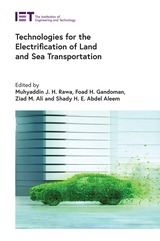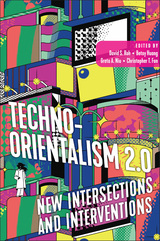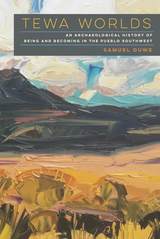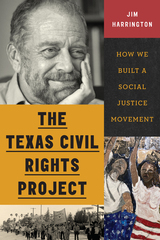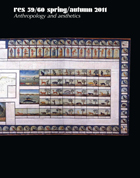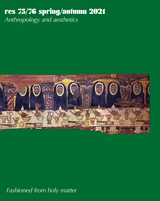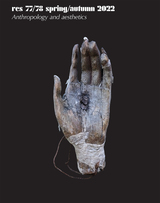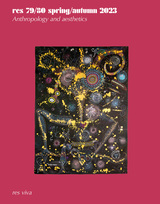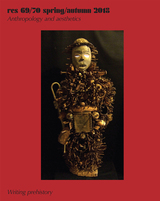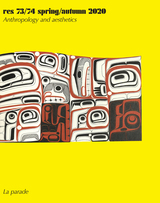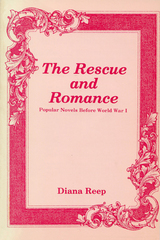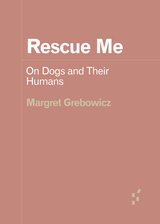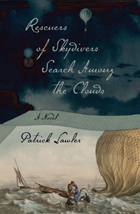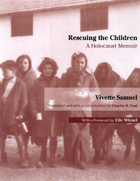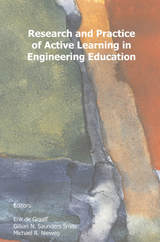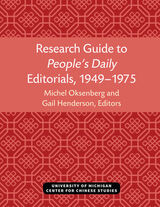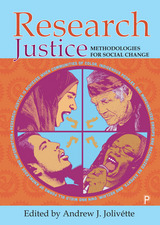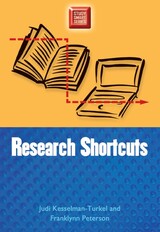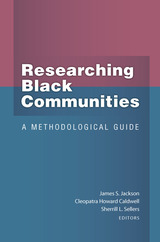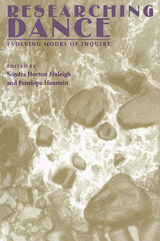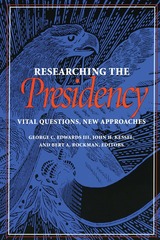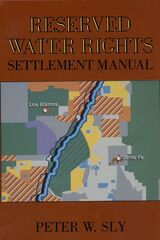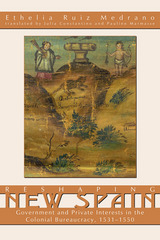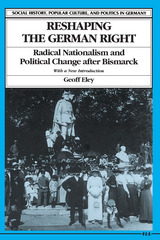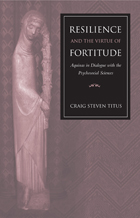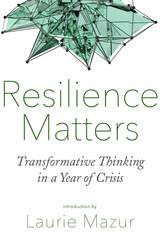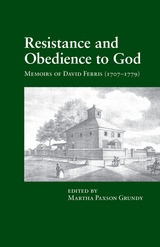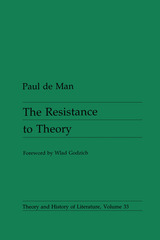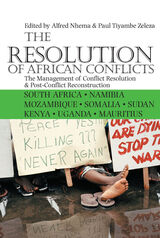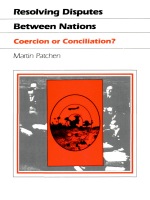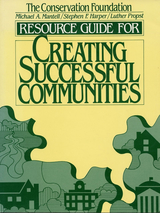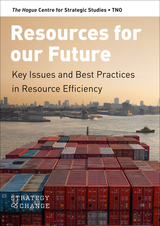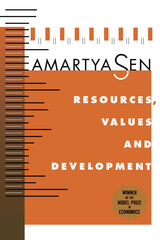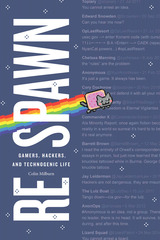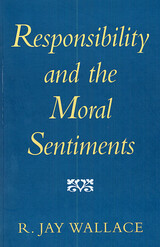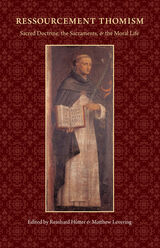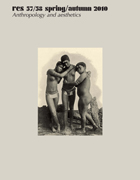 Res: Anthropology and Aesthetics, 57/58: Spring/Autumn 2010
Francesco Pellizzi
Harvard University Press, 2010 This double volume of the renowned international journal of anthropology and comparative aesthetics includes “Aesthetics’ non-recyclable ground” by Félix Duque; “Seeing through dead eyes” by Jonathan Hay; “The hidden aesthetic of red in the painted tombs of Oaxaca” by Diana Magaloni; “A consideration of the quatrefoil motif in Preclassic Mesoamerica” by Julia Guernsey; “Hunters, Sufis, soldiers, and minstrels” by Cynthia Becker; “Figures fidjiennes” by Marc Rochette; “A sacred landscape” by Rachel Kousser; “Military architecture as a political tool in the Renaissance” by Francesco Benelli; “The icon as performer and as performative utterance” by Marie Gasper-Hulvat; “Image and site” by Jas’ Elsner; “Untimely objects” by Ara H. Merjian; “Max Ernst in Arizona” by Samantha Kavky; “Form as revolt” by Sebastian Zeidler; “Embodiments and art beliefs” by Filippo Fimiani; “The theft of the goddess Amba Mata” by Deborah Stein; and contributions to “Lectures, Documents and Discussions” by Gottfried Semper, Spyros Papapetros, Erwin Panofsky, Megan R. Luke, Francesco Paolo Adorno, and Remo Guidieri.
Res: Anthropology and Aesthetics, 59/60: Spring/Autumn 2011
Francesco Pellizzi
Harvard University Press, 2011 RES 59/60 includes “The making of architectural types” by Joseph Rykwert; “Traces of the sun and Inka kinetics” by Tom Cummins and Bruce Mannheim; “Inka water management and display fountains” by Carolyn Dean; “Guaman Poma’s pictures of huacas” by Lisa Trever; “Peruvian nature up close” by Daniela Bleichmar; and other papers.
Res: Anthropology and Aesthetics, 6: Autumn 1983
Francesco Pellizzi
Harvard University Press Res is a journal of anthropology and comparative aesthetics dedicated to the study of the object, in particular cult and belief objects and objects of art. The journal presents contributions by philosophers, art historians, archaeologists, critics, linguists, architects, artists, and others. Its field of inquiry is open to all cultures, regions, and historical periods. Res also publishes iconographic and textual documents important to the history and theory of the arts.
Res appears twice yearly, in the spring and autumn. The journal is edited by Francesco Pellizzi. More information about Res is available at www.res-journal.org.
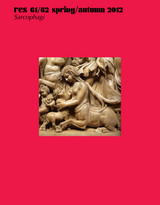 Res: Anthropology and Aesthetics, 61/62: Spring/Autumn 2012: Sarcophagi
Francesco Pellizzi
Harvard University Press, 2013 Res 61/62, Sarcophagi, is guest edited by Wu Hung and Jas Elsner. It includes “Chinese coffins from the first millennium b.c. and early images of the afterworld” by Alain Thote; “Art and personhood” by Björn Ewald; “Western Han sarcophagi and the transformation of Chinese funerary art” by Zheng Yan; “Reading identity on Roman strigillated sarcophagi” by Janet Huskinson; “‘A Tomb Both Great and Blameless’” by Richard Neer; “Funerary Spatiality” by Lillian Lan-ying Tseng; “‘Nero’s Tomb’ and the crisis of the third century” by Edmund Thomas; “Jouissance of death?” by Eugene Wang; “Reading images without texts on Roman sarcophagi” by Paul Zanker; “Decorative imperatives between concealment and display” by Jas Elsner; “Han sarcophagi” by Wu Hung; “Framing the dead on Roman sarcophagi” by Verity Platt; “Presentation, (re)animation, and the enchantments of technology” by Finbarr Barry Flood; “Death panels” by T. J. Clark; and contributions to Documents and Discussions by Andrew Scherer and Roberta Bonetti. Also included are contributions to Lectures—Color by Alexandre Tokovinine, Cameron L. McNeil, Timothy W. Pugh and Leslie G. Cecil, Leonardo Lopez Lujàn, Douglas K. Charles, and Warren R. DeBoer.
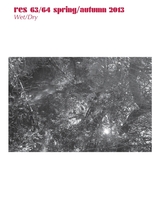 Res: Anthropology and Aesthetics, 63/64: Spring/Autumn 2013: Wet/Dry
Francesco Pellizzi
Harvard University Press, 2013 RES 63/64, Wet/Dry, includes "Source and trace" by Christopher S. Wood; "Climatic variability and pictorial oscillation" by Whitney Davis; "Timelessness, fluidity, and Apollo's libation" by Milette Gaifman; "A liquid history: Blood and animation in late medieval art" by Beate Fricke; "Drawing blood" by Anne Dunlop; "Guercino's 'wet' drawing" by Nicola Suthor; "Volcano equals head equals kiln equals phallus: Connecting Gauguin's metaphors of the creative act" by Dario Gamboni; "On sources: Mythical and historical thinking in fin-de-siècle Vienna" by Mario Wimmer; "A Neolithic childhood: Children's drawings as prehistoric sources" by Barbara Wittmann; "The form of the indistinct: Picasso and the rise of generic creativity" by Gabriele Guercio; "Source and trace in Walter Benjamin's thought: About a polarity" by Chiara Cappelletto; "Modern architecture and prehistory: Retracing The Eternal Present" by Spyros Papapetros; and "The readymade metabolized: Fluxus in life" by David Joselit. Contributors to Lectures, Documents, and Discussions include Remo Guidieri; Félix Duque; Marvin Trachtenberg; Frank Fehrenbach; Alexander Nemerov; Robert Smithson and Alexander Nagel; Francesco Pellizzi; Jörg Trempler; Aurélie Verdier; Anna Begicheva and Natasha Kurchanova; and D. Graham Burnett, Jac Mullen, and Sal Randolph.
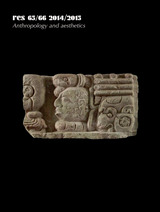 Res: Anthropology and Aesthetics, 65/66: 2014/2015
Francesco Pellizzi
Harvard University Press, 2015 This 35th anniversary issue includes Francesco Pellizzi, “Editorial: RES at 35”; Remo Bodei, “A constellation of words”; Stephen Houston, Barbara Fash, and David Stuart, “Masterful hands”; Mary Weismantel, “Encounters with dragons”; Guilhem Olivier, “Why give birth to enemies?”; Élodie Dupey García, “The materiality of color in the body ornamentation of Aztec gods”; Cristina Cruz González, “Crucifixion piety in New Mexico”; Duncan Caldwell, “A new ordering of Adena tablets based on a deeper reading of the McKensie Tablet”; Z. S. Strother, “A terrifying mimesis”; Wyatt MacGaffey, “Franchising minkisi in Loango”; Lisa Homann, “Alluring obscurity”; Clemente Marconi, “Pausanias and the figural decoration of Greek sacred architecture”; Bissera V. Pentcheva, “The aesthetics of landscape and icon at Sinai”; Paroma Chatterjee, “The gifts of the Gorgon”; Achim Timmermann, “Vain labor(?)”; Karen Overbey, “Seeing through stone”; Juan José Lahuerta, “The crucifixions of Velázquez and Zurbarán”; Noam Andrews, “The space of knowledge”; Katrin Seyler, “Heritage and artisanal empathy in the Republic of Tools”; Ines G. Županov, “The pulpit trap”; Edward Vazquez, “Antimatter”; Bret Rothstein, “Visual difficulty as a cultural system”; and contributions by Alessandra Russo, Éric Michaud, Maria H. Loh, and Ara H. Merjian; and the essay “Adieux aux armes,” by Remo Guidieri.
Res: Anthropology and Aesthetics, 7 & 8: Spring/Autumn 1984
Francesco Pellizzi
Harvard University Press Res is a journal of anthropology and comparative aesthetics dedicated to the study of the object, in particular cult and belief objects and objects of art. The journal presents contributions by philosophers, art historians, archaeologists, critics, linguists, architects, artists, and others. Its field of inquiry is open to all cultures, regions, and historical periods. Res also publishes iconographic and textual documents important to the history and theory of the arts.
Res appears twice yearly, in the spring and autumn. The journal is edited by Francesco Pellizzi. More information about Res is available at www.res-journal.org.
Res: Anthropology and Aesthetics, 9: Spring 1985
Francesco Pellizzi
Harvard University Press Res is a journal of anthropology and comparative aesthetics dedicated to the study of the object, in particular cult and belief objects and objects of art. The journal presents contributions by philosophers, art historians, archaeologists, critics, linguists, architects, artists, and others. Its field of inquiry is open to all cultures, regions, and historical periods. Res also publishes iconographic and textual documents important to the history and theory of the arts.
Res appears twice yearly, in the spring and autumn. The journal is edited by Francesco Pellizzi. More information about Res is available at www.res-journal.org.
Res: Anthropology and Aesthetics, volume 75-76 number 1 (2021)
The University of Chicago Press
University of Chicago Press Journals, 2021 This is volume 75-76 issue 1 of Res: Anthropology and Aesthetics. RES is a journal of anthropology and comparative aesthetics dedicated to the study of the object, in particular cult and belief objects and objects of art. The journal brings together, in an anthropological perspective, contributions by art historians, archaeologists, philosophers, critics, architects, artists, and others. Its field of inquiry is open to all cultures, regions, and historical periods. In addition, RES seeks to make available textual and iconographic documents of importance for the history and theory of the arts.
Res: Anthropology and Aesthetics, volume 77-78 number 1 (2022)
The University of Chicago Press
University of Chicago Press Journals, 2022 This is volume 77-78 issue 1 of Res: Anthropology and Aesthetics. RES is a journal of anthropology and comparative aesthetics dedicated to the study of the object, in particular cult and belief objects and objects of art. The journal brings together, in an anthropological perspective, contributions by art historians, archaeologists, philosophers, critics, architects, artists, and others. Its field of inquiry is open to all cultures, regions, and historical periods. In addition, RES seeks to make available textual and iconographic documents of importance for the history and theory of the arts.
Res: Anthropology and Aesthetics, volume 79-80 number 1 (2023)
The University of Chicago Press
University of Chicago Press Journals, 2023 This is volume 79-80 issue 1 of Res: Anthropology and Aesthetics. RES is a journal of anthropology and comparative aesthetics dedicated to the study of the object, in particular cult and belief objects and objects of art. The journal brings together, in an anthropological perspective, contributions by art historians, archaeologists, philosophers, critics, architects, artists, and others. Its field of inquiry is open to all cultures, regions, and historical periods. In addition, RES seeks to make available textual and iconographic documents of importance for the history and theory of the arts.
Res: Anthropology and Aesthetics, volume 81-82 number 1 (2024)
The University of Chicago Press
University of Chicago Press Journals, 2024 This is volume 81-82 issue 1 of Res: Anthropology and Aesthetics. RES is a journal of anthropology and comparative aesthetics dedicated to the study of the object, in particular cult and belief objects and objects of art. The journal brings together, in an anthropological perspective, contributions by art historians, archaeologists, philosophers, critics, architects, artists, and others. Its field of inquiry is open to all cultures, regions, and historical periods. In addition, RES seeks to make available textual and iconographic documents of importance for the history and theory of the arts.
Res: Anthropology and Aesthetics, volume 83 number 1 (2025)
The University of Chicago Press
University of Chicago Press Journals, 2025 This is volume 83 issue 1 of Res: Anthropology and Aesthetics. RES is a journal of anthropology and comparative aesthetics dedicated to the study of the object, in particular cult and belief objects and objects of art. The journal brings together, in an anthropological perspective, contributions by art historians, archaeologists, philosophers, critics, architects, artists, and others. Its field of inquiry is open to all cultures, regions, and historical periods. In addition, RES seeks to make available textual and iconographic documents of importance for the history and theory of the arts.
Res Publica
Alan Williamson
University of Chicago Press, 1998 Res Publica faithfully moves from the private to the public, from individual experience to civic responsibility through an elegy for the 1960s and the world that has become our own.
RES vol 67 num 1
The University of Chicago Press
University of Chicago Press Journals, 2017
 Rescue and Remembrance: Imagining the German Collective after Nazism
Kobi Kabalek
University of Wisconsin Press, 2025 In Rescue and Remembrance, Kobi Kabalek examines how the rescue of Jews during the Holocaust has been understood and represented in Germany from the Nazi period to the present. In many regions outside Germany, a small number of known Holocaust rescuers are often held up as exemplars of broad pro-Jewish sentiment among that country’s population during World War II, thereby projecting an image of national moral virtue. Within Germany, by contrast, rescuers are often presented in both scholarship and public commemoration as a small minority; their examples condemn the majority by showing what Germans could have done but did not do.
Kabalek argues that such simplistic depictions of the majority versus minority obscure the complex motivations and situations that led people in Nazi Germany to help persecuted Jews. Against the view that the rescuers were “forgotten” after the war, he shows that portrayals and interpretations of helping Jews appeared in various media and social discourses in East, West, and unified Germany and were used to actively debate questions of collective morality. Rescue and Remembrance analyzes the varied and changing depictions of rescue in the distinct German politics from the Nazi period, examining how the very notions of “majority” and “collective” were articulated and reformulated.
Rescue and Romance: Popular Novels Before World War I
Diana Reep
University of Wisconsin Press, 1982
This study of the rescue motif in popular American novels before World War I focuses on the rescue convention as part of the romantic plot of the novels. The rescue as a structured convention that controls the movement of the romantic plot appears in all types of domestic novels, gothics, dime novels, historical romances, and westerns.
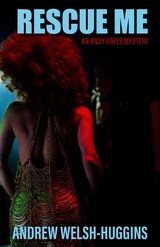 Rescue Me: An Andy Hayes Mystery
Andrew Welsh-Huggins
Ohio University Press Private eye Andy Hayes confronts his personal prejudices and assumptions when an unorthodox case comes his way. Tim Watkins is a young drag artist performing under the name Tiara Treatwell and facing online abuse and in-person stalking from anti-LGBTQIA crusaders. While Andy suspects the attacks are connected to a protest outside a drag story hour Tim attended weeks earlier in suburban Columbus, he has no direct evidence of a link. Tim’s concerns unfold against a groundswell of right-wing activism in the Ohio Statehouse, led by a failed state senate candidate who insists his opponent, a Somali American woman, stole the election. Bail bondsman Otto Mulligan—Tim’s cousin and Andy’s closest friend—persuades Tim it’s in his best interest to accept Andy as bodyguard and escort until they can figure out who is behind the threats. Tim, who is Black and queer, is reluctant to work with Andy, dismissing him as an insensitive and macho ex–football star. Andy doesn’t do himself any favors by acknowledging he’s never attended a drag performance or even bothered to learn anything about the culture. As Tim and Andy’s relationship is tested, Tim comes under attack by a pair of masked assailants, and only with the help of a concerned passerby does Andy manage to save both their lives. As Andy and the police search for clues to the assault, Andy follows a lead to an Ohio white supremacist group called the Promise Lords, which orchestrated the protest at the drag story hour. Andy enlists an old ally, Ronald J. McQuillen, a freelance analyst who helps law enforcement track and prosecute hate groups. Meanwhile, Andy’s investigation leads to conflict with Henrietta Millner, a nightside Columbus police detective who’s not happy to have Andy on her turf. Caught in the middle of this skirmish is Andy’s grown daughter, Alex Rutledge, who’s training to be a Columbus police officer. Andy and Henrietta’s uneasy partnership deteriorates when Andy, spurred by a cryptic comment from Alex, questions why a veteran investigator like Millner is stuck on the night shift. As Andy’s search for the identity of Tim’s stalkers ramps up, increasingly bizarre clues emerge that may have connections to a broader plot. With time running out, Andy must put the pieces together to save Tim, and many others, from a violent and potentially deadly confrontation.
Rescue Me: On Dogs and Their Humans
Margret Grebowicz
University of Minnesota Press, 2022 What exactly is it we want from dogs today?
This is a little book about the oldest relationship we humans have cultivated with another large animal—in something like the original interspecies space, as old or older than any other practice that might be called human. But it’s also about the role of this relationship in the attrition of life—especially social life—in late capitalism. As we become more and more obsessed with imagining ourselves as benevolent rescuers of dogs, it is increasingly clear that it is dogs who are rescuing us. But from what? And toward what? Exploring adoption, work, food, and training, this book considers the social as fundamentally more-than-human and argues that the future belongs to dogs—and the humans they are pulling along.
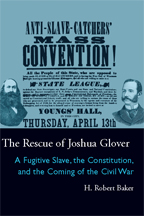 The Rescue of Joshua Glover: A Fugitive Slave, the Constitution, and the Coming of the Civil War
H. Robert Baker
Ohio University Press, 2006 On March 11, 1854, the people of Wisconsin prevented agents of the federal government from carrying away the fugitive slave, Joshua Glover. Assembling in mass outside the Milwaukee courthouse, they demanded that the federal officers respect his civil liberties as they would those of any other citizen of the state. When the officers refused, the crowd took matters into its own hands and rescued Joshua Glover. The federal government brought his rescuers to trial, but the Wisconsin Supreme Court intervened and took the bold step of ruling the Fugitive Slave Act unconstitutional. The Rescue of Joshua Glover delves into the courtroom trials, political battles, and cultural equivocation precipitated by Joshua Glover’s brief, but enormously important, appearance in Wisconsin on the eve of the Civil War. H. Robert Baker articulates the many ways in which this case evoked powerful emotions in antebellum America, just as the stage adaptation of Uncle Tom’s Cabin was touring the country and stirring antislavery sentiments. Terribly conflicted about race, Americans struggled mightily with a revolutionary heritage that sanctified liberty but also brooked compromise with slavery. Nevertheless, as The Rescue of Joshua Glover demonstrates, they maintained the principle that the people themselves were the last defenders of constitutional liberty, even as Glover’s rescue raised troubling questions about citizenship and the place of free blacks in America.
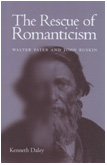 The Rescue of Romanticism: Walter Pater and John Ruskin
Kenneth Daley
Ohio University Press, 2001 Valuable and timely in its long historical and critical perspective on the legacy of romanticism to Victorian art and thought, The Rescue of Romanticism is the first book-length study of the close intellectual relationship between Walter Pater and John Ruskin, the two most important Victorian critics of art. Kenneth Daley explores the work and thought of both writers in context with other Victorian writers, and enlarges the issues at stake between them, connecting these issues to ongoing artistic, cultural, and political concerns of the modern world. Professor Daley gives a more finely honed picture than ever before of romanticism’s emergence as a literary concept in Victorian England, detailing the political differences that characterize the opposition between John Ruskin and his younger contemporary, Walter Pater, over the nature of romanticism. Individual chapters reassess the Victorian reception of such romantic figures as Wordsworth, Dante Gabriel Rossetti, Leonardo, and Michelangelo. Daley demonstrates how Pater’s “modern” reading of romanticism emerged from Ruskin’s distrust of romanticism and from Ruskin’s arguments and examples defining pathetic fallacy. His discussion of Ruskin’s Oxford lectures and their timing in Pater’s developing career refresh the intersections of the two bodies of work and the portrait of the Victorian period in general.
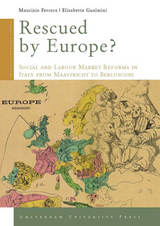 Rescued by Europe?: Social and Labour Market Reforms in Italy from Maastricht to Berlusconi
Maurizio Ferrera and Elisabetta Gualmini
Amsterdam University Press, 2004 As a result of its political and economic turmoil for much of the postwar period, Italy was considered the "bad seed" in the European community. Harsh ideological divisions, chronic executive instability, inefficient bureaucracy, uneven socio-economic development, organized crime, and unbalanced public finances all contributed to this negative perception of the nation. Yet a massive economic and social overhaul was launched in the 1990s as part of Italy's efforts to meet the famous Maastricht requirements in order to join the Economic and Monetary Union (EMU).
This book examines the processes Italy underwent to become part of the integrated European community and skillfully analyzes the consequences of the "Maastricht process" by exploring the effect it had on governmental and social actions and modes of orientation. Rescued by Europe? offers sharp insights into the importance of welfare state reform to current Berlusconi government, and how the weakening of the European Union's constraints has renewed the resistance to further changes. Ferrera and Gualmini ultimately argue that the constraints and opportunities linked to European integration have been the driving forces behind Italy's positive expansions, yet even with these reforms, there is still a long road ahead for European integration and Italy's political future.
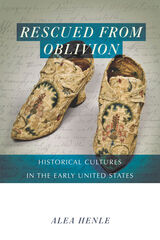 Rescued from Oblivion: Historical Cultures in the Early United States
Alea Henle
University of Massachusetts Press, 2020 In 1791, a group of elite Bostonian men established the first historical society in the nation. Within sixty years, the number of local history organizations had increased exponentially, with states and territories from Maine to Louisiana and Georgia to Minnesota boasting collections of their own.
With in-depth research and an expansive scope, Rescued from Oblivion offers a vital account of the formation of historical culture and consciousness in the early United States, re-centering in the record groups long marginalized from the national memory. As Alea Henle demonstrates, these societies laid the groundwork for professional practices that are still embraced today: collection policies, distinctions between preservation of textual and nontextual artifacts, publication programs, historical rituals and commemorations, reconciliation of scholarly and popular approaches, and more. At the same time, officers of these early societies faced challenges to their historical authority from communities interested in preserving a broader range of materials and documenting more inclusive histories, including fellow members, popular historians, white women, and peoples of color.
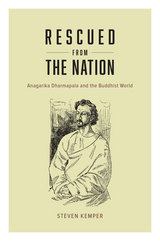 Rescued from the Nation: Anagarika Dharmapala and the Buddhist World
Steven Kemper
University of Chicago Press, 2014 Anagarika Dharmapala is one of the most galvanizing figures in Sri Lanka’s recent turbulent history. He is widely regarded as the nationalist hero who saved the Sinhala people from cultural collapse and whose “protestant” reformation of Buddhism drove monks toward increased political involvement and ethnic confrontation. Yet as tied to Sri Lankan nationalism as Dharmapala is in popular memory, he spent the vast majority of his life abroad, engaging other concerns. In Rescued from the Nation, Steven Kemper reevaluates this important figure in the light of an unprecedented number of his writings, ones that paint a picture not of a nationalist zealot but of a spiritual seeker earnest in his pursuit of salvation.
Drawing on huge stores of source materials—nearly one hundred diaries and notebooks—Kemper reconfigures Dharmapala as a world-renouncer first and a political activist second. Following Dharmapala on his travels between East Asia, South Asia, Europe, and the United States, he traces his lifelong project of creating a unified Buddhist world, recovering the place of the Buddha’s Enlightenment, and imitating the Buddha’s life course. The result is a needed corrective to Dharmapala’s embattled legacy, one that resituates Sri Lanka’s political awakening within the religious one that was Dharmapala’s life project.
Rescuers of Skydivers Search Among the Clouds: A Novel
Patrick Lawler
University of Alabama Press, 2012 Winner of the 2013 CNY Book Award for Fiction.
When you step inside Patrick Lawler’s Rescuers of Skydivers Search Among the Clouds, you will find yourself hovering in the clouds, among a family and a town, and in the world of one of fiction’s most inventive writers. Patrick Lawler’s novel is about resonance, echoes, and naming; about hiding inside of names; about standing completely still; and about the fractalization of family. Connect the dots. Connect the secrets. Mother. Father. Sisters. Brother. Every character wears a variety of masks, and every place is also someplace else. Rescuers of Skydivers Search Among the Clouds is a reconfiguring of narrative—how stories exist inside stories, how place exists inside self, how self exists inside others, and how parachutists exist inside clouds.
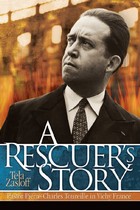 A Rescuer's Story: Pastor Pierre-Charles Toureille in Vichy France
Tela Zasloff
University of Wisconsin Press, 2014 This is the story of a Holocaust rescuer, Pierre Toureille, a French Protestant pastor whose efforts resulted in the rescue of hundreds of refugees, most of them Jewish. Inspired by his Huguenot heritage, Pastor Toureille participated in international Protestant church efforts to combat Nazism during the 1930s and headed a major refugee aid organization in Vichy France during World War II. After the war, Pastor Toureille was honored by the Jewish organization Yad Vashem as one of the "Righteous Among the Nations."
In telling Toureille’s story, Tela Zasloff also depicts the wide-ranging network of Protestant pastors and lay people in southern French villages who participated in an aggressive rescue effort. She delves into their motivations, including their heritage as members of a religious minority. Toureille’s rescue work under the Vichy regime, partly official and then increasingly clandestine as the war progrressed. was a crucial part of the French non-violent "spiritual resistance" against Nazism.
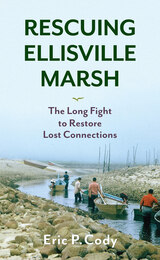 Rescuing Ellisville Marsh: The Long Fight to Restore Lost Connections
Eric P. Cody
University of Massachusetts Press, 2023 For hundreds of years, farmers and fishing communities maintained the inlet to Ellisville Marsh, a picturesque piece of coastline ten miles south of Plymouth, Massachusetts. Recognized as one of the most environmentally sensitive and ecologically valuable places in the state, the salt marsh and estuary are home to a diverse array of wildlife and a range of habitats, including low-tide mudflats, a saltwater pond, intertidal zone, and fields of tall marsh grass. After agricultural and fishing activities faded away in the late twentieth century, it soon became apparent that protecting the marsh and its surroundings from development would not be enough to restore the natural equilibrium that had been lost when the inlet became blocked. Having witnessed government inaction over the years, Eric P. Cody and four other locals founded the Friends of Ellisville Marsh in 2007 to address erosion, revive tidal flows, and revitalize fisheries and wildlife in the face of climate change. Rescuing Ellisville Marsh presents the powerful case study of backyard activism, telling the story of a community that bonded with a natural place and decided to fight for it.
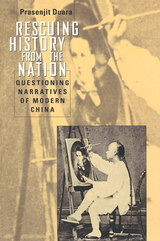 Rescuing History from the Nation: Questioning Narratives of Modern China
Prasenjit Duara
University of Chicago Press, 1995 Prasenjit Duara offers the first systematic account of the relationship between the nation-state, nationalism, and the concept of linear history. Focusing primarily on China and including discussion of India, Duara argues that many historians of postcolonial nation-states have adopted a linear, evolutionary history of the Enlightenment/colonial model. As a result, they have written repressive, exclusionary, and incomplete accounts.
The backlash against such histories has resulted in a tendency to view the past as largely constructed, imagined, or invented. In this book, Duara offers a way out of the impasse between constructionism and the evolving nation; he redefines history as a series of multiple, often conflicting narratives produced simultaneously at national, local, and transnational levels. In a series of closely linked case studies, he considers such examples as the very different histories produced by Chinese nationalist reformers and partisans of popular religions, the conflicting narratives of statist nationalists and of advocates of federalism in early twentieth-century China. He demonstrates the necessity of incorporating contestation, appropriation, repression, and the return of the repressed subject into any account of the past that will be meaningful to the present. Duara demonstrates how to write histories that resist being pressed into the service of the national subject in its progress—or stalled progress—toward modernity.
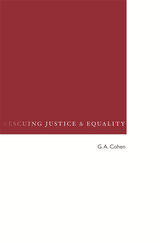 Rescuing Justice and Equality
G. A. Cohen
Harvard University Press, 2008 In this stimulating work of political philosophy, acclaimed philosopher G. A. Cohen sets out to rescue the egalitarian thesis that in a society in which distributive justice prevails, people’s material prospects are roughly equal. Arguing against the Rawlsian version of a just society, Cohen demonstrates that distributive justice does not tolerate deep inequality.
In the course of providing a deep and sophisticated critique of Rawls’s theory of justice, Cohen demonstrates that questions of distributive justice arise not only for the state but also for people in their daily lives. The right rules for the macro scale of public institutions and policies also apply, with suitable adjustments, to the micro level of individual decision-making.
Cohen also charges Rawls’s constructivism with systematically conflating the concept of justice with other concepts. Within the Rawlsian architectonic, justice is not distinguished either from other values or from optimal rules of social regulation. The elimination of those conflations brings justice closer to equality.
Rescuing the Children: A Holocaust Memoir
Vivette Samuel; Translated and with an introduction by Charles B. Paul; With a foreword by Elie Wiesel
University of Wisconsin Press, 2002 Rescuing the Children is the memoir of Vivette Samuel, who at age twenty-two began working for the Œuvre de secours aux enfants (OSE, or Society for Assistance to Children). The OSE and similar organizations saved 86 percent of Jewish children in France from deportation to Nazi concentration and extermination camps.
 Rescuing the Enlightenment from the Europeans: Critical Theories of Decolonization
Nikita Dhawan
Duke University Press, 2026 In Rescuing the Enlightenment from the Europeans, Nikita Dhawan puts the critical project of decolonization into conversation with the Enlightenment. She explores the ethical-political challenges faced by postcolonial thought, which must be articulated using the very language of Enlightenment discourses on human rights, democracy, international law, sovereignty, and justice—even as these norms are subjects of postcolonial critique. Bridging postcolonial and Holocaust studies, while also highlighting the differences from decolonial approaches, she engages with thinkers ranging from Kant to the Frankfurt school to defend against accusations of normative nihilism, antisemitism, and epistemic servitude to Europe. Dhawan argues that criticizing the Enlightenment and its legacies does not necessarily entail rejecting them, nor does engaging with Enlightenment principles mean endorsing them unconditionally. Instead, she makes a case for rescuing the best aspects of the Enlightenment in order to further the critical project of decolonization.
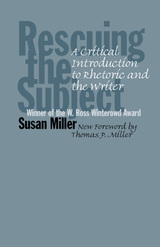 Rescuing the Subject, 2nd Edition: A Critical Introduction to Rhetoric and the Writer
Susan Miller. Foreword by Thomas P. Miller
Southern Illinois University Press, 2004 When it was first published in 1989, Susan Miller’s Rescuing the Subject: A Critical Introduction to Rhetoric and the Writer established a landmark pedagogical approach to composition based on the importance of the writer and the act of writing in the history of rhetoric. Widely used as an introduction to rhetoric and composition theory for graduate students, the volume was the first winner of the W. Ross Winterowd Award from JAC and is still one of the most frequently cited books in the field. This first paperback edition includes a new introductory chapter in which Miller addresses changes in the field since the first edition, outlines new research, and surveys positions she no longer supports. A new foreword by Thomas P. Miller assesses the proven impact of Rescuing the Subject on the field of rhetoric and composition. Situating modern composition theory in the historical context of rhetoric, Miller notes that throughout the eighteenth century, rhetoric referred to oral, not written, discourse. By contrast, her history of rhetoric contends oral and written discourse were related from the beginning. Taking a thematic rather than chronological approach, she shows how actual acts of writing comment on both rhetoric and composition. Miller also asserts that contemporary composition study is the necessary cultural outcome of changing conditions for producing discourse, describing the history of rhetoric as the gradual and unstable relocation of discourse in conventions that only written language can create. She maintains teachers and historians of rhetoric must recognize that the contemporary writing they analyze and teach demands their attention to a “textual rhetoric” that allows theorizing the writer as always symbolically a student of situated meanings.
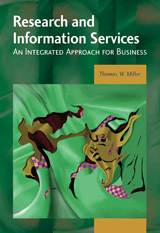 Research and Information Services: An Integrated Approach for Business
Miller, Thomas W.
Research Publishers, 2008 What could be more important to a business than understanding its customers, competitors, and markets? Managers need a coherent view of these things.
With consumer research, product management, competitive intelligence, customer support, and management information systems housed within separate departments, managers struggle to find the information they need. Integration of research and information services makes more sense.
This book is about business strategy. It argues for an integrated, strategic approach to information. It draws upon economic research, provider and client surveys, and in-depth interviews with over forty information experts. It provides insights about the nature of research and the demand for information. With discussion of information product positioning and pricing, as well as technology trends, it represents a critical resource for buyers and sellers of research and information services.
Research and Practice of Active Learning in Engineering Education
Erik de Graaf, Gillian Saunders-Smits, and Michael Nieweg
Amsterdam University Press, 2005 Since 2001, the international network Active Learning in Engineering education (ALE) organized a series of international workshops on innovation of engineering education. The papers in this book are selected to reflect the state of the art, based on contributions to the 2005 ALE workshop in Holland. This overview of experiences in research and practice aims to be a source of inspiration for engineering educators. This title can be previewed in Google Books - http://books.google.com/books?vid=ISBN9789085550914.
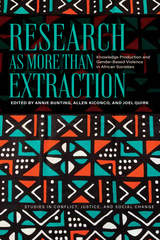 Research as More Than Extraction: Knowledge Production and Gender-Based Violence in African Societies
Annie Bunting, Allen Kiconco, Joel Quirk
Ohio University Press, 2023 This volume offers practical, detailed guidance and case studies on how to avoid exacerbating inequalities while researching gender-based violence and other related issues in Africa. Wartime violence and its aftermath present numerous practical, ethical, and political challenges that are especially acute for researchers working on gender-based and sexual violence. Drawing upon applied examples from across the African continent, this volume features unique contributions from researchers and practitioners with decades of experience developing research partnerships, designing and undertaking fieldwork, asking sensitive questions, negotiating access, collecting and evaluating information, and validating results. These are all endeavors that also raise pressing ethical questions, especially in relation to retraumatization, social stigma, and even payment of participants. Ethical and methodological questions cannot be separated from political and institutional considerations. Systems of privilege and marginalization cannot be wished away, so they need to be both interrogated and contested. This is where precedents and power relations established under colonialism and imperialism take center stage. Europeans have been extracting valuable resources from the African continent for centuries. Research into gender-based violence risks being yet another extractive industry. There are times when committed individuals can make valuable contributions to a more equitable future, but funding streams, knowledge hierarchies, and institutional positions continue to have powerful effects. Accordingly, the contributors to this volume also concentrate upon the layered effects of power and position, relationships between researchers, organizations, and communities, and the political economy of knowledge production; this brings into focus questions about how and why information gets generated, for which kinds of audiences, and for whose benefit.
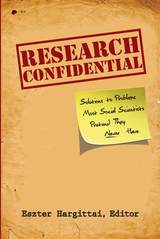 Research Confidential: Solutions to Problems Most Social Scientists Pretend They Never Have
Eszter Hargittai
University of Michigan Press, 2009 "We all know that the actual process of empirical research is a messy, complicated business that at best only approximates the models we impart to students. Research Confidential pulls back the curtain on this process, laying bare the sordid details of the research process, but doing so in a way that respects the ideals of social research and that provides useful lessons for young scholars. It should be required reading for our research methods courses."
---Michael X. Delli Carpini, Dean, Annenberg School for Communication, University of Pennsylvania "In this impressive volume, some of the brightest young lights in social research have taken us backstage to share what they learned from their innovative projects. Besides providing a wealth of help with methodological concerns, the book includes theoretical and career issues to consider when doing research. Anyone doing research should benefit from reading it."
---Caroline Hodges Persell, Professor of Sociology, New York University "Research Confidential complements existing methods literature by providing refreshingly honest accounts of key challenges and decision forks-in-the-research-road. Each chapter enlightens and entertains."
---Kirsten Foot, Associate Professor of Communication, University of Washington "A must-read for researchers embarking on new projects. Rather than the abstract descriptions of most methods textbooks, this volume provides rich accounts of the firsthand experiences of actual researchers. An invaluable resource of practical advice. Critically, it will make new researchers aware of the actual challenges that they are likely to face in their work."
---Christopher Winship, editor of Sociological Methods and Research and Professor of Sociology, Harvard University This collection of essays aims to fill a notable gap in the existing literature on research methods in the social sciences. While the methods literature is extensive, rarely do authors discuss the practical issues and challenges they routinely confront in the course of their research projects. As a result, editor Eszter Hargittai argues, each new cohort is forced to reinvent the wheel, making mistakes that previous generations have already confronted and resolved. Research Confidential seeks to address this failing by supplying new researchers with the kind of detailed practical information that can make or break a given project. Written in an informal, accessible, and engaging manner by a group of prominent young scholars, many of whom are involved in groundbreaking research in online contexts, this collection promises to be a valuable tool for graduate students and educators across the social sciences. Eszter Hargittai is Associate Professor of Communication Studies at Northwestern University and Fellow at the Berkman Center for Internet & Society at Harvard University. Cover art courtesy of Dustin Gerard
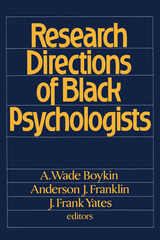 Research Directions of Black Psychologists
Wade Boykin
Russell Sage Foundation, 1979 Focusing on issues of particular importance to black people, and confronting the rich variety and the complexity of the black experience, the many contributors demonstrate the broad diversity of research interests and strategies among black psychologists, from the traditional to the innovative. Topics covered include studies of motivation, cognitive development, life-span development, and cultural difference versus deficit theories. Many of the studies directly refute previous conceptions of the psychological functioning of blacks and offer alternative models and formulations. This book is the first to present soundly designed and executed research that is emphatically linked to the perspectives and the psychological concerns of black Americans. In designing these studies, the authors aimed to ameliorate the pressing educational and social problems of blacks through a better understanding of their life conditions.
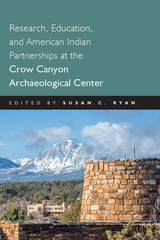 Research, Education and American Indian Partnerships at the Crow Canyon Archaeological Center
Susan C. Ryan
University Press of Colorado, 2024 This volume celebrates and examines the Crow Canyon Archaeological Center’s past, present, and future by providing a backdrop for the not-for-profit’s beginnings and highlighting key accomplishments in research, education, and American Indian initiatives over the past four decades. Specific themes include Crow Canyon’s contributions to projects focused on community and regional settlement patterns, human-environment relationships, public education pedagogy, and collaborative partnerships with Indigenous communities. Contributing authors, deeply familiar with the center and its surrounding central Mesa Verde region, include Crow Canyon researchers, educators, and Indigenous scholars inspired by the organization’s mission to further develop and share knowledge of the human past for the betterment of societies.
Research, Education, and American Indian Partnerships at the Crow Canyon Archaeological Center guides Southwestern archaeology and public education beyond current practices—particularly regarding Indigenous partnerships—and provides a strategic handbook for readers into and through the mid-twenty-first century.
Open access edition supported by the Crow Canyon Archaeological Center King Family Fund and subvention supported in part by the Crow Canyon Archaeological Center and the Arizona Archaeological and Historical Society.
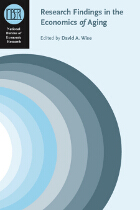 Research Findings in the Economics of Aging
Edited by David A. Wise
University of Chicago Press, 2010 The baby boom generation's entry into old age has led to an unprecedented increase in the elderly population. The social and economic effects of this shift are significant, and in Research Findings in the Economics of Aging, a group of leading researchers takes an eclectic view of the subject. Among the broad topics discussed are work and retirement behavior, disability, and their relationship to the structure of retirement and disability policies.
While choices about when to retire are made by individuals, these decisions are influenced by a set of incentives, including retirement benefits and health care, and this volume includes cross-national analyses of the effects of such programs on these decisions. Furthermore, the volume also offers in-depth analysis of the effects of retirement plans, employer contributions, and housing prices on retirement. It explores well-established relationships among economic circumstances, health, and mortality, as well as the effects of poverty and lower levels of economic development on health and life satisfaction. By combining micro and macro evidence, this volume continues a tradition of expanding the research agenda on the economics of aging.
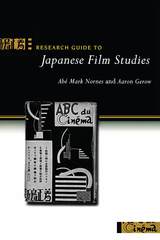 Research Guide to Japanese Film Studies
Abé Mark Nornes and Aaron Gerow
University of Michigan Press, 2009 The Research Guide to Japanese Film Studies provides a snapshot of all the archival and bibliographic resources available to students and scholars of Japanese cinema. Among the nations of the world, Japan has enjoyed an impressively lively print culture related to cinema. The first film books and periodicals appeared shortly after the birth of cinema, proliferating wildly in the 1910s with only the slightest pause in the dark days of World War II. The numbers of publications match the enormous scale of film production, but with the lack of support for film studies in Japan, much of it remains as uncharted territory, with few maps to negotiate the maze of material. This book is the first comprehensive guide ever published for approaching the complex archive for Japanese cinema. It lists all the libraries and film archives in the world with significant collections of film prints, still photographs, archival records, books, and periodicals. It provides a full annotated bibliography of the core books and magazines for the field. And it supplies hints for how to find and access materials for any research project. Above and beyond that, Nornes and Gerow’s Research Guide to Japanese Film Studies constitutes a comprehensive overview of the impressive dimensions and depth of the print culture surrounding Japanese film, and a guideline for future research in the field. This is an essential book for anyone seriously thinking about Japan and its cinema.
Research Guide to People’s Daily Editorials, 1949–1975
Michel Oksenberg and Gail Henderson, Editors
University of Michigan Press, 1982 An indispensable aid to researching a crucial series of policy statements, the present guide provides access to the only continuous source from China which illuminates high-level policy. Includes an extensive subject index.
 Research in Art and Design Education: Issues and Exemplars
Edited by Richard Hickman
Intellect Books, 2008 Although educators are increasingly interested in art education research, there are few anthologies tackling the subject. Research in Art and Design Education answers this call, summarizing important issues in the field such as non-text based approaches and interdisciplinary work. Contributions from internationally renowned researchers explore a broad range of topics in art education, highlighting particular problems and strengths in the literature. An indispensable and engaging resource, this volume provides a long-awaited aid for students and teachers alike. “Research in Art & Design Education confirms Picasso’s claim that artists do not seek, but find; thus capturing the real meaning of art’s doing and how in doing art, we learn. From their respective positions, this book’s contributors converge in making a strong case for art and design research as a horizon of specificities; as a wide and ever-expanding ground of autonomous plurality; and as a discipline that is neither restricted to the empire of fact and measure, nor to generalist platitudes. Under Richard Hickman’s careful editorship, this book boldly makes the case that research in art and design education is not a subject-in-waiting and less so an affair restricted to arcane practices. Rather, it is a discipline invested in the exciting prospects of art’s humanity and the design by which humans work together for a better world.”—John Baldacchino, Columbia University
 Research in Global Learning: Methodologies for Global Citizenship and Sustainable Development Education
Edited by Douglas Bourn
University College London, 2023 A diverse collection of global educational research.
Young people around the world are calling ever more urgently on policymakers to address today’s global challenges of sustainability, structural inequality, and social justice. It is little surprise that learning in a global society, understanding sustainable development, and being active global citizens are increasingly popular themes for education at all levels. Educational research makes a crucial contribution to knowledge that can address the great questions of our time, and evidence from a diversity of studies is vital if we are to build a clear picture. Research in Global Learning showcases methods and findings from a range of early career researchers who conducted illuminating studies located around the globe, specifically Brazil, China, Ghana, Greece, Israel, Jamaica, Japan, Kazakhstan, Pakistan, Poland, South Korea, Trinidad and Tobago, Turkey, the United States, and the United Kingdom.
Flexibility of approach is key to successful educational research in differing contexts. The studies in this volume use a range of approaches to investigate four important themes: the relationship between policy and practice, opportunities and constraints within the education system and the role of teachers, challenges and opportunities for higher education, and the perspectives of young people and students. Case studies, quantitative and qualitative research, participatory action research, longitudinal studies, and analysis of textbooks through critical discourse analysis are all used to demonstrate how learning about global citizenship and sustainability can inspire learners and contribute to quality education.
 Research Interviewing: Context and Narrative
Elliot G. Mishler
Harvard University Press, 1986 Interviews hold a prominent place among the various research methods in the social and behavioral sciences. This book presents a powerful critique of current views and techniques, and proposes a new approach to interviewing. At the heart of Elliot Mishler’s argument is the notion that an interview is a type of discourse, a speech event: it is a joint product, shaped and organized by asking and answering questions.
This view may seem self-evident, yet it does not guide most interview research. In the mainstream tradition, the discourse is suppressed. Questions and answers are regarded as analogues to stimuli and responses rather than as forms of speech; questions and the interviewer’s behavior are standardized so that all respondents will receive the same “stimulus”; respondents’ social and personal contexts of meaning are ignored. While many researchers now recognize that context must be taken into account, the question of how to do so effectively has not been resolved. This important book illustrates how to implement practical alternatives to standard interviewing methods.
Drawing on current work in sociolinguistics as well as on his own extensive experience conducting interviews, Mishler shows how interviews can be analyzed and interpreted as narrative accounts. He places interviewing in a sociocultural context and examines the effects on respondents of different types of interviewing practice. The respondents themselves, he believes, should be granted a more extensive role as participants and collaborators in the research process.
The book is an elegant work of synthesis—clearly and persuasively written, and supported by concrete examples of both standard interviewing and alternative methods. It will be of interest to both scholars and clinicians in all the various fields for which the interview is an essential tool.
Research Justice: Methodologies for Social Change
Edited by Andrew J. Jolivette
Bristol University Press, 2015 Challenging traditional models for conducting social science research within marginalized populations, “research justice” is a strategic framework and methodological intervention that aims to transform structural inequalities in research. This book is the first to offer a close analysis of that framework and present a radical approach to socially just, community-centered research. It is built around a vision of equal political power and legitimacy for different forms of knowledge, including the cultural, spiritual, and experiential, with the goal of greater equality in public policies and laws that rely on data and research to produce social change.
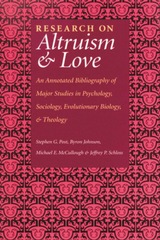 Research On Altruism & Love: An Annotated Bibliography of Major Studies in Psychology, Sociology, Evolutionary Biology, and Theology
Stephen Post
Templeton Press, 2003 Research on Altruism and Love is a compendium of annotated bibliographies reviewing literature and research studies on the nature of love. An essay introduces each of the annotated bibliographies. A variety of literature directly related to science-and-love issues or supporting those issues is covered in the Religious Love Interfaces with Science section. This annotated bibliography is unique in that it approaches the field from a decidedly religious perspective. It includes classical expositions of love that continue to influence contemporary scholars, including Platos' work on eros, the work and words of Jesus, Aristotle, Augustine of Hippo, Martin Luther, Kierkegaard, and Ghandi, among others. The contemporary discussion includes Anders Nygren's theological arguments in his classic, Agape and Eros; Pitirim Sorokin; and others. An issue that often emerges in this literature is the question of the nature and definition of love. A second annotated bibliography features current empirical research in the field of Personality and Altruism, with a focus on social psychology. Among the topics covered are the altruistic personality, altruistic behavior, empathy, helping behavior, social responsibility, and volunteerism. Methodologies are diverse, and studies include experiments, local and national surveys, naturalistic observation, and combinations of these. The Evolutionary Biology annotated bibliography covers the most significant works on altruism and love in the field of biology and evolutionary psychology. The fourth and final annotated bibliography in this volume is entitled Sociology of Faith-Based Volunteerism. Here the focus is on literature on the interface of helping behavior and religious organizations, as well as major pieces on voluntary associations.
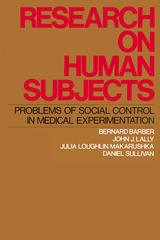 Research on Human Subjects: Problems of Social Control in Medical Experimentation
Bernard Barber
Russell Sage Foundation, 1973 How are human subjects treated in biomedical research? What are the expressed standards and self-reported behavior of biomedical researchers in regard to what has sometimes been called their "animal of necessity"? What are some of the determinants of the "strict" and "permissive" patterns which describe the standards and behavior of biomedical researchers? These are the important questions asked and answered in Research on Human Subjects. It is a book based on four years of intensive research. Two studies were completed, one on a nationally representative sample of biomedical research institutions, a second on a sample of 350 researchers who actually use human subjects. In their chapters on "the dilemma of science and therapy," the authors look at the tension between the values of humane therapy and discovery in science. They show that the significant minority of researchers who are "permissive" on the issues of informed consent and a favorable risk-benefit ratio are more likely to be those who are "relative failures" in pursuing the science value. Research on Human Subjects also documents the inadequate training that biomedical researchers get in the ethics of research on human subjects not only in medical schools but in their postgraduate training as well. The medical schools pay relatively more attention to the scientific training of their students than they do to the ethical training that should be its essential complement. The local peer review groups that screen research on human subjects in the institutions where it is carried on are another central focus of attention of the research and analysis reported in this book. The peer review groups do a fairly good job but, the authors show, there are various conditions of their relative efficacy which are not met by review groups in many important research institutions. The medical school review groups, for example, have not been outstanding performers with respect to the several conditions of relative efficacy. In the concluding chapter, the authors discuss the general problem of the social responsibilities of powerful professions and make very specific suggestions for policy change and reform for the biomedical research profession and its use of human subjects.
Research Shortcuts
Judi Kesselman-Turkel and Franklynn Peterson
University of Wisconsin Press, 2003 There are proper ways to research a paper...and there are the ways most students do it: laboriously, tediously, and inefficiently. Here are the techniques and shortcuts that the pros use. They will enable students to find their way to the best resources for their own projects.
From preparing the preliminary outline, work file, and bibiliography, Research Shortcuts proceeds to using the appropriate resource guides, as well as modern aids to research. It also discusses shortcuts that reach the experts: writing letters that get questions answered, and making face-to-face (or telephone) interviews pay off.
A final section is devoted to using the research data: first drafts, choosing specific quotes wisely, paraphrasing, and final drafts.
Research-based Theatre: An Artistic Methodology
Edited by George Belliveau and Graham W. Lea
Intellect Books, 2016 Research-based theater aims to present research in a way that is compelling and captivating, connecting with viewers on imaginative and intellectual levels at the same time. Research-Based Theatre brings together scholars and practitioners of research-based theater to construct a theoretical analysis of the field and offer critical reflections on how the methodology can now be applied. The book shares twelve examples of contemporary research-based theater scripts and commentaries from an international group of artists and researchers, selected with an eye toward representing different approaches that come from a variety of disciplinary areas.
 Researches Into the Physical History of Man
James Cowles Prichard
University of Chicago Press, 1973 Originally published in 1813, James Cowles Prichard's Researches into the Physical History of Man was perhaps the most important anthropological work in English of the pre-Darwinian nineteenth century. Attacking the heterodox speculations of "polygenist" writers, Prichard defended the biblically based argument that all mankind was one species. He advanced interesting hypotheses concerning the processes of racial differentiation, and suggested the then daring possibility that the original men were black-skinned.
In his extensive introductory essay, "From Chronology to Ethnology: Prichard and British Anthropology, 1800-1850," George W. Stocking, Jr., uses Prichard's career to illuminate this previously neglected period—the "dark age" between the Victorian evolutionists and their eighteenth-century Scottish precursors. Focusing on the heritage of Christian chronological writing as a source of nineteenth-century anthropological speculation, Professor Stocking shows how Prichard's work gradually transformed this tradition into "ethnology."
Prichard's central problem was to trace to a single source all the races of men from the earliest historical records to the dispersion of mankind after the Deluge. It was in the attempt to solve this "ethnological problem" that the "embracive" tradition of late nineteenth-century English and American anthropology had its roots. As Prichard's work illustrates, every type of evidence—linguistic, cultural, and physical—was brought forth to establish affinities between different human groups.
Expanded in subsequent editions to five volumes, Prichard's Researches was to remain the major compendium of ethnological knowledge in the English language until the second half of the nineteenth century. The present reprinting of the 1813 edition in its entirety should help to reestablish Prichard's reputation as one of the "fathers" of anthropology.
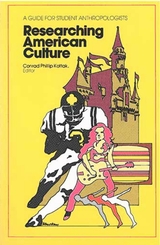 Researching American Culture: A Guide for Student Anthropologists
Conrad Phillip Kottak, Editor
University of Michigan Press, 1982 Conducting original fieldwork is a science and an art. Anthropology students can easily get an A in Aborigines without ever understanding their own tribal behavior. American culture, like all others, has its share of ritual and myths, ranging from singles bars to sports events. This volume guides undergraduate students to correct scientific methods and successful personal approaches in their work.
Researching American Culture covers the universe of ethnography: the researcher’s role, interviewing, questionnaire construction, ethics, coping with the limitations of time and space. Guides for researchers, original research papers by undergraduates, and essays by professional anthropologists are all included. By applying anthropological techniques to today’’s behavior, students learn to be objective about their own culture and skeptical about practices rarely questioned.
Researching Black Communities: A Methodological Guide
James S. Jackson, Cleopatra Howard Caldwell, Sherrill L. Sellers, editors
University of Michigan Press, 2014 Experts from a range of disciplines offer practical advice for conducting social science research in racial and ethnic minority populations. Readers will learn how to choose appropriate methods—longitudinal studies, national surveys, quantitative analysis, personal interviews, and other qualitative approaches—and how best to employ them for research on specific demographic groups. The volume opens with a brief introduction to the difficulty of defining a population and designing a research program and then moves to illustrative examples drawn from the contributors’ own studies of Blacks in the United States, the Caribbean, and South Africa. Case studies cover research on the media, mental health, churches, work, marital relationships, education, and family roles.
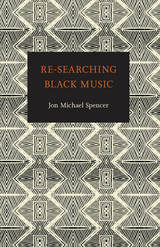 Re-Searching Black Music
Yahya Jongintaba
University of Tennessee Press, 1996 In this provocative book, Yahya Jongintaba offers a new paradigm for the study of African American music. Proceeding from the proposition that Black culture in America cannot be considered apart from its religious and philosophical roots, Jongintaba argues that “theology and musicology serving together” can form the basis of a holistic, integrative approach to Black music and, indeed, to Black culture in all its aspects.
As he shows in his opening chapters, Jongintaba’s scholarly method—theomusicology—derives from two fundamental, intertwined attributes of African American culture: its underlying rhythmicity and its thoroughly religious nature. The author then applies this approach to the folk, popular, and classical music produced by Black Americans. Finally, he considers the ethical implications that his “re-searching” of Black music uncovers. “[A] spiritual archaeology of music leads to a recognition that we are estranged from ourselves,” he writes. “This estrangement has occurred by virtue of our maintaining a doctrine of belief that sides the sacred, spiritual, and religious in respective opposition to the profane, sexual, and cultural. The recognition of this estrangement should propel us toward reconciliation, for it is the natural impulse of the ethical agent to resolve life’s tensions in pursuit of human happiness.”
While Jongintaba’s own focus is on music, he argues persuasively that theomusicology can serve as a “common mode of inquiry” for all African American cultural studies. Thus, Re-Searching Black Music is certain to stimulate discussion, debate, and further study in a broad range of scholarly arenas.
Dr. Yahya Jongintaba is Professor of Religion and Humanities in the School of Religion at Bethune-Cookman University, in Daytona Beach, Florida. He is the author of several other books.
Researching Dance: Evolving Modes of Inquiry
Sondra Horton Fraleigh
University of Pittsburgh Press, 1999 In Researching Dance, an introduction to research methods in dance addressed primarily to graduate students, the editors explore dance as evolutional, defining it in view of its intrinsic participatory values, its developmental aspects, and its purposes from art to ritual, and they examine the role of theory in research. The editors have also included essays by nine dancer-scholars who examine qualitative and quantitative inquiry and delineate the most common approaches for investigating dance, raising concerns about philosophy and aesthetics, historical scholarship, movement analysis, sexual and gender identification, cultural diversity, and the resources available to students. The writers have included study questions, research exercises, and suggested readings to facilitate the book’s use as a classroom text.
 Researching National Security Intelligence: Multidisciplinary Approaches
Stephen Coulthart, Michael Landon-Murray, and Damien Van Puyvelde, Editors
Georgetown University Press, 2019 Researchers in the rapidly growing field of intelligence studies face unique and difficult challenges ranging from finding and accessing data on secret activities, to sorting through the politics of intelligence successes and failures, to making sense of complex socio-organizational or psychological phenomena. The contributing authors to Researching National Security Intelligence survey the state of the field and demonstrate how incorporating multiple disciplines helps to generate high-quality, policy-relevant research. Following this approach, the volume provides a conceptual, empirical, and methodological toolkit for scholars and students informed by many disciplines: history, political science, public administration, psychology, communications, and journalism. This collection of essays written by an international group of scholars and practitioners propels intelligence studies forward by demonstrating its growing depth, by suggesting new pathways to the creation of knowledge, and by identifying how scholarship can enhance practice and accountability.
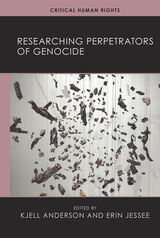 Researching Perpetrators of Genocide
Edited by Kjell Anderson and Erin Jessee
University of Wisconsin Press, 2021 Researchers often face significant and unique ethical and methodological challenges when conducting qualitative field work among people who have been identified as perpetrators of genocide. This can include overcoming biases that often accompany research on perpetrators; conceptualizing, identifying, and recruiting research subjects; risk mitigation and negotiating access in difficult contexts; self-care in conducting interviews relating to extreme violence; and minimizing harm for interviewees who may themselves be traumatized.
This collection of case studies by scholars from a range of disciplinary backgrounds turns a critical and reflective eye toward qualitative fieldwork on the topic. Framed by an introduction that sets out key issues in perpetrator research and a conclusion that proposes and outlines a code of best practice, the volume provides an essential starting point for future research while advancing genocide studies, transitional justice, and related fields. This original, important, and welcome contribution will be of value to historians, political scientists, criminologists, anthropologists, lawyers, and legal scholars.
Researching the Presidency: Vital Questions, New Approaches
George C. Edwards
University of Pittsburgh Press, 1993 This collection brings together two groups of scholars. The first, persons active in presidential research, assess the state of the literature in the recruitment and selection of presidential candidates, presidential personality, advisory networks, policy making, evaluations of presidents, and comparative analysis of chief executives.
A second group of scholars, specialists in cognitive psychology, formal theory, organization theory, leadership theory, institutionalism, and methodology, apply their expertise to the analysis of the presidentcy in an effort to generate innovative approaches to presidential research. By taking a fresh look at a well-established field, these groundbreaking essays encourage scholars to renew their emphasis on explanation in research.
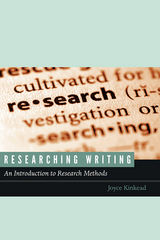 Researching Writing: An Introduction to Research Methods
Joyce Kinkead
Utah State University Press, 2016 Researching Writing is an accessible, informative textbook that teaches undergraduates how to conduct ethical, authentic research in writing studies. The book introduces students to the research approaches used most often and offers a course framework for professors creating or teaching research courses themselves.
Author Joyce Kinkead lays out the research process, including finding and defining questions, planning, and starting the research. Expository content introduces the language and methods of writing research, and specific methods are demonstrated in published examples, illustrating student work using student work and showing that it is possible for students to join the scholarly conversation in writing studies. Other features include student activities, instructor resources, student resources, and links to external content on journal websites, digital publications, YouTube, and similar work.
The first-ever textbook for research methods in writing studies for undergraduates, Researching Writing takes a hands-on approach that excites and engages students in the depth and complexities of research and will influence the creation of courses in new writing majors as the field continues to grow.
 Resemblance and Disgrace: Alexander Pope and the Deformation of Culture
Helen Deutsch
Harvard University Press, 1996 Like the miniatures of which Pope was so fond, the book is at once particular in its focus and wide-ranging in its conceptual scope. While drawing on recent feminist, historicist, and materialist criticism of Pope, as well as current theoretical work on the body, it also attends closely to the local ambiguities of the poet’s texts and cultural milieu, details often lost to critical view. The result is a revitalized—and broadened—reading of Pope, and of our understanding of the processes of authorship. By focusing on the process by which ideas of authority and authenticity took shape at specific moments in Pope’s career, Resemblance and Disgrace calls into question distinctions between theoretical abstractions and material details, between literary originality and critical derivation, following Pope’s own example of rewriting intellectual boundaries as creative opportunities.
 Resentment's Virtue: Jean Amery and the Refusal to Forgive
Thomas Brudholm, Foreword by Jeffrie Murphy
Temple University Press, 2010 Most current talk of forgiveness and reconciliation in the aftermath of collective violence proceeds from an assumption that forgiveness is always superior to resentment and refusal to forgive. Victims who demonstrate a willingness to forgive are often celebrated as virtuous moral models, while those who refuse to forgive are frequently seen as suffering from a pathology. Resentment is viewed as a negative state, held by victims who are not "ready" or "capable" of forgiving and healing. Resentment's Virtue offers a new, more nuanced view. Building on the writings of Holocaust survivor Jean Améry and the work of the South African Truth and Reconciliation Commission, Thomas Brudholm argues that the preservation of resentment can be the reflex of a moral protest that might be as permissible, humane or honorable as the willingness to forgive. Taking into account the experiences of victims, the findings of truth commissions, and studies of mass atrocities, Brudholm seeks to enrich the philosophical understanding of resentment.
Reserved Water Rights Settlement Manual
Peter W. Sly; Western Office of Council of State Governments Western LegislativeConference
Island Press, 1989 Reserved Water Rights Settlement Manual provides a negotiating process for settling water disputes between states and reservations, or among states themselves.
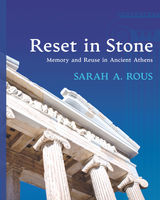 Reset in Stone: Memory and Reuse in Ancient Athens
Sarah A. Rous
University of Wisconsin Press, 2019 Ancient Athenians were known to reuse stone artifacts, architectural blocks, and public statuary in the creation of new buildings and monuments. However, these construction decisions went beyond mere pragmatics: they were often a visible mechanism for shaping communal memory, especially in periods of profound and challenging social or political transformation.
Sarah Rous develops the concept of upcycling to refer to this meaningful reclamation, the intentionality of reemploying each particular object for its specific new context. The upcycling approach drives innovative reinterpretations of diverse cases, including column drums built into fortification walls, recut inscriptions, monument renovations, and the wholesale relocation of buildings. Using archaeological, literary, and epigraphic evidence from more than eight centuries of Athenian history, Rous's investigation connects seemingly disparate instances of the reuse of building materials. She focuses on agency, offering an alternative to the traditional discourse on spolia. Reset in Stone illuminates a vital practice through which Athenians shaped social memory in the physical realm, literally building their past into their city.
Resetting the Stage: Public Theatre between the Market and Democracy
Dragan Klaic
Intellect Books, 2012 Commercial theater is thriving across Europe and the UK, while public theater has suffered under changing patterns of cultural consumption—as well as sharp reductions in government subsidies for the arts. At a time when the rationale behind these subsidies is being widely reexamined, it has never been more important for public theater to demonstrate its continued merit. In Resetting the Stage, Dragan Klaic argues convincingly that, in an increasingly crowded market of cultural goods, public theater is best served not by imitating its much larger commercial counterpart, but by asserting its artistic distinctiveness and the considerable benefit this confers on the public.
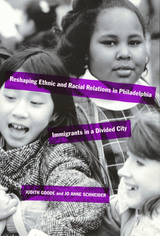 Reshaping Ethnic Relations: Immigrants in a Divided City
Judith Goode and Jo Anne Schneider
Temple University Press, 1994 What happens when people from diverse racial and ethnic backgrounds come together to live and work in the same neighborhood? Unlike other examinations of this question that focus on one group, this book looks at the interaction of both old and new immigrant populations in three Philadelphia neighborhoods. In this ethnographic study, which is a result of the Ford Foundation-funded Changing Relations: Newcomers and Established Residents in Philadelphia Project, the authors consider five primary groups—whites, African Americans, Puerto Ricans, Koreans, and Eastern Europeans—in Olney, Kensington, and Port Richmond. Focusing on the interaction of racial, ethnic, and immigrant communities in schools, organized community celebrations and social events, the workplace, shopping areas, and neighborhood politics, the authors show that the contradictions of individual beliefs, actions, and strategies of power are not easily resolved. By examining the local, citywide, and national economy and government, previous human relations efforts, changing immigration patterns, community-level power structures, real estate turnover, and gentrification, the authors evaluate current strategies to create harmony in communities with an ever-changing mix of established residents and newly arrived immigrants. Through their findings, Judith Goode and Jo Anne Schneider develop better alternatives that will encourage understanding and cooperation among different racial and ethnic groups sharing their lives and neighborhoods.
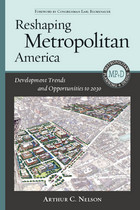 Reshaping Metropolitan America: Development Trends and Opportunities to 2030
Arthur C. Nelson
Island Press, 2012 Nearly half the buildings that will be standing in 2030 do not exist today. That means we have a tremendous opportunity to reinvent our urban areas, making them more sustainable and livable for future generations. But for this vision to become reality, the planning community needs reliable data about emerging trends and smart projections about how they will play out. Arthur C. Nelson delivers that resource in Reshaping Metropolitan America. This unprecedented reference provides statistics about changes in population, jobs, housing, nonresidential space, and other key factors that are shaping the built environment, but its value goes beyond facts and figures. Nelson expertly analyzes contemporary development trends and identifies shifts that will affect metropolitan areas in the coming years. He shows how redevelopment can meet new and emerging market demands by creating more compact, walkable, and enjoyable communities. Most importantly, Nelson outlines a policy agenda for reshaping America that meets the new market demand for sustainable places.
Reshaping New Spain: Government and Private Interests in the Colonial Bureaucracy, 1535-1550
Ethelia Ruiz Medrano
University Press of Colorado, 2006 Originally published in Mexico as Gobierno y Sociedad en Nueva Espana, Ethelia Ruiz Medrano's seminal study Reshaping New Spain is now available in an updated English edition. Drawing on extensive archival research, Ruiz examines the developing colonial institutions in Mexico and how they changed indigenous land ownership and labor laws to favor the new bureaucrats. This portrait of the emerging government in New Spain fills a critical niche in Latin American studies.
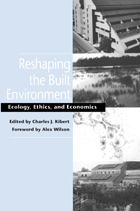 Reshaping the Built Environment: Ecology, Ethics, and Economics
Edited by Charles J. Kibert; Foreword by Alex Wilson
Island Press, 1999 Because of the profound effects of the built environment on the availability of natural resources for future generations, those involved with designing, creating, operating, renovating, and demolishing human structures have a vital role to play in working to put society on a path toward sustainability. This volume presents the thinking of leading academics and professionals in planning, civil engineering, economics, ecology, architecture, landscape architecture, construction, and related fields who are seeking to discover ways of creating a more sustainable built environment. Contributors address the broad range of issues involved, offering both insights and practical examples. In the book: - Stephen Kellert describes the scope of the looming ecological crisis
- Herman Daly explains the unsustainability of the world's economic system and the dangers inherent in the current movement toward globalization
- John Todd describes the evolution of wastewater processing systems inspired by natural systems
- John Tillman Lyle discusses the importance of landscape in the creation of the human environment
- Randall Arendt argues for a fundamental shift in land development patterns that would not only provide for more green space in new developments, but would also increase the profitability of developers and the quality of life for new home owners
- Thomas E. Graedel proposes the application of lessons learned from the emerging science of industrial ecology to the creation of "green" building.
While the transition to sustainability will not be easy, natural systems provide abundant models of architecture, engineering, production, and waste conversion that can be used in rethinking the human habitat and its interconnections. This volume provides insights that can light the way to a new era in which a reshaped built environment will not only provide improved human living conditions, but will also protect and respect the earth's essential natural life-support systems and resources.
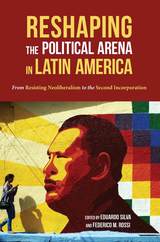 Reshaping the Political Arena in Latin America: From Resisting Neoliberalism to the Second Incorporation
Eduardo Silva
University of Pittsburgh Press, 2018 Neoliberalism changed the face of Latin America and left average citizens struggling to cope in many ways. Popular sectors were especially hard hit as wages declined and unemployment increased. The backlash to neoliberalism in the form of popular protest and electoral mobilization opened space for leftist governments to emerge. The turn to left governments raised popular expectations for a second wave of incorporation. Although a growing literature has analyzed many aspects of left governments, there is no study of how the redefinition of the organized popular sectors, their allies, and their struggles have reshaped the political arena to include their interests—until now. This volume examines the role played in the second wave of incorporation by political parties, trade unions, and social movements in five cases: Argentina, Bolivia, Brazil, Ecuador, and Venezuela. The cases shed new light on a subject critical to understanding the change in the distribution of political power related to popular sectors and their interests—a key issue in the study of postneoliberalism.
 Reshaping the Work-Family Debate: Why Men and Class Matter
Joan C. Williams
Harvard University Press, 2008 The United States has the most family-hostile public policy in the developed world. Despite what is often reported, new mothers don’t “opt out” of work. They are pushed out by discriminating and inflexible workplaces. Today’s workplaces continue to idealize the worker who has someone other than parents caring for their children.
Conventional wisdom attributes women’s decision to leave work to their maternal traits and desires. In this thought-provoking book, Joan Williams shows why that view is misguided and how workplace practice disadvantages men—both those who seek to avoid the breadwinner role and those who embrace it—as well as women. Faced with masculine norms that define the workplace, women must play the tomboy or the femme. Both paths result in a gender bias that is exacerbated when the two groups end up pitted against each other. And although work-family issues long have been seen strictly through a gender lens, we ignore class at our peril. The dysfunctional relationship between the professional-managerial class and the white working class must be addressed before real reform can take root.
Contesting the idea that women need to negotiate better within the family, and redefining the notion of success in the workplace, Williams reinvigorates the work-family debate and offers the first steps to making life manageable for all American families.
 Reshaping the World: Debates on Mesoamerican Cosmologies
Ana Díaz
University Press of Colorado, 2019 Reshaping the World is a nuanced exploration of the plurality, complexity, and adaptability of Precolumbian and colonial-era Mesoamerican cosmological models and the ways in which anthropologists and historians have used colonial and indigenous texts to understand these models in the past. Since the early twentieth century, it has been popularly accepted that the Precolumbian Mesoamerican cosmological model comprised nine fixed layers of underworld and thirteen fixed layers of heavens. This layered model, which bears a close structural resemblance to a number of Eurasian cosmological models, derived in large part from scholars’ reliance on colonial texts, such as the post–Spanish Conquest Codex Vaticanus A and Florentine Codex.
By reanalyzing and recontextualizing both indigenous and colonial texts and imagery in nine case studies examining Maya, Zapotec, Nahua, and Huichol cultures, the contributors discuss and challenge the commonly accepted notion that the cosmos was a static structure of superimposed levels unrelated to and unaffected by historical events and human actions. Instead, Mesoamerican cosmology consisted of a multitude of cosmographic repertoires that operated simultaneously as a result of historical circumstances and regional variations. These spaces were, and are, dynamic elements shaped, defined, and redefined throughout the course of human history. Indigenous cosmographies could be subdivided and organized in complex and diverse arrangements—as components in a dynamic interplay, which cannot be adequately understood if the cosmological discourse is reduced to a superposition of nine and thirteen levels.
Unlike previous studies, which focus on the reconstruction of a pan-Mesoamerican cosmological model, Reshaping the World shows how the movement of people, ideas, and objects in New Spain and neighboring regions produced a deep reconfiguration of Prehispanic cosmological and social structures, enriching them with new conceptions of space and time. The volume exposes the reciprocal influences of Mesoamerican and European theologies during the colonial era, offering expansive new ways of understanding Mesoamerican models of the cosmos.
Contributors:
Sergio Botta, Ana Díaz, Kerry Hull, Katarzyna Mikulska, Johannes Neurath, Jesper Nielsen, Toke Sellner Reunert†, David Tavárez, Alexander Tokovinine, Gabrielle Vail
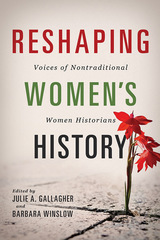 Reshaping Women's History: Voices of Nontraditional Women Historians
Julie A. Gallagher, Barbara Winslow
University of Illinois Press, 2018 Award-winning women scholars from nontraditional backgrounds have often negotiated an academic track that leads through figurative--and sometimes literal--minefields. Their life stories offer inspiration, but also describe heartrending struggles and daunting obstacles. Reshaping Women's History presents autobiographical essays by eighteen accomplished scholar-activists who persevered through poverty or abuse, medical malpractice or family disownment, civil war or genocide. As they illuminate their own unique circumstances, the authors also address issues all-too-familiar to women in the academy: financial instability, the need for mentors, explaining gaps in resumes caused by outside events, and coping with gendered family demands, biases, and expectations. Eye-opening and candid, Reshaping Women's History shows how adversity, and the triumph over it, enriches scholarship and spurs extraordinary efforts to affect social change. Contributors: Frances L. Buss, Nupur Chaudhuri, Lisa DiCaprio, Julie R. Enszer, Catherine Fosl, Midori Green, La Shonda Mims, Stephanie Moore, Grey Osterud, Barbara Ransby, Linda Reese, Annette Rodriguez, Linda Rupert, Kathleen Sheldon, Donna Sinclair, Rickie Solinger, Pamela Stewart, Waaseyaa'sin Christine Sy, and Ann Marie Wilson.
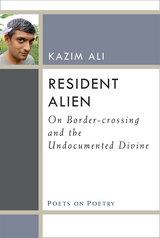 Resident Alien: On Border-crossing and the Undocumented Divine
Kazim Ali
University of Michigan Press, 2015 Kazim Ali uses a range of subjects—the politics of checkpoints at international borders; difficulties in translation; collaborations between poets and choreographers; and connections between poetry and landscape, or between biotechnology and the human body—to situate the individual human body into a larger global context, with all of its political and social implications. He finds in the quality of ecstatic utterance his passport to regions where reason and logic fail and the only knowledge is instinctual, in physical existence and breath. This collection includes Ali’s essays on topics such as Anne Carson’s translations of Euripides; the poetry and politics of Mahmoud Darwish; Josey Foo’s poetry/dance collaborations with choreographer Leah Stein; Olga Broumas’ collaboration with T. Begley; Jorie Graham’s complication of Kenneth Goldsmith’s theories; the postmodern spirituality of the 14th century Kashmiri mystic poet Lalla; translations of Homer, Mandelstam, Sappho, and Hafez; as well as the poet Reetika Vazirani’s practice of yoga.
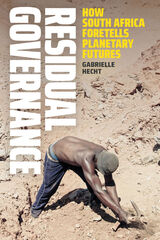 Residual Governance: How South Africa Foretells Planetary Futures
Gabrielle Hecht
Duke University Press, 2023 In Residual Governance, Gabrielle Hecht dives into the wastes of gold and uranium mining in South Africa to explore how communities, experts, and artists fight for infrastructural and environmental justice. Hecht outlines how mining in South Africa is a prime example of what she theorizes as residual governance—the governance of waste and discard, governance that is purposefully inefficient, and governance that treats people and places as waste and wastelands. She centers the voices of people who resist residual governance and the harms of toxic mining waste to highlight how mining’s centrality to South African history reveals the links between race, capitalism, the state, and the environment. In this way, Hecht shows how the history of mining in South Africa and the resistance to residual governance and environmental degradation is a planetary story: the underlying logic of residual governance lies at the heart of contemporary global racial capitalism and is a major accelerant of the Anthropocene.
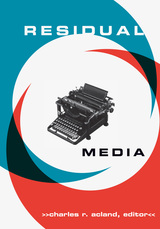 Residual Media
Charles R. Acland
University of Minnesota Press, 2006 In a society that breathlessly awaits “the new” in every medium, what happens to last year’s new? Ample critical energy has gone into the study of new media, genres, and communities. But what becomes of discarded media? In what manner do the products of technological change reappear as environmental problems, as “the new” in another part of the world, as collectibles, as memories, and as art?
Residual Media grapples with these questions and more in a wide-ranging and eclectic collection of essays. Beginning with how cultural change bumps along unevenly, dragging the familiar into novel contexts, the contributors examine how leftover artifacts can be rediscovered occupying space in storage sheds, traveling the globe, converting to alternative uses, and accumulating in landfills. By exploring reconfigured, renewed, recycled, neglected, abandoned, and trashed media, the essays here combine theoretical challenges to media history with ideas, technology, and uses that have been left behind.
From player pianos to vinyl records, and from the typewriter to the telephone, Residual Media is an innovative approach to the aging of culture and reveals that, ultimately, new cultural phenomena rely on encounters with the old.
Contributors: Jennifer Adams, DePauw U; Jody Berland, York U; Sue Currell, U of Sussex; Maria DiCenzo, Wilfrid Laurier U; Kate Egan, U of Wales; Lisa Gitelman, Catholic U; Alison Griffiths, CUNY; James Hamilton, U of Georgia; James Hay, U of Illinois—Champaign-Urbana; Michelle Henning, U of the West of England; Lisa Parks, UC Santa Barbara; Hillegonda C. Rietveld, South Bank U; Leila Ryan, McMaster U; John Davis, Alfred U; Collette Snowden, U of South Australia; Jonathan Sterne, McGill U; JoAnne Stober, National Archives, Canada; Will Straw, McGill U; Haidee Wasson, Concordia U.
Charles R. Acland is Professor and holds the Concordia University Research Chair in communications studies at Concordia University, Montreal.
 Residues: Thinking Through Chemical Environments
Soraya Boudia
Rutgers University Press, 2022
Winner of the 2023 Merton Award from the Science, Knowledge, and Technology section of the American Sociological Association
Residues offers readers a new approach for conceptualizing the environmental impacts of chemicals production, consumption, disposal, and regulation. Environmental protection regimes tend to be highly segmented according to place, media, substance, and effect; academic scholarship often reflects this same segmented approach. Yet, in chemical substances we encounter phenomena that are at once voluminous and miniscule, singular and ubiquitous, regulated yet unruly. Inspired by recent studies of materiality and infrastructures, we introduce “residual materialism” as a framework for attending to the socio-material properties of chemicals and their world-making powers. Tracking residues through time, space, and understanding helps us see how the past has been built into our present chemical environments and future-oriented regulatory systems, why contaminants seem to always evade control, and why the Anthropocene is as inextricably harnessed to the synthesis of carbon into new molecules as it is driven by carbon’s combustion.
Resilience
Rebekkah Smith Aldrich
American Library Association, 2018
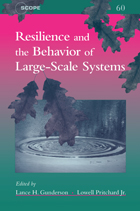 Resilience and the Behavior of Large-Scale Systems
Edited by Lance H. Gunderson and Lowell Pritchard Jr.; SCOPE
Island Press, 2002 Scientists and researchers concerned with the behavior of large ecosystems have focused in recent years on the concept of "resilience." Traditional perspectives held that ecological systems exist close to a steady state and resilience is the ability of the system to return rapidly to that state following perturbation. However beginning with the work of C. S. Holling in the early 1970s, researchers began to look at conditions far from the steady state where instabilities can cause a system to shift into an entirely different regime of behavior, and where resilience is measured by the magnitude of disturbance that can be absorbed before the system is restructured. Resilience and the Behavior of Large-Scale Systems examines theories of resilience and change, offering readers a thorough understanding of how the properties of ecological resilience and human adaptability interact in complex, regional-scale systems. The book addresses the theoretical concepts of resilience and stability in large-scale ecosystems as well as the empirical application of those concepts in a diverse set of cases. In addition, it discusses the practical implications of the new theoretical approaches and their role in the sustainability of human-modified ecosystems. The book begins with a review of key properties of complex adaptive systems that contribute to overall resilience, including multiple equlibria, complexity, self-organization at multiple scales, and order; it also presents a set of mathematical metaphors to describe and deepen the reader's understanding of the ideas being discussed. Following the introduction are case studies that explore the biophysical dimensions of resilience in both terrestrial and aquatic systems and evaluate the propositions presented in the introductory chapters. The book concludes with a synthesis section that revisits propositions in light of the case studies, while an appendix presents a detailed account of the relationship between return times for a disturbed system and its resilienc. In addition to the editors, contributors include Stephen R. Carpenter, Carl Folke, C. S. Holling, Bengt-Owe Jansson, Donald Ludwig, Ariel Lugo, Tim R. McClanahan, Garry D. Peterson, and Brian H. Walker.
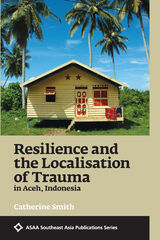 Resilience and the Localisation of Trauma in Aceh, Indonesia
Catherine Smith
National University of Singapore Press, 2017 Aceh is a region that is no stranger to violent conflict and tragedy. This special territory of Indonesia has faced occupation, fallen into civil war, and was brutalized by the deadly 2004 tsunami. While these forces have altered the lives of the Aceh people, their very experiences of suffering and recovery have changed thanks to the globalization of psychiatry.
In this book, Catherine Smith examines the global reach of the contested, yet compelling, concept of trauma. She explores how what is considered “trauma” has expanded well beyond the bounds of therapeutic practice to become a powerful cultural idiom shaping the ways people understand the effects of violence and imagine possible responses to suffering. In Aceh, conflict survivors have incorporated the ideas of trauma into their local languages, healing practices, and political imaginaries. The appearance of this idiom of distress into the Acehnese medical-moral landscape provides an ethnographic perspective on suffering and recovery, and contributes to our contemporary debates about the international reach of psychiatry and the cultural consequences as it spreads beyond the domain of medicine.
 Resilience as Heritage in Asia
Michael Herzfeld
Amsterdam University Press, 2025 Resilience as Heritage in Asia analyzes forms of collective resilience through manifestations of strength-in-fragility in selected communities in Asia (Indonesia, Japan, Malaysia, the Philippines, Singapore, and Thailand). Persistent resistance to communal erasure taking place through repressive policies and commercialized, multinational urban development insensitive to local communities and values often presents an uphill battle. Some of these collective efforts to survive through persistent everyday actions, encounters, and constant struggles have successful outcomes, while others are ephemeral at best. The authors argue that persisting vernacular spaces located between resistance and co-optation are themselves a form of local cultural heritage in the rapidly urbanizing region. Recognizing these nonconformist forms of resilience as heritage acknowledges the creativity involved in challenging social and political inequalities. Supporting the cultural autonomy of local communities by acknowledging resilience as heritage contributes to social justice in the region.
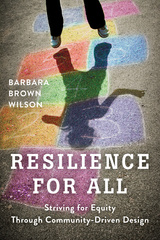 Resilience for All: Striving for Equity Through Community-Driven Design
Barbara Brown Wilson
Island Press, 2018 In the United States, people of color are disproportionally more likely to live in environments with poor air quality, in close proximity to toxic waste, and in locations more vulnerable to climate change and extreme weather events.
In many vulnerable neighborhoods, structural racism and classism prevent residents from having a seat at the table when decisions are made about their community. In an effort to overcome power imbalances and ensure local knowledge informs decision-making, a new approach to community engagement is essential.
In Resilience for All, Barbara Brown Wilson looks at less conventional, but often more effective methods to make communities more resilient. She takes an in-depth look at what equitable, positive change through community-driven design looks like in four communities—East Biloxi, Mississippi; the Lower East Side of Manhattan; the Denby neighborhood in Detroit, Michigan; and the Cully neighborhood in Portland, Oregon. These vulnerable communities have prevailed in spite of serious urban stressors such as climate change, gentrification, and disinvestment. Wilson looks at how the lessons in the case studies and other examples might more broadly inform future practice. She shows how community-driven design projects in underserved neighborhoods can not only change the built world, but also provide opportunities for residents to build their own capacities.
Resilience in Wireless Networks
Prashant Krishnamurthy
The Institution of Engineering and Technology, 2026 Resilience in Wireless Networks is the first book to cover this topic at an advanced level. It provides a unified view of the latest research and illustrates the issues, challenges and solutions currently under discussion. The book divides wireless networks into infrastructure and ad hoc topologies and considers the resilience of each separately.
Resilience Matters 2017
Laurie Mazur
Island Press, 2017 This free e-book collects articles, op-eds, and other short-form writing from the Island Press Urban Resilience Project. Written by a diverse group of activists, academics, and practitioners, this contributed volume addresses various dimensions of resilience—economic, ecological, and social.
 Resilience Matters: Ten Years of Transformative Thinking
Island Press Short-form Program
Island Press, 2025 In a world of ever-more-frequent disruptions—natural disasters, economic turbulence, pandemics—resilience has become something of a buzzword. But what does it mean to be resilient in these tumultuous times?
This volume, a collection of articles and op-eds published over the last decade, offers a banquet of answers to that question.
The contributors to Resilience Matters span many perspectives: they are community leaders and policy wonks, academics and elected officials. Yet, they agree that resilience is not about “bouncing back” to the status quo. Today, the destabilized climate poses unparalleled risks to human well-being, and rising inequality means those risks are not equally shared. That’s why we must “bounce forward” to a future that protects us from climate change while distributing risks—and opportunities—more equitably.
That future is already under way. Here, you can catch glimpses of what it could look like: community-owned clean energy that keeps the lights on when the grid goes down; strategies to safeguard communities from flooding and fire; energy efficiency and renewable power that bend the curve of greenhouse gas emissions; policies to protect those at greatest risk from extreme weather and to support the leadership of those on the front lines of climate disruption.
The coming years will certainly test our collective resilience. But, even in these polarized times, people are rising to the great environmental and moral challenges before us. In these pages, they show us how to build a greener, fairer, and more resilient future.
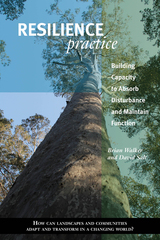 Resilience Practice: Building Capacity to Absorb Disturbance and Maintain Function
Brian Walker and David Salt
Island Press, 2012 In 2006, Resilience Thinking addressed an essential question: As the natural systems that sustain us are subjected to shock after shock, how much can they take and still deliver the services we need from them? This idea caught the attention of both the scientific community and the general public.
In Resilience Practice, authors Brian Walker and David Salt take the notion of resilience one step further, applying resilience thinking to real-world situations and exploring how systems can be managed to promote and sustain resilience.
The book begins with an overview and introduction to resilience thinking and then takes the reader through the process of describing systems, assessing their resilience, and intervening as appropriate. Following each chapter is a case study of a different type of social-ecological system and how resilience makes a difference to that system in practice. The final chapters explore resilience in other arenas, including on a global scale.
Resilience Practice will help people with an interest in the “coping capacity” of systems—from farms and catchments to regions and nations—to better understand how resilience thinking can be put into practice. It offers an easy-to-read but scientifically robust guide through the real-world application of the concept of resilience and is a must read for anyone concerned with the management of systems at any scale.
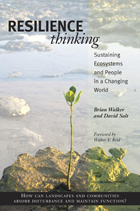 Resilience Thinking: Sustaining Ecosystems and People in a Changing World
Brian Walker and David Salt; Foreword by Walter V. Reid
Island Press, 2006 Resilience Thinking introduces a bold and necessary shift in how we understand and manage systems—whether ecological, economic, or social—in a world marked by rapid change and uncertainty. Rather than offering short-term fixes or efficiency-driven solutions that often lead to brittle outcomes, this book presents a powerful framework for building systems that can adapt, transform, and thrive over time.
Written by scientist Brian Walker and science communicator David Salt, Resilience Thinking explains how human and natural systems operate as dynamic networks shaped by cycles of disturbance, renewal, and evolution. The book explores what qualities make a system resilient—such as diversity, modularity, and the ability to learn—and how these qualities can be nurtured to ensure long-term sustainability.
Clear, concise, and engaging, the book offers more than just theory. Through five real-world case studies, readers see how resilience thinking can be applied across landscapes, communities, and industries to navigate risk, foster innovation, and expand future options. Whether managing a watershed, planning urban growth, or designing policy, this approach equips decision-makers with tools for thinking beyond linear models and toward systems that can absorb shocks and keep functioning.
Resilience Thinking is essential reading for environmental professionals, business leaders, and anyone seeking smarter ways to steward resources in a complex, interconnected world.
 Resilient by Design: Creating Businesses That Adapt and Flourish in a Changing World
Joseph Fiksel
Island Press, 2015 As managers grapple with the challenges of climate change and volatility in a hyper-connected, global economy, they are paying increasing attention to their organization’s resilience—its capacity to survive, adapt, and flourish in the face of turbulent change. Sudden natural disasters and unforeseen supply chain disruptions are increasingly common in the new normal. Pursuing business as usual is no longer viable, and many companies are unaware of how fragile they really are. To cope with these challenges, management needs a new paradigm that takes an integrated view of the built environment, the ecosystems, and the social fabric in which their businesses operate.
Resilient by Design provides business executives with a comprehensive approach to achieving consistent success in a changing world. Rich with examples and case studies of organizations that are designing resilience into their business processes, it explains how to connect with important external systems—stakeholders, communities, infrastructure, supply chains, and natural resources—and create innovative, dynamic organizations that survive and prosper under any circumstances.
Resilient enterprises continue to grow and evolve in order to meet the needs and expectations of their shareholders and stakeholders. They adapt successfully to turbulence by anticipating disruptive changes, recognizing new business opportunities, building strong relationships, and designing resilient assets, products, and processes. Written by one of the leading experts in enterprise resilience and sustainability, Resilient by Design offers a confident path forward in a world that is increasingly less certain.
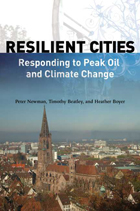 Resilient Cities: Responding to Peak Oil and Climate Change
Peter Newman, Timothy Beatley, and Heather Boyer
Island Press, 2008 Half of the world’s inhabitants now live in cities. In the next twenty years, the number of urban dwellers will swell to an estimated five billion people. With their inefficient transportation systems and poorly designed buildings, many cities—especially in the United States—consume enormous quantities of fossil fuels and emit high levels of greenhouse gases. But our planet is rapidly running out of the carbon-based fuels that have powered urban growth for centuries and we seem to be unable to curb our greenhouse gas emissions. Are the world’s cities headed for inevitable collapse? The authors of this spirited book don’t believe that oblivion is necessarily the destiny of urban areas. Instead, they believe that intelligent planning and visionary leadership can help cities meet the impending crises, and look to existing initiatives in cities around the world. Rather than responding with fear (as a legion of doomsaying prognosticators have done), they choose hope. First, they confront the problems, describing where we stand today in our use of oil and our contribution to climate change. They then present four possible outcomes for cities: ”collapse,” “ruralized,” “divided,” and “resilient.” In response to their scenarios, they articulate how a new “sustainable urbanism” could replace today’s “carbon-consuming urbanism.” They address in detail how new transportation systems and buildings can be feasibly developed to replace our present low efficiency systems. In conclusion, they offer ten “strategic steps” that any city can take toward greater sustainability and resilience. This is not a book filled with “blue sky” theory (although blue skies will be a welcome result of its recommendations). Rather, it is packed with practical ideas, some of which are already working in cities today. It frankly admits that our cities have problems that will worsen if they are not addressed, but it suggests that these problems are solvable. And the time to begin solving them is now.
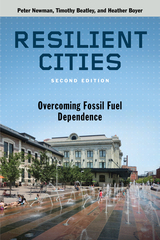 Resilient Cities, Second Edition: Overcoming Fossil Fuel Dependence
Peter Newman, Timothy Beatley, and Heather Boyer
Island Press, 2017 What does it mean to be a resilient city in the age of a changing climate and growing inequity? As urban populations grow, how do we create efficient transportation systems, access to healthy green space, and lower-carbon buildings for all citizens?
Peter Newman, Timothy Beatley, and Heather Boyer respond to these questions in the revised and updated edition of Resilient Cities. Since the first edition was published in 2009, interest in resilience has surged, in part due to increasingly frequent and deadly natural disasters, and in part due to the contribution of our cities to climate change. The number of new initiatives and approaches from citizens and all levels of government show the promise as well as the challenges of creating cities that are truly resilient.
The authors’ hopeful approach to creating cities that are not only resilient, but striving to become regenerative, is now organized around their characteristics of a resilient city. A resilient city is one that uses renewable and distributed energy; has an efficient and regenerative metabolism; offers inclusive and healthy places; fosters biophilic and naturally adaptive systems; is invested in disaster preparedness; and is designed around efficient urban fabrics that allow for sustainable mobility.
Resilient Cities, Second Edition reveals how the resilient city characteristics have been achieved in communities around the globe. The authors offer stories, insights, and inspiration for urban planners, policymakers, and professionals interested in creating more sustainable, equitable, and, eventually, regenerative cities. Most importantly, the book is about overcoming fear and generating hope in our cities. Cities will need to claim a different future that helps us regenerate the whole planet–this is the challenge of resilient cities.
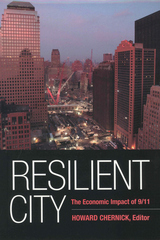 Resilient City: The Economic Impact of 9/11
Howard Chernick
Russell Sage Foundation, 2005 The strike against the World Trade Center on September 11, 2001, was a violent blow against the United States and a symbolic attack on capitalism and commerce. It shut down one of the world's busiest commercial centers for weeks, destroyed or damaged billions of dollars worth of property, and forced many New York City employers to slash their payrolls or move jobs to other areas. The immediate economic effect was substantial, but how badly did 9/11 affect New York City's economy in the longer term? In Resilient City, Howard Chernick and a team of economic experts examine the city's economic recovery in the three years following the destruction of the Twin Towers. Assessing multiple facets of the New York City economy in the years after 9/11, Resilient City discerns many hopeful signs among persistent troubles. Analysis by economist Sanders Korenman indicates that the value of New York–based companies did not fall relative to other firms, indicating that investors still believe that there are business advantages to operating in New York despite higher rates of terrorism insurance and concerns about future attacks. Cordelia Reimers separates the economic effect of 9/11 from the effects of the 2001 recession by comparing employment and wage trends for disadvantaged workers in New York with those in five major U.S. cities. She finds that New Yorkers fared at least as well as people in other cities, suggesting that the decline in earnings and employment for low-income New York workers in 2002 was due more to the recession than to the effects of 9/11. Still, troubles remain for New York City. Howard Chernick considers the substantial fiscal implications of the terrorist attacks on New York City, estimating that the attack cost the city about $3 billion in the first two years alone; a sum that the city now must make up through large tax increases, spending cuts, and substantial additional borrowing, which will inevitably be a burden on future budgets. The terrorist attacks of September 11 dealt a severe blow to the economy of New York City, but it was far from a knock-out punch. Resilient City shows that New York's dynamic, flexible economy has absorbed the hardships inflicted by the attacks, and provides a thorough, authoritative A Russell Sage Foundation September 11 Initiative Volume
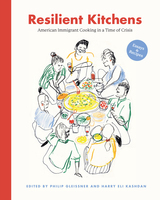 Resilient Kitchens: American Immigrant Cooking in a Time of Crisis, Essays and Recipes
Philip Gleissner
Rutgers University Press Winner of the James Beard Award for Best Book in Food Issues and Advocacy
Immigrants have left their mark on the great melting pot of American cuisine, and they have continued working hard to keep America’s kitchens running, even during times of crisis like the COVID-19 pandemic. For some immigrant cooks, the pandemic brought home the lack of protection for essential workers in the American food system. For others, cooking was a way of reconnecting with homelands they could not visit during periods of lockdown. Resilient Kitchens: American Immigrant Cooking in a Time of Crisis is a stimulating collection of essays about the lives of immigrants in the United States before and during the COVID-19 pandemic, told through the lens of food. It includes a vibrant mix of perspectives from professional food writers, restaurateurs, scholars, and activists, whose stories range from emotional reflections on hardship, loss, and resilience to journalistic investigations of racism in the American food system. Each contribution is accompanied by a recipe of special importance to the author, giving readers a taste of cuisines from around the world. Every essay is accompanied by gorgeous food photography, the authors’ snapshots of pandemic life, and hand-drawn illustrations by Filipino American artist Angelo Dolojan.
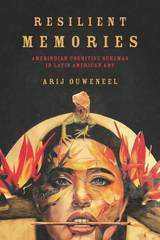 Resilient Memories: Amerindian Cognitive Schemas in Latin American Art
Arij Ouweneel
Ohio State University Press, 2018 Arij Ouweneel’s Resilient Memories: Amerindian Cognitive Schemas in Latin American Art takes a cognitive approach to the mediation of collective memory by works of art. In looking at cultural production of Amerindians—the transnational mnemonic community comprised of indígenas, originarios, mestizos, and cholos—Ouweneel argues that cultural memories and identity are not simply the sum total of individuals’ expressions of self, but that some cultural artifacts become privileged to inform the heart of the mnemonic community. Ouweneel seeks to identify a series of cognitive schemas as the foundation of an Amerindian Cognitive Unconsciousness as a viable alternative to the Freudian Dynamic Unconscious. Art, then, serves to trigger the cognitive schemas embedded within the Amerindian community and act as the mediator of collective memory.
Exploring works ranging in popularity, from Alfonso Cuarón’s Y Tu Mamá También to the paintings of Peruvian artists Claudia Coca and Jorge Miyagui, and from Mexican Zapatistas to hip-hop, Ouweneel details the ways in which artists interact with the embodied memory of the community but also assert their own place within it as crucial, furthering their audiences’ understanding of and interaction with existing cultural schemas. In this way, Ouweneel shows that memories must serve the present or they will be forgotten.
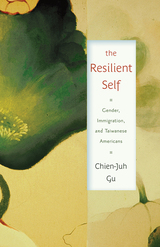 The Resilient Self: Gender, Immigration, and Taiwanese Americans
Gu, Chien-Juh
Rutgers University Press, 2017 The Resilient Self explores how international migration re-shapes women’s senses of themselves. Chien-Juh Gu uses life-history interviews and ethnographic observations to illustrate how immigration creates gendered work and family contexts for middle-class Taiwanese American women, who, in turn, negotiate and resist the social and psychological effects of the processes of immigration and settlement.
Most of the women immigrated as dependents when their U.S.-educated husbands found professional jobs upon graduation. Constrained by their dependent visas, these women could not work outside of the home during the initial phase of their settlement. The significant contrast of their lives before and after immigration—changing from successful professionals to foreign housewives—generated feelings of boredom, loneliness, and depression. Mourning their lost careers and lacking fulfillment in homemaking, these highly educated immigrant women were forced to redefine the meaning of work and housework, which in time shaped their perceptions of themselves and others in the family, at work, and in the larger community.
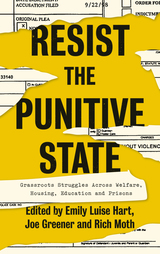 Resist the Punitive State: Grassroots Struggles Across Welfare, Housing, Education and Prisons
Emily Luise Hart
Pluto Press, 2019 To examine government policy and state practice on housing, welfare, mental health, disability, prisons or immigration is to come face-to-face with the harsh realities of the 'punitive state'. But state violence and corporate harm always meet with resistance. With contributions from a wide range of activists and scholars, Resist the Punitive State highlights and theorises the front line of resistance movements actively opposing the state-corporate nexus. The chapters engage with different strategies of resistance in a variety of movements and campaigns. In doing so the book considers what we can learn from involvement in grassroots struggles, and contributes to contemporary debates around the role and significance of subversive knowledge and engaged scholarship in activism. Aimed at activists and campaigners plus students, researchers and educators in criminology, social policy, sociology, social work and the social sciences more broadly, Resist the Punitive State not only presents critiques of a range of harmful state-corporate policy agendas but situates these in the context of social movement struggles fighting for political transformation and alternative futures.
Resistance against the Third Reich: 1933-1990
Edited by Michael Geyer and John W. Boyer
University of Chicago Press, 1994 "The history of resistance affords a powerful example of why the present should try to remember a more distant, early modern past" write Michael Geyer and John W. Boyer in their introduction to Resistance against the Third Reich. Addressing the legacy of European resistance, this volume examines the nature of political opposition to unjust rule, which is so often grounded in the bitter conflicts between church and state. This collection is a timely effort to link recent advances in European history with lingering questions concerning resistance against the Third Reich.
Contributors include Geoffrey Cocks, Werner G. Jeanrond, Tony Judt, Claudia Koonz, Hans Mommsen, and Frank Trommler.
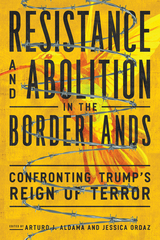 Resistance and Abolition in the Borderlands: Confronting Trump's Reign of Terror
Edited by Arturo J. Aldama and Jessica Ordaz; Foreword by Leo R. Chavez; Afterword by Karma R. Chávez
University of Arizona Press, 2024 While there is a long history of state violence toward immigrants in the United States, the essayists in this interdisciplinary collection tackle head-on the impacts of the Trump administration.
This volume provides a well-argued look at the Trump era. Insightful contributions delve into the impact of Donald Trump’s rhetoric and policies on migrants detained and returned, immigrant children separated from their parents and placed in detention centers, and migrant women subjected to sexual and reproductive abuses, among other timely topics. The chapter authors document a long list in what the book calls “Trump’s Reign of Terror.”
Organized thematically, the book has four sections: The first gathers histories about the Trump years’ roots in a longer history of anti-migration; the second includes essays on artistic and activist responses on the border during the Trump years; the third critiques the normalization of Trump’s rhetoric and actions in popular media and culture; and the fourth envisions the future.
Resistance and Abolition in the Borderlands is an essential reader for those wishing to understand the extent of the damage caused by the Trump era and its impact on Latinx people.
Contributors
Arturo J. Aldama
Rebecca Avalos
Cynthia Bejarano
Tria Blu Wakpa
Renata Carvalho Barreto
Karma R. Chávez
Leo R. Chavez
Jennifer Cullison
Jasmin Lilian Diab
Allison Glover
Jamila Hammami
Alexandria Herrera
Diana J. Lopez
Sergio A. Macías
Cinthya Martinez
Alexis N. Meza
Roberto A. Mónico
José Enrique Navarro
Jessica Ordaz
Eliseo Ortiz
Kiara Padilla
Leslie Quintanilla
J-M Rivera
Heidy Sarabia
Tina Shull
Nishant Upadhyay
Maria Vargas
Antonio Vásquez
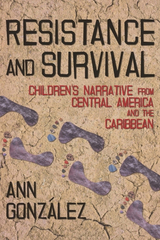 Resistance and Survival: Children’s Narrative from Central America and the Caribbean
Ann González
University of Arizona Press, 2009 In her analysis of some of the most interesting and important children’s literature from Central America and the Caribbean, Ann González uses postcolonial narrative theory to expose and decode what marginalized peoples say when they tell stories to their children—and how the interpretations children give these stories today differ from the ways they have read them in the past. González reads against the grain, deconstructing and critiquing dominant discourses to reveal consistent narrative patterns throughout the region that have helped children maneuver in a world dominated by powerful figures—from parents to agents of social control, political repression, and global takeover.
Many of these stories are in some way lessons in resistance and survival in a world where “the toughest kid on the block,” often an outsider, demands that a group of children “play or pay,” on his terms. González demonstrates that where traditional strategies have proposed the model of the “trickster” or the “paradoxically astute fool,” to mock the pretensions of the would-be oppressor, new trends indicate that the region’s children—and those who write for them—show increasing interest in playing the game on their own terms, getting to know the Other, embracing difference, and redefining their identity and role within the new global culture.
Resistance and Survival emphasizes the hope underlying this contemporary children’s literature for a world in which all voices can be heard and valued—the hope of an authentic happy ending.
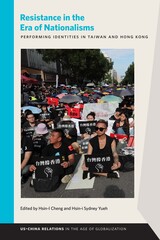 Resistance in the Era of Nationalisms: Performing Identities in Taiwan and Hong Kong
Hsin-I Cheng
Michigan State University Press, 2023 The desire of the people of Taiwan and Hong Kong to exercise democratic self-rule, fully embody their local identities, and become global citizens challenges the big-power politics between China and the United States. Occupying a critical stance on the margins, the local perspectives and international relations of these two cosmopolitan and postcolonial societies challenge both narratives centered on China and those focused on the U.S.–China power struggle. Taking a culture-centered approach to the communicative process of “glocalized resistance” in an era of rising nationalisms, the chapters in this volume address topics ranging from the rhetoric of political leaders and the language games of mass protesters on social media to resistant street performance. These chapters showcase the geocultural identity-in-the-making of the Taiwanese and Hong Kong people and offer insights into societies under imminent threat by an aggressive neighbor.
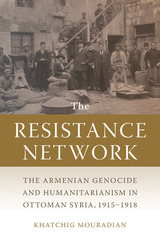 The Resistance Network: The Armenian Genocide and Humanitarianism in Ottoman Syria, 1915–1918
Khatchig Mouradian
Michigan State University Press, 2021 The Resistance Network is the history of an underground network of humanitarians, missionaries, and diplomats in Ottoman Syria who helped save the lives of thousands during the Armenian Genocide. Khatchig Mouradian challenges depictions of Armenians as passive victims of violence and subjects of humanitarianism, demonstrating the key role they played in organizing a humanitarian resistance against the destruction of their people. Piecing together hundreds of accounts, official documents, and missionary records, Mouradian presents a social history of genocide and resistance in wartime Aleppo and a network of transit and concentration camps stretching from Bab to Ras ul-Ain and Der Zor. He ultimately argues that, despite the violent and systematic mechanisms of control and destruction in the cities, concentration camps, and massacre sites in this region, the genocide of the Armenians did not progress unhindered—unarmed resistance proved an important factor in saving countless lives.
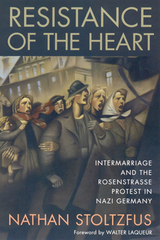 Resistance of the Heart: Intermarriage and the Rosenstrasse Protest in Nazi Germany
Nathan Stoltzfus
Rutgers University Press, 2001 In February 1943 the Gestapo arrested approximately 10,000 Jews remaining in Berlin. Most died at Auschwitz. Two thousand of those Jews, however, had non-Jewish partners and were locked into a collection center on a street called Rosenstrasse. As news of the surprise arrest pulsed through the city, hundreds of Gentile spouses, mostly women, hurried to the Rosenstrasse in protest. A chant broke out: "Give us our husbands back." Over the course of a week protesters vied with the Gestapo for control of the street. Now and again armed SS guards sent the women scrambling for cover with threats that they would shoot. After a week the Gestapo released these Jews, almost all of whom survived the war. The Rosenstrasse Protest was the triumphant climax of ten years of resistance by intermarried couples to Nazi efforts to destroy their families. In fact, ninety-eight percent of German Jews who did not go into hiding and who survived Nazism lived in mixed marriages. Why did Hitler give in to the protesters? Using interviews with survivors and thousands of Nazi records never before examined in detail, Nathan Stoltzfus identifies the power of a special type of resistance--the determination to risk one's own life for the life of loved ones. A "resistance of the heart..."
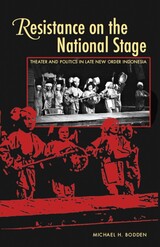 Resistance on the National Stage: Theater and Politics in Late New Order Indonesia
Michael H. Bodden
Ohio University Press, 2010 Resistance on the National Stage analyzes the ways in which, between 1985 and 1998, modern theater pracxadtitioners in Indonesia contributed to a rising movement of social protest against the long-governing New Order regime of President Suharto. It examines the work of an array of theater groups and networks from Jakarta, Bandung, and Yogyakarta that pioneered new forms of theater-making and new themes that were often presented more directly and critically than previous groups had dared to do. Michael H. Bodden looks at a wide range of case studies to show how theater contributed to and helped build the opposition. He also looks at how specific combinations of social groups created tensions and gave modern theater a special role in bridging social gaps and creating social networks that expanded the reach of the prodemocracy movement. Theater workers constructed new social networks by involving peasants, Muslim youth, industrial workers, and lower-middle-class slum dwellers in theater productions about their own lives. Such networking and resistance established theater as one significant arena in which the groundwork for the ouster of Suharto in May 1998, and the succeeding Reform era, was laid. Resistance on the National Stage will have broad appeal, not only for scholars of contemporary Indonesian culture and theater, but also for those interested in Indonesian history and politics, as well as scholars of postcolonial theater and culture.
 Resistance: The Essence of the Islamist Revolution
Alastair Crooke
Pluto Press, 2009 This book traces the essence of the Islamist Revolution from its origins in Egypt, through Najaf, Lebanon, Iran and the Iranian Revolution to today. Alastair Crooke presents a compelling account of the ideas and energy which are mobilising the Islamic world.
Crooke argues that the West faces a mass mobilisation against the US-led Western project. The roots of this conflict are described in terms of religious themes that extend back over 500 years. They represent clashing systems of thinking and values. Islamists have a vision for the future of their own societies which would entail radical change from Western norms. Resistance is presented as the means to force Western behaviour to change and to expose the essential differences between the two modes of thinking.
This is a rigourous account that traces the threads of revolution of various movements, including the influence of 'political Shi'ism' and the Iranian Revolution and its impact on Hezbollah and Hamas.
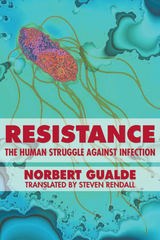 Resistance: The Human Struggle against Infection
Norbert Gualde
Dana Press, 2006
A North Carolina woman dies of a flesh-eating bacterial disease. Thousands of people in West Africa are suffering from cholera. And antibiotics are rapidly becoming less and less effective at fighting what were once mild infections. The biggest threat to the future of human society may not be terrorist attacks or nuclear war, but rather microscopic bacteria. Immunologist Norbert Gualde explains in Resistance the dangers we face from bacterial resistance, asserting that we must confront the reality awaiting us--the next fatal plague may occur sooner than we think.
Over the course of the twentieth century, incredible advances in medicine inspired a utopian belief among many that all common infectious diseases would eventually be eradicated. But Resistance shows that this dream is an impossible one. The book’s riveting narrative reveals how new infectious agents and diseases are being discovered every day and how bacteria previously thought to have been destroyed are returning with a vengeance. Drawing upon the history of past epidemics, Gualde explores how new outbreaks might be predicted and controlled. He also investigates the potentially devastating social and political impact of such public health disasters, particularly in underdeveloped countries in the southern hemisphere. He ultimately argues that the constant interaction between man and microorganisms will inevitably catalyze future epidemics similar to the horrific ones of centuries past.
Global outbreak monitoring and medical research on the human body’s immune system are beginning to produce effective strategies against bacterial resistance. But the most important weapon is awareness of the crisis, and this engrossing and brilliantly translated study will serve as a wake-up call for us all.
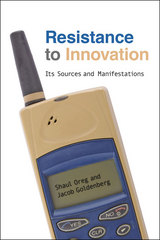 Resistance to Innovation: Its Sources and Manifestations
Shaul Oreg and Jacob Goldenberg
University of Chicago Press, 2015 Every year, about 25,000 new products are introduced in the United States. Most of these products fail—at considerable expense to the companies that produce them. Such failures are typically thought to result from consumers’ resistance to innovation, but marketers have tended to focus instead on consumers who show little resistance, despite these “early adopters” comprising only 20 percent of the consumer population.
Shaul Oreg and Jacob Goldenberg bring the insights of marketing and organizational behavior to bear on the attitudes and behaviors of the remaining 80 percent who resist innovation. The authors identify two competing definitions of resistance: In marketing, resistance denotes a reluctance to adopt a worthy new product, or one that offers a clear benefit and carries little or no risk. In the field of organizational behavior, employees are defined as resistant if they are unwilling to implement changes regardless of the reasons behind their reluctance. Seeking to clarify the act of rejecting a new product from the reasons—rational or not—consumers may have for doing so, Oreg and Goldenberg propose a more coherent definition of resistance less encumbered by subjective, context-specific factors and personality traits. The application of this tighter definition makes it possible to disentangle resistance from its sources and ultimately offers a richer understanding of consumers’ underlying motivations. This important research is made clear through the use of many real-life examples.
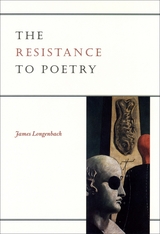 The Resistance to Poetry
James Longenbach
University of Chicago Press, 2005 Poems inspire our trust, argues James Longenbach in this bracing work, because they don't necessarily ask to be trusted. Theirs is the language of self-questioning—metaphors that turn against themselves, syntax that moves one way because it threatens to move another. Poems resist themselves more strenuously than they are resisted by the cultures receiving them.
But the resistance to poetry is quite specifically the wonder of poetry. Considering a wide array of poets, from Virgil and Milton to Dickinson and Glück, Longenbach suggests that poems convey knowledge only inasmuch as they refuse to be vehicles for the efficient transmission of knowledge. In fact, this self-resistance is the source of the reader's pleasure: we read poetry not to escape difficulty but to embrace it.
An astute writer and critic of poems, Longenbach makes his case through a sustained engagement with the language of poetry. Each chapter brings a fresh perspective to a crucial aspect of poetry (line, syntax, figurative language, voice, disjunction) and shows that the power of poetry depends less on meaning than on the way in which it means—on the temporal process we negotiate in the act of reading or writing a poem. Readers and writers who embrace that process, Longenbach asserts, inevitably recoil from the exaggeration of the cultural power of poetry in full awareness that to inflate a poem's claim on our attention is to weaken it.
A graceful and skilled study, The Resistance to Poetry honors poetry by allowing it to be what it is. This book arrives at a critical moment—at a time when many people are trying to mold and market poetry into something it is not.
Resistance To Theory
Paul De Man
University of Minnesota Press, 1986 Explores reasons why the theoretical enterprise is blind to, or “resists,” the radical nature of reading, in six essays that offer a new level of critical and cultural understanding in reference to the works of Jauss, Riffaterre, Benjamin, and Bakhtin. In a brilliant collection of essays, de Man explores his views, that, the resistance to theory is inherent in the theoretical enterprise itself, and the real debate is with its own methodological assumptions and possibilities. “Indispensable. . . . There is resistance to ‘theory’ and also confusion about its status with reference to both philosophy and criticism.” -Frank Kermode, Columbia University
 Resistance to Tuberculosis: Experimental Studies in Native and Acquired Defensive Mechanism
Max B. Lurie
Harvard University Press Now that it is realized that the chemotherapy of tuberculosis has not been as successful as had been hoped, attention is again being directed to the possibility of anti-tuberculosis vaccination. As a result, this analysis of the tuberculosis problem gains an added timeliness. Dr. Max Lurie, one of the foremost researchers in the field, presents a documentation and integration of forty years of investigation into the nature of native and acquired resistance to tuberculosis, together with a critical survey of much of the past and current literature on the subject. Interpretation of the experimental observations led to the formulation of unified concepts which may underlie the mechanisms of resistance to tuberculosis and the mode of action of some of the body forces which affect these mechanisms. In view of the present emphasis on molecular biological research, these new concepts promise a deeper understanding of the defensive mechanisms in resistance to infections in general and to tuberculosis in particular.
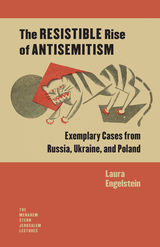 The Resistible Rise of Antisemitism: Exemplary Cases from Russia, Ukraine, and Poland
Laura Engelstein
Brandeis University Press, 2020 Antisemitism emerged toward the end of the nineteenth century as a powerful political movement with broad popular appeal. It promoted a vision of the world in which a closely-knit tribe called “the Jews” conspired to dominate the globe through control of international finance at the highest levels of commerce and money lending in the towns and villages. This tribe at the same time maneuvered to destroy the very capitalist system it was said to control through its devotion to the cause of revolution. It is easy to draw a straight line from this turn-of-the-century paranoid thinking to the murderous delusions of twentieth-century fascism. Yet the line was not straight.
Antisemitism as a political weapon did not stand unchallenged, even in Eastern Europe, where its consequences were particularly dire. In this region, Jewish leaders mobilized across national borders and in alliance with non-Jewish public figures on behalf of Jewish rights and in opposition to anti-Jewish violence. Antisemites were called to account and forced on the defensive. In Imperial and then Soviet Russia, in newly emerging Poland, and in aspiring Ukraine—notorious in the West as antisemitic hotbeds—antisemitism was sometimes a moral and political liability. These intriguing essays explore the reasons why, and they offer lessons from surprising places on how we can continue to fight antisemitism in our times.
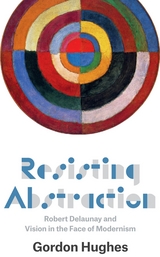 Resisting Abstraction: Robert Delaunay and Vision in the Face of Modernism
Gordon Hughes
University of Chicago Press, 2014 Robert Delaunay was one of the leading artists working in Paris in the early decades of the twentieth century, and his paintings have been admired ever since as among the earliest purely abstract works.
With Resisting Abstraction, the first English-language study of Delaunay in more than thirty years, Gordon Hughes mounts a powerful argument that Delaunay was not only one of the earliest artists to tackle abstraction, but the only artist to present his abstraction as a response to new scientific theories of vision. The colorful, optically driven canvases that Delaunay produced, Hughes shows, set him apart from the more ethereal abstraction of contemporaries like Kandinsky, Mondrian, Kazimir Malevich, and František Kupka. In fact, Delaunay emphatically rejected the spiritual motivations and idealism of that group, rooting his work instead in contemporary science and optics. Thus he set the stage not only for the modern artists who would follow, but for the critics who celebrated them as well.
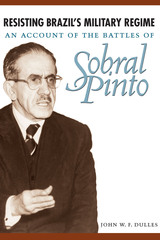 Resisting Brazil's Military Regime: An Account of the Battles of Sobral Pinto
By John W. F. Dulles
University of Texas Press, 2007 Praised by his many admirers as a "courageous and fearless" defender of human rights, Heráclito Fontoura Sobral Pinto (1893-1991) was the most consistently forceful opponent of the regime of Brazilian dictator Getúlio Vargas. John W. F. Dulles chronicled Sobral's battles with the Vargas government in Sobral Pinto, "The Conscience of Brazil": Leading the Attack against Vargas (1930-1945), which History: Reviews of New Books called "a must-read for anyone wanting to understand twentieth-century Brazil." In this second and final volume of his biography of Sobral Pinto, Professor Dulles completes the story of the fiery crusader's fight for democracy, morality, and justice, particularly for the downtrodden. Drawing on Sobral's vast correspondence, Dulles offers an extensive account of Sobral's opposition to the military regime that ruled Brazil from 1964 to 1985. He describes how Sobral Pinto defended those who had been politically influential before April, 1964, as well as other victims of the regime, including Communists, once-powerful labor leaders, priests, militant journalists, and students. Because Sobral Pinto participated in so many of the struggles against the military regime, his experiences provide vivid new insights into this important period in recent Brazilian history. They also shed light on developments in the Catholic Church (Sobral, a devout Catholic, vigorously opposed liberation theology), as well as on Sobral's key role in preserving Brazil's commission for defending human rights.
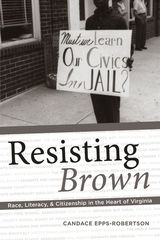 Resisting Brown: Race, Literacy, and Citizenship in the Heart of Virginia
Candace Epps-Robertson
University of Pittsburgh Press, 2018
Winner, 2018 CCCC Outstanding Book Award
Many localities in America resisted integration in the aftermath of the Brown v. Board of Education rulings (1954, 1955). Virginia’s Prince Edward County stands as perhaps the most extreme. Rather than fund integrated schools, the county’s board of supervisors closed public schools from 1959 until 1964. The only formal education available for those locked out of school came in 1963 when the combined efforts of Prince Edward’s African American community and aides from President John F. Kennedy’s administration established the Prince Edward County Free School Association (Free School). This temporary school system would serve just over 1,500 students, both black and white, aged 6 through 23.
Drawing upon extensive archival research, Resisting Brown presents the Free School as a site in which important rhetorical work took place. Candace Epps-Robertson analyzes public discourse that supported the school closures as an effort and manifestation of citizenship and demonstrates how the establishment of the Free School can be seen as a rhetorical response to white supremacist ideologies. The school’s mission statements, philosophies, and commitment to literacy served as arguments against racialized constructions of citizenship. Prince Edward County stands as a microcosm of America’s struggle with race, literacy, and citizenship.
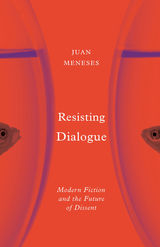 Resisting Dialogue: Modern Fiction and the Future of Dissent
Juan Meneses
University of Minnesota Press, 2019 A bold new critique of dialogue as a method of eliminating dissent
Is dialogue always the productive political and communicative tool it is widely conceived to be? Resisting Dialogue reassesses our assumptions about dialogue and, in so doing, about what a politically healthy society should look like. Juan Meneses argues that, far from an unalloyed good, dialogue often serves as a subtle tool of domination, perpetuating the underlying inequalities it is intended to address.
Meneses investigates how “illusory dialogue” (a particular dialogic encounter designed to secure consensus) is employed as an instrument that forestalls—instead of fostering—articulations of dissent that lead to political change. He does so through close readings of novels from the English-speaking world written in the past hundred years—from E. M. Forster’s A Passage to India and Jeanette Winterson’s The Passion to Indra Sinha’s Animal’s People and more. Resisting Dialogue demonstrates how these novels are rhetorical exercises with real political clout capable of restoring the radical potential of dialogue in today’s globalized world. Expanding the boundaries of postpolitical theory, Meneses reveals how these works offer ways to practice disagreement against this regulatory use of dialogue and expose the pitfalls of certain other dialogic interventions in relation to some of the most prominent questions of modern history: cosmopolitanism at the end of empire, the dangers of rewriting the historical record, the affective dimension of neoliberalism, the racial and nationalist underpinnings of the “war on terror,” and the visibility of environmental violence in the Anthropocene. Ultimately, Resisting Dialogue is a complex, provocative critique that, melding political and literary theory, reveals how fiction can help confront the deployment of dialogue to preempt the emergence of dissent and, thus, revitalize the practice of emancipatory politics.
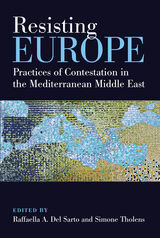 Resisting Europe: Practices of Contestation in the Mediterranean Middle East
Edited by Raffaella A. Del Sarto and Simone Tholens
University of Michigan Press, 2020 Resisting Europe conceptualizes the foreign policies of Europe—defined as the European Union and its member states—toward the states in its immediate southern “neighborhood” as semi-imperial attempts to turn these states into Europe’s southern buffer zone, or borderlands. In these hybrid spaces, different types of rules and practices coexist and overlap, and negotiations over meaning and implementation take place. This book examines the diverse modalities by which states in the Mediterranean Middle East and North Africa (MENA) reject, resist, challenge, modify, or entirely change European policies and preferences and provides rich empirical evidence of these contestation practices in the fields of migration and border control, banking and finance, democracy promotion and telecommunications. It addresses the complex question of when and how MENA states capitalize on their leverage and interdependence in their relationships with Europe and contributes to a more comprehensive understanding of Europe-Middle East relations, while engaging with broader debates on power and interdependence, order and contestation in international relations. While a contribution on the practices of resistance and contestation of MENA states vis-à-vis European policies and preferences in this geopolitically significant region was overdue, this volume leads the way for subsequent studies that seek to overcome the constraints of exceptionalism so characteristic of research of the Middle East, Europe/the European Union, and certainly of their relationship.
 Resisting Extractivism: Peruvian Gold, Everyday Violence, and the Politics of Attention
Michael Wilson Becerril
Vanderbilt University Press, 2021 ACRL's Choice Outstanding Academic Title of 2021
Peru is classified as one of the deadliest countries in the world for environmental defenders, where activists face many forms of violence. Through an ethnographic and systematic comparison of four gold-mining conflicts in Peru, Resisting Extractivism presents a vivid account of subtle and routine forms of violence, analyzing how meaning-making practices render certain types of damage and suffering noticeable while occluding others. The book thus builds a theory of violence from the ground up—how it is framed, how it impacts people’s lived experiences, and how it can be confronted. By excavating how the everyday interactions that underlie conflicts are discursively concealed and highlighted, this study assists in the prevention and transformation of violence over resource extraction in Latin America.
The book draws on a controlled, qualitative comparison of four case studies, extensive ethnographic research conducted over fourteen months of fieldwork, analysis of over nine hundred archives and documents, and unprecedented access to more than 250 semi-structured interviews with key actors across industry, the state, civil society, and the media. Michael Wilson Becerril identifies, traces, and compares these dynamics to explain how similar cases can lead to contrasting outcomes—insights that may be usefully applied in other contexts to save lives and build better futures.
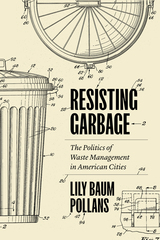 Resisting Garbage: The Politics of Waste Management in American Cities
Lily Baum Pollans
University of Texas Press, 2021 Resisting Garbage presents a new approach to understanding practices of waste removal and recycling in American cities, one that is grounded in the close observation of case studies while being broadly applicable to many American cities today. Most current waste practices in the United States, Lily Baum Pollans argues, prioritize sanitation and efficiency while allowing limited post-consumer recycling as a way to quell consumers’ environmental anxiety. After setting out the contours of this “weak recycling waste regime,” Pollans zooms in on the very different waste management stories of Seattle and Boston over the last forty years. While Boston’s local politics resulted in a waste-export program with minimal recycling, Seattle created new frameworks for thinking about consumption, disposal, and the roles that local governments and ordinary people can play as partners in a project of resource stewardship. By exploring how these two approaches have played out at the national level, Resisting Garbage provides new avenues for evaluating municipal action and fostering practices that will create environmentally meaningful change.
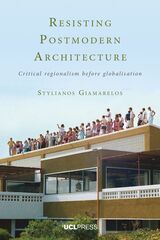 Resisting Postmodern Architecture: Critical Regionalism before Globalisation
Stylianos Giamarelos
University College London, 2022 A critical reappraisal of one of the most popular architectural theories of the recent past on its fortieth anniversary.
Since its first appearance in 1981, critical regionalism has enjoyed a celebrated worldwide reception as an architectural theory that defends the cultural identity of a place resisting the homogenizing onslaught of globalization. Its principles of acknowledging the climate, history, materials, culture, and topography of a specific place are integrated into architects’ education across the globe. But at the same time, the richer cross-cultural history of critical regionalism has frequently been reduced to schematic juxtapositions of “the global” with “the local.”
This book uses more than fifty interviews and previously unpublished archival material from six countries to resituate critical regionalism within the wider framework of debates around postmodern architecture, the diverse contexts from which it emerged, and the cultural media complex that conditioned its reception. In so doing, it explores the intersection of three areas of growing historical and theoretical interest—postmodernism, critical regionalism, and globalization—and shows how the “periphery” was not just a passive recipient, but also an active generator of architectural theory and practice.
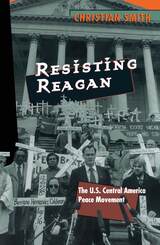 Resisting Reagan: The U.S. Central America Peace Movement
Christian Smith
University of Chicago Press, 1996 A comprehensive analysis of the U.S. Central America peace movement, Resisting Reagan explains why more than one hundred thousand U.S. citizens marched in the streets, illegally housed refugees, traveled to Central American war zones, committed civil disobedience, and hounded their political representatives to contest the Reagan administration's policy of sponsoring wars in Nicaragua and El Salvador.
Focusing on the movement's three most important national campaigns—Witness for Peace, Sanctuary, and the Pledge of Resistance—this book demonstrates the centrality of morality as a political motivator, highlights the importance of political opportunities in movement outcomes, and examines the social structuring of insurgent consciousness. Based on extensive surveys, interviews, and research, Resisting Reagan makes significant contributions to our understanding of the formation of individual activist identities, of national movement dynamics, and of religious resources for political activism.
 Resisting Regionalism: Gender And Naturalism In American Fiction, 1885-1915
Donna Campbell
Ohio University Press, 1997 When James Lane Allen defined the “Feminine Principle” and the “Masculine Principle” in American fiction for the Atlantic Monthly in 1897, he in effect described local color fiction and naturalism, two branches of realism often regarded as bearing little relationship to each other. In this award-winning study of both movements, Resisting Regionalism explores the effect the cultural dominance of women’s local color fiction in the 1890’s had on young male naturalist writers, who rebelled against the local colorists and their “teacup tragedies.” An immensely popular genre, local color fiction reached its peak in the 1880s in such literary journals as Harper’s Monthly, Scribner’s, the Atlantic Monthly, and the Century. These short stories exhibited local “characters,” depicted marginal groups and vanishing folkways, and addressed issues of absence, loss, limitation, and the past. Despite such prickly themes, according to Donna Campbell, local color fiction “fulfilled some specific needs of the public – for nostalgia, for a retreat into mildly exotic locales, for a semblance of order preserved in ritual.” By the turn of the century, however, local color fiction was fading from the scene, supplanted by writers of adventure fiction and historical romances, with whom local colorists increasingly merged, and opposed by the naturalists. In examining this historic shift, Resisting Regionalism shows that far from being distanced from local color fiction, nationalism emerged in part as a dissenting response to its popularity and to the era’s concerns about the dominance of feminine influence in American literature. The new generation of authors, including Crane, Norris, London, Frederic, Wharton, resisted the cultural myths and narrative strategies common to local colorists Sarah Orne Jewett, Rose Terry Cooke, Mary E. Wilkins Freeman, and Constance Fenimore Woolson. Yet, as Campbell underscores in her analysis of Stephan Crane’s The Monster, the naturalists could, and did, integrate local color conventions with the grotesque and horrifying to powerful effect. In clear, accessible prose, Resisting Regionalism provides fresh readings of naturalistic works in the context of the dispute between local color and naturalism. In the process, this book shows the debt naturalism owes to local color fiction and illuminates a neglected but significant literary era.
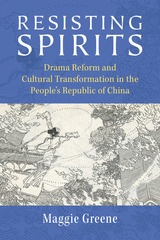 Resisting Spirits: Drama Reform and Cultural Transformation in the People's Republic of China
Maggie Greene
University of Michigan Press, 2019 Resisting Spirits is a reconsideration of the significance and periodization of literary production in the high socialist era, roughly 1953 through 1966, specifically focused on Mao-era culture workers’ experiments with ghosts and ghost plays. Maggie Greene combines rare manuscript materials—such as theatre troupes’ annotated practice scripts—with archival documents, memoirs, newspapers, and films to track key debates over the direction of socialist aesthetics. Through arguments over the role of ghosts in literature, Greene illuminates the ways in which culture workers were able to make space for aesthetic innovation and contestation both despite and because of the constantly shifting political demands of the Mao era. Ghosts were caught up in the broader discourse of superstition, modernization, and China’s social and cultural future. Yet, as Greene demonstrates, the ramifications of those concerns as manifested in the actual craft of writing and performing plays led to further debates in the realm of literature itself: If we remove the ghost from a ghost play, does it remain a ghost play? Does it lose its artistic value, its didactic value, or both? At the heart of Greene’s intervention is “just reading”: the book regards literature first as literature, rather than searching immediately for its political subtext, and the voices of dramatists themselves finally upstage those of Mao’s inner circle. Ironically, this surface reading reveals layers of history that scholars of the Mao era have often ignored, including the ways in which social relations and artistic commitments continued to inform the world of art. Resisting Spirits thus illuminates the origins of more famous literary inquisitions, showing how the arguments surrounding ghost plays and the fates of their authors place the origins of the Cultural Revolution several years earlier, with a radical new shift in the discourse of theatre.
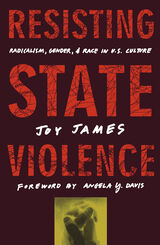 Resisting State Violence: Radicalism, Gender, and Race in U.S. Culture
Joy James
University of Minnesota Press, 1996 An incendiary critique of contemporary American society that also offers concrete solutions for the dilemmas facing progressive politics. As the political climate of the United States moves rightward, effective and visionary voices from the left become both rarer and more essential. In Resisting State Violence, African American scholar-activist Joy James provides such a voice. Taking the convergence of race, gender, and class as fundamental trajectories, James offers a stimulating and iconoclastic account of a world in which the United States functions as the political-police center. At its core, Resisting State Violence is about the many ways the current structure of American government and society is inimical to human rights. James examines the prevalence of racist violence in U.S. policies, making provocative connections between seemingly disparate themes and events, and always, insistently, linking global and U.S. domestic politics. She creates a picture of a nation that consistently uses dehumanization to normalize and rationalize violence in foreign policy, all the while creating a domestic climate that pathologizes blackness and sexuality, portraying those most vulnerable to violence as its carriers. In the systematic and ubiquitous nature of state violence, however, James sees a possibility of hope in the building of coalitions across race, class, gender, and national divides. She argues that the very commonality that makes the system seem so overpowering can serve as the basis for resistance-that the elements that hold together a web of oppression and misuse of power also mark its vulnerabilities, especially when confronted with an equally systematic resistance. James offers concrete solutions for the dilemmas facing progressive politics and the individuals who work to achieve social justice. Resisting State Violence is a clear-sighted and uncompromising guidebook for those who want to understand the forces that hinder social change, and to effectively move beyond them.
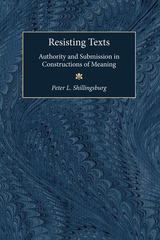 Resisting Texts: Authority and Submission in Constructions of Meaning
Peter L. Shillingsburg
University of Michigan Press, 1998 "It is with no desire or hope to promote a correct or superior form of textuality, with no desire to correct a so-called interpretive or editorial textual abuse, nor any attempt to prevent anyone from doing anything imaginable with texts or books that I have undertaken this book. . . ." So writes Peter Shillingsburg in his introduction to this series of meditations on the possibilities of deriving "meaning" from the texts we read.
Shillingsburg argues that as humans we are and always will be interested in the past, in what was meant, in what was revealed inadvertently by a text--and that is all to the good. But we learn more and can compare notes better when we understand the principles that govern the ways we read. Resisting Texts approaches crucial questions about the practice of textual editing and literary criticism by posing questions in the form "If we take such and such to be the goal of our reading, then what will follow from that assumption?"
With humor and a lively imagination, Shillingsburg takes the reader on a fresh theoretical investigation of communication, understanding and misunderstanding, and textual satisfactions, drawing examples from Thackeray, Wordsworth, Melville, and others.
Resisting Texts will appeal to all who enjoy the varieties of critical approaches to the written word.
Peter L. Shillingsburg is Professor of English, University of North Texas.
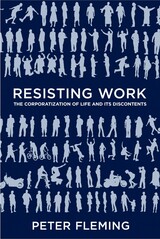 Resisting Work: The Corporatization of Life and Its Discontents
Peter Fleming
Temple University Press, 2015 A job is no longer something we "do," but instead something we "are." As the boundaries between work and non-work have dissolved, we restructure ourselves and our lives using social ingenuity to get things done and be resourceful outside the official workday. In his provocative book, Resisting Work Peter Fleming insists that many jobs in the West are now regulated by a new matrix of power-biopower-where "life itself" is put to work through our ability to self-organize around formal rules. This neoliberal system of employment tries to absorb our life attributes--from our consumer tastes, "downtime," and sexuality--into employment so that questions of human capital and resources replace questions of employee, worker, and labor. Fleming then suggests that the corporation turns to communal life-what he calls "the common"-in order to reproduce itself and reinforce corporate culture. Yet a resistance against this new definition of work is in effect, and Fleming shows how it may already be taking shape.
Resistrata
Donna Zuckerberg
Harvard University Press
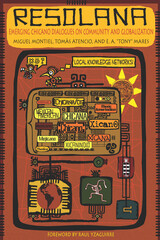 Resolana: Emerging Chicano Dialogues on Community and Globalization
Miguel Montiel
University of Arizona Press, 2009 Villagers in northern New Mexico refer to the south-facing side of a wall as la resolana, meaning “the place where the sun shines.” Every culture has a resolana, a place where the resolaneros—the villagers—gather, dialogue, and reflect on society, culture, and politics. The buried knowledge that emerges from this process may be “pure gold,” or el oro del barrio, a metaphor for the culturally contextualized knowledge gathered at the resolana.
Coming from diverse backgrounds in social work, sociology, public administration, literature, history, and education, three modern resolaneros take the twin concepts of resolana and el oro del barrio on a breathtaking journey from their rural roots to their application in an urban setting and on to a holistic view of globalization. The authors offer a humane perspective on transborder cultures and all communities struggling to maintain their cultural and linguistic identities. They share an optimistic view of how ordinary people everywhere can take back control of their own destinies. This book is about uncovering subjugated knowledge—el oro del barrio—through resolana, a dynamic process of thought and action.
Resolana will inspire dialogue and creativity from those interested in sociology, political science, social work, and Chicano studies, as well as public-policy makers and the general public.
The Resolution of African Conflicts: The Management of Conflict Resolution and Post-Conflict Reconstruction
Alfred Nhema
Ohio University Press, 2007 “These two volumes clearly demonstrate the efforts by a wide range of African scholars to explain the roots, routes, regimes and resolution of African conflicts and how to re-build post-conflict societies. They offer sober and serious analyses, eschewing the sensationalism of the western media and the sophistry of some of the scholars in the global North for whom African conflicts are at worst a distraction and at best a confirmation of their pet racist and petty universalist theories.”
—From the introduction by Paul Tiyambe Zeleza
This book offers analyses of a range of African conflicts and demonstrates that peace is too important to be left to outsiders.
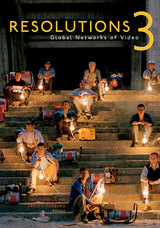 Resolutions 3: Global Networks of Video
Ming-Yuen S. Ma
University of Minnesota Press, 2012 Resolutions 3 explores the wide-ranging implications of video art and video-based production in contemporary media culture. It is the third volume in a series composed of Resolution: A Critique of Video Art (1986) and Resolutions: Contemporary Video Practices (1996). While Resolution was one of the first critical texts on video art in the United States, Resolutions was one of the first books to address video as a medium across disciplines from theoretical, activist, and transnational perspectives. Resolutions 3 articulates this legacy as a challenge to reengage with the explosive viral reach of moving image–based content and its infiltration into and impact on culture and everyday life. The contributors to this work analyze what is now a fourth decade of video practices as marked within and outside the margins of art production, networked interventions, projected spectacle, museum entombment, or 24/7 streaming. Intending to broaden, contest, and amplify the mediated space that was defined by its two predecessors, this volume investigates the ever-changing state of video’s deployment as examiner, tool, journal reportage, improvisation, witness, riff, leverage, and document. Contributors: Kathleen Ash-Milby, Smithsonian National Museum of the American Indian; Myriam-Odile Blin, Rouen U, France; Nancy Buchanan, California Institute of the Arts; Derek A. Burrill, U of California, Riverside; Sean Cubitt, U of Melbourne; Faisal Devji, New York U; Jennifer Doyle, U of California, Riverside; Jennifer Friedlander, Pomona College; Kathy High, Rensselaer Polytechnic Institute; Lucas Hilderbrand, U of California, Irvine; Nguyen Tan Hoang, Bryn Mawr College; Kathy Rae Huffman; Amelia Jones, McGill U; David Joselit, Yale U; Alexandra Juhasz, Pitzer College; Jessica Lawless, Santa Fe Community College; Hea Jeong Lee; Jesse Lerner, Pitzer College; Akira Mizuta Lippit, U of Southern California; Lionel Manga; Laurence A. Rickels, U of California, Santa Barbara; Kenneth Rogers, U of California, Riverside; Michael Rush, Eli and Edythe Broad Art Museum, Michigan State U; Freya Schiwy, U of California, Riverside; Beverly R. Singer, U of New Mexico; Yvonne Spielmann, U of the West of Scotland; Catherine Taft, Getty Research Institute; Holly Willis, U of Southern California.
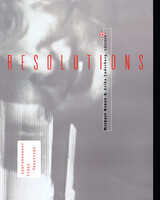 Resolutions: Contemporary Video Practices
Michael Renov
University of Minnesota Press, 1995 Explores the state of the art, practice, and theory of video.
Here is, by far, the best, boldest, and most thorough account to date of video art and activism, practice and theory. The long-awaited follow-up to a project conducted by Los Angeles Contemporary Exhibitions (LACE), this volume comprises original articles by many of the most interesting video artists, filmmakers, and critical theorists writing today. Their subjects, from video pedagogy to emerging technologies, are many and varied and together constitute a clear and complete picture of the state of the medium.
Constructed like an inquiry into newly forming video practice, the collection at once interweaves and questions a series of relationships among politics, popular culture, artistic intervention, and social practices of the media. The often provocative essays, on topics ranging from video porn to Geraldo Rivera to lesbian representation to the politics of video memory, contribute significantly to a much-needed reconceptualization of the electronic medium.
"Resolutions is a collection of 24 essays that span the broad realm of video today, considering practices both within and outside the territory of fine art." Guggenheim Magazine
"This volume provides valuable insight into the innovative practices which are helping to shape video making. If you find yourself wondering about the art of video, the state of the medium, where it's all going, you'll find this collection of essays both informative and thought provoking." Journal of Educational Media
"This work offers an up-to-date account of video art and activism, practice and theory. The work focuses on the technical political, social and esthetic dimension of the medium, interweaving description of past events and projects with state-of-the-art consideration of technologies and direction of change. This work is very likely to become the essential text to begin to understand this widely transitional art style. Highly recommended." The Reader's Review
Contributors: Rosanna Albertini, Raymond Bellour, John Belton, Gregg Bordowitz, Ron Burnett, Jacques Derrida, Sara Diamond, Monica Frota, Bill Horrigan, David E. James, Laura Kipnis, Tetsuo Kogawa, Judith Mayne, James Moran, Michael Nash, Chon Noriega, Bérénice Reynaud, Marlon Riggs; Marita Sturken, Christine Tamblyn, Maureen Turim, and Patricia Zimmermann.
Michael Renov is professor of critical studies in the School of Cinema-Television at the University of Southern California. He is the author of Hollywood's Wartime Woman: Representation and Ideology (1988), and the editor of Theorizing Documentary (1993). Erika Suderburg is a video artist and associate professor in the Department of Art at the University of California, Riverside.
Resolving Disputes Between Nations: Coercion or Conciliation?
Martin Patchen
Duke University Press, 1988 The use of force and coercion to settle disputes between nations is a central problem of our time. Martin Patchen considers the circumstances that lead nations to use coercive means in disputes with other nations and also examines the effectiveness of other means of resolving international disputes. Patchen examines conflict and cooperation as general social processes and builds on previous work to present an overall theoretical framework that encompasses the conflict situation, perceptions of the adversary, decision-making, bargaining, and interaction and influence sequences.
Resolving International Conflicts
Peter Hay
Central European University Press, 2009 While focusing on international private law and international arbitration, the essays also address the questions of constitutional law and legal philosophy. State-of-the-art contributions, covering a wide scope from the practical analysis of American arbitration policy and the position of the USA vis-à-vis international law, through the latest developments in German legal practice, to theoretical issues of jurisdiction. Especially rich is the volume in exploring the legal dimension of the European integration process.
 Resolving Racial Conflict: The Community Relations Service and Civil Rights, 1964-1989
Bertram Levine
University of Missouri Press, 2005
In 1964, when the Civil Rights Act was passed, Congress wisely created an agency based in the U.S. Department of Justice to help forestall or resolve racial or ethnic disputes evolving from the act. Mandated by law and by its own methodology to shun publicity, the Community Relations Service developed self-effacement to a fine art. Thus the accomplishments, as well as the shortcomings, of this federal venture into conflict resolution are barely known in official Washington, and even less so by the American public. This first written history of the Community Relations Service uses the experiences of the men and women who sought to resolve the most volatile issues of the day to tell the fascinating story of this unfamiliar agency.
This multiracial cadre of conciliation and mediation specialists worked behind the scenes in more than 20,000 confrontations involving racial and ethnic minorities. From Selma to Montgomery, at the encampment of the Poor Peoples’ Campaign in Resurrection City, to the urban riots of the sixties, seventies, and eighties, from the school desegregation battles north and south, at the siege of Wounded Knee, and during the Texas Gulf Coast fishing wars between Southeast Asian refugees and Anglos, these federal peacemakers lessened the atmosphere of racial violence in every major U.S. city and thousands of small towns.
These confrontations ranged from disputes that attracted worldwide attention to the everyday affronts, assaults, and upheavals that marked the nation’s adjustment to wider power sharing within an increasingly diverse population. While Resolving Racial Conflict examines some of the celebrated breakthroughs that made change possible, it also delves deeply into the countless behind-the-scenes local efforts that converted possibility to reality.
Among the many themes in this book that provide new perspective for understanding racial conflict in America are the effects of protest and conflict in engineering social change; the variety of civil rights views and experiences of African Americans, Native Americans, Asians, and Hispanics; the role of police in minority relations; and the development and refinement of techniques for community conflict resolution from seat-of-the-pants intervention to sophisticated professional practice. Resolving Racial Conflict will appeal to students of civil rights and American history in both the general and academic communities, as well as students of alternative dispute resolution and peace and conflict studies.
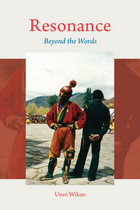 Resonance: Beyond the Words
Unni Wikan
University of Chicago Press, 2012 Resonance gathers together forty years of anthropological study by a researcher and writer with one of the broadest fieldwork résumés in anthropology: Unni Wikan. In its twelve essays—four of which are brand new—Resonance covers encounters with transvestites in Oman, childbirth in Bhutan, poverty in Cairo, and honor killings in Scandinavia, with visits to several other locales and subjects in between. Including a comprehensive preface and introduction that brings the whole work into focus, Resonance surveys an astonishing career of anthropological inquiry that demonstrates the possibility for a common humanity, a way of knowing others on their own terms. Deploying Clifford Geertz’s concept of “experience-near” observations —and driven by an ambition to work beyond Geertz’s own limitations—Wikan strives for an anthropology that sees, describes, and understands the human condition in the models and concepts of the people being observed. She highlights the fundamentals of an explicitly comparative, person-centered, and empathic approach to fieldwork, pushing anthropology to shift from the specialist discourses of academic experts to a grasp of what the Balinese call keneh— the heart, thought, and feeling of the real people of the world. By deploying this strategy across such a range of sites and communities, she provides a powerful argument that ever-deeper insight can be attained despite our differences.
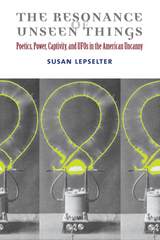 The Resonance of Unseen Things: Poetics, Power, Captivity, and UFOs in the American Uncanny
Susan Lepselter
University of Michigan Press, 2016 The Resonance of Unseen Things offers an ethnographic meditation on the “uncanny” persistence and cultural freight of conspiracy theory. The project is a reading of conspiracy theory as an index of a certain strain of late 20th-century American despondency and malaise, especially as understood by people experiencing downward social mobility. Written by a cultural anthropologist with a literary background, this deeply interdisciplinary book focuses on the enduring American preoccupation with captivity in a rapidly transforming world. Captivity is a trope that appears in both ordinary and fantastic iterations here, and Susan Lepselter shows how multiple troubled histories—of race, class, gender, and power—become compressed into stories of uncanny memory.
“We really don’t have anything like this in terms of a focused, sympathetic, open-minded ethnographic study of UFO experiencers. . . . The author’s semiotic approach to the paranormal is immensely productive, positive, and, above all, resonant with what actually happens in history.”
—Jeffrey J. Kripal, J. Newton Rayzor Professor of Religion, Rice University
“Lepselter relates a weave of intimate alien sensibilities in out-off-the-way places which are surprisingly, profoundly, close to home. Readers can expect to share her experience of contact with complex logics of feeling, and to do so in a contemporary America they may have thought they understood.”
—Debbora Battaglia, Mount Holyoke College
“An original and beautifully written study of contemporary American cultural poetics. . . . The book convincingly brings into relief the anxieties of those at the margins of American economic and civic life, their perceptions of state power, and the narrative continuities that bond them to histories of violence and expansion in the American West.”
—Deirdre de la Cruz, University of Michigan
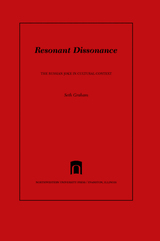 Resonant Dissonance: The Russian Joke in Cultural Context
Seth Graham
Northwestern University Press, 2009 In his original new study, Seth Graham analyzes a rich and forgotten vein of humor in an otherwise bleak environment. The late Soviet period (1961–1986) hardly seems fertile ground for humor, but Russian jokes (anekdoty) about life in the Soviet Union were ubiquitous. The cultural and political relaxation in the decade following Stalin’s death produced considerable optimism among Soviet citizens. The anekdot exploited and exposed what Graham calls "Soviet diglossia" (official Sovietese vs. Russian everyday language) and emphasized the distance between official myths and quotidian reality. Jokes engaged a range of official and popular culture genres and also worked meta-textually, referring to the political consequences of jokes. While the dissidents of this period, who stressed the heroic and opposed everything Soviet, have been much written about, Graham’s work on the anekdoty—written in the third person, ironic, and engaged with everything Soviet—fills a hole that has been overlooked in cultural history.
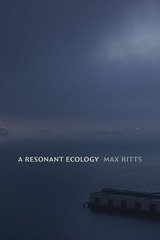 A Resonant Ecology
Max Ritts
Duke University Press, 2024 In A Resonant Ecology, Max Ritts traces how sound’s integration into the environmental politics of Canada’s North Coast has paved the way for massive industrial expansion. While conservationists hope that the dissemination of whale songs and other nature sounds will showcase the beauty of local wildlife for people around the world, Ritts reveals how colonial capitalism can co-opt sonic efforts to protect the coast. He demonstrates how digital technologies allow industry to sonically map new shipping lanes and facilitate new ways of experiencing sound—premised not on listening, but on sound’s exploitable status as a data resource. By outlining how sound can both perpetuate and refuse capitalist colonialism, Ritts challenges the idea that the sonic realm is inherently liberatory and reveals sound to be a powerfully uncertain object. Through a situated geographical approach, he makes the case that only a decolonial and multigenerational environmental politics can counter the false promise of “sustainable marine development” held up by industry and the state.
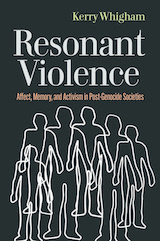 Resonant Violence: Affect, Memory, and Activism in Post-Genocide Societies
Kerry Whigham
Rutgers University Press, 2022 From the Holocaust in Europe to the military dictatorships of Latin America to the enduring violence of settler colonialism around the world, genocide has been a defining experience of far too many societies. In many cases, the damaging legacies of genocide lead to continued violence and social divisions for decades. In others, however, creative responses to this identity-based violence emerge from the grassroots, contributing to widespread social and political transformation. Resonant Violence explores both the enduring impacts of genocidal violence and the varied ways in which states and grassroots collectives respond to and transform this violence through memory practices and grassroots activism. By calling upon lessons from Germany, Poland, Argentina, and the Indigenous United States, Resonant Violence demonstrates how ordinary individuals come together to engage with a violent past to pave the way for a less violent future.
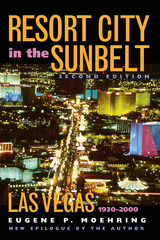 Resort City In The Sunbelt, Second Edition: Las Vegas, 1930-2000
Eugene P. Moehring
University of Nevada Press, 2000 Resort City in the Sunbelt is a non-sensationalistic, scholarly account of Las Vegas from the building of the Hoover Dam to the construction of the MGM Grand Hotel. Historian Eugene Moehring provides a balanced view of the city’s urban development. Although a unique city in many ways, Las Vegas has displayed characteristics common to other sunbelt cities across the western United States—including underfunded social services, low-density urbanization with a heavy reliance upon automobiles, a sluggish response to problems within minority communities, a preference for efficient, business-like government, and a mania for low taxes. The gaming and resort aspects are fully considered, but Moehring emphasizes the city as part of the continually expanding sunbelt. From this important study, historians will conclude that, despite some of its unusual traits, Las Vegas is much like other western cities and therefore deserves recognition as one of the fastest-growing centers in postwar America. In a new and expanded epilogue to this edition, Moehring looks at the major events of the three decades leading up to 2000 and their underpinnings.
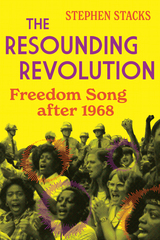 The Resounding Revolution: Freedom Song after 1968
Stephen Stacks
University of Illinois Press, 2025 Far from being bounded by the timeframe of the 1960s, freedom song continues to evolve as a tool both of historical memory and of present activism. Stephen Stacks looks at how post-1968 freedom song helps us negotiate our present relationship to the era while at the same time sustaining the contemporary struggle inspired by it. Stacks’s analysis shifts the focus of attention from genre--freedom song--to process and practice--freedom singing. As he shows, freedom singing after 1968 generates multilayered meanings. It can reinforce, or resist, consensus memories or dominant narratives. Stacks illuminates freedom singing’s diversity by examining it in three contexts: performance, protest, and within documentary sound recording/film. Insightful and vividly detailed, The Resounding Revolution examines sixty years of Black music to challenge and reshape the entrenched story of the Civil Rights Movement.
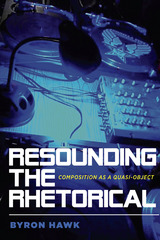 Resounding the Rhetorical: Composition as a Quasi-Object
Byron Hawk
University of Pittsburgh Press, 2018 Resounding the Rhetorical offers an original critical and theoretical examination of composition as a quasi-object. As composition flourishes in multiple media (digital, sonic, visual, etc.), Byron Hawk seeks to connect new materialism with current composition scholarship and critical theory. Using sound and music as his examples, he demonstrates how a quasi-object can and does materialize for communicative and affective expression, and becomes a useful mechanism for the study and execution of composition as a discipline. Through careful readings of Serres, Latour, Deleuze, Heidegger, and others, Hawk reconstructs key concepts in the field including composition, process, research, collaboration, publics, and rhetoric. His work delivers a cutting-edge response to the state of the field, where it is headed, and the possibilities for postprocess and postwriting composition and rhetoric.
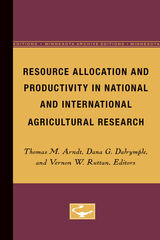 Resource Allocation and Productivity in National and International Agricultural Research
Thomas Arndt
University of Minnesota Press, 1977
Resource Allocation and Productivity in National and International Agricultural Research was first published in 1977.Agricultural research in developing countries has grown rapidly in recent years. As the research system has expanded, questions about the productivity of research and the allocation of research resources have become important issues for development planners, science managers, donor agencies, and other individuals and institutions concerned with research operations and opportunities.In this volume, forty contributors - natural and social scientists and research administrators - provide a comprehensive analysis of the implications of agricultural science and technology for agricultural development. They examine recent evidence on the returns to investment in national and international agricultural research systems and explore the relevance of social and economic factors for the organization and management of these systems. In a final section they discuss research strategy and management issues that will affect the future productivity and organization of both the international and the national research systems.The material is based on papers given at a conference held at Airlie House, Virginia, sponsored by the Agricultural Development Council. Funding was provided through the U.S. Agency for International Development (USAID), support of the Council’s Research Training and Network Program, and by additional assistance from the World Bank.
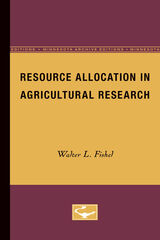 Resource Allocation in Agricultural Research
Walter Fishel
University of Minnesota Press, 1971
Resource Allocation in Agricultural Research was first published in 1971.The new knowledge produced by research has accounted for an increasing share of national economic growth in this country. As the economic importance of research has risen, the emerging problems attendant on the allocation of resources to research has attracted increased professional attention.This book presents the views and findings of a number of experts concerned with the problems, issues, and procedures involved in the allocation of resources for agricultural research. The twenty-one contributors include agricultural and general economists, public administration officials, scientists, and other specialists. The chapters are based on papers given at a symposium which was sponsored jointly by the Minnesota Agricultural Experiment Station and the Cooperative States Research Service of the U.S. Department of Agriculture.In his preface Walter L. Fishel, the volume editor, explains: “While the symposium participants presented varying points of view and different approaches to the problems on resource allocation in agricultural research, they generally shared the orientation of economic theory. Both the issues examined and the debate reflect this perspective. The general assumption was that the allocation problem to a considerable extent can be approached within an economic framework. More specifically, it was generally agreed that research may be viewed as an economic activity since it requires scarce resources and produces something of value.”After an introductory chapter which explains the problems and issues, the rest of the volume is divided into sections on research and welfare, investments in research, decision making in practice, and decision making experiments.
 Resource Allocation in Higher Education
William F. Massy, Editor
University of Michigan Press, 1996 Resource Allocation in Higher Education describes how colleges, universities, and government agencies can use budgeting processes to improve program planning and productivity. Drawn from the contributors' direct experiences as well as research findings, it blends conceptual foundations with practical insights. Many resource allocation processes in higher education need reform, and this volume will stimulate and assist that effort.
Beginning with the economic theory of nonprofits, the essays examine current budgeting systems in both theoretical and practical terms. Resource allocation systems from other domains such as health care are explored for relevant insights. Throughout, decentralization remains a major theme. Topics range from the eminently practical--how to establish a global accounting system or choose an endowment spending rate--to the more abstract--the theory of how various nonprofit enterprises balance academic values against market pressures. The volume ends by proposing value responsibility budgeting, which offers institutions a potentially better way of pursuing their academic values while remaining responsive to market pressures.
Those within higher education institutions who are responsible for resource allocation, such as provosts, chief financial officers, or budget directors, will find much that speaks to them. While mostly in the domain of higher education economics, management, and planning, the essays are written for any serious reader concerned with the problem of reform in higher education.
William F. Massy is Professor of Education and Business Administration at Stanford University.
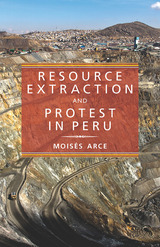 Resource Extraction and Protest in Peru
Moises Arce
University of Pittsburgh Press, 2014 Natural resource extraction has fueled protest movements in Latin America and existing research has drawn considerable scholarly attention to the politics of antimarket contention at the national level, particularly in Ecuador, Bolivia, and Argentina. Despite its residents reporting the third-highest level of protest participation in the region, Peru has been largely ignored in these discussions.
In this groundbreaking study, Moisés Arce exposes a longstanding climate of popular contention in Peru. Looking beneath the surface to the subnational, regional, and local level as inception points, he rigorously dissects the political conditions that set the stage for protest. Focusing on natural resource extraction and its key role in the political economy of Peru and other developing countries, Arce reveals a wide disparity in the incidence, forms, and consequences of collective action.
Through empirical analysis of protest events over thirty-one years, extensive personal interviews with policymakers and societal actors, and individual case studies of major protest episodes, Arce follows the ebb and flow of Peruvian protests over time and space to show the territorial unevenness of democracy, resource extraction, and antimarket contentions. Employing political process theory, Arce builds an interactive framework that views the moderating role of democracy, the quality of institutional representation as embodied in political parties, and most critically, the level of political party competition as determinants in the variation of protest and subsequent government response. Overall, he finds that both the fluidity and fragmentation of political parties at the subnational level impair the mechanisms of accountability and responsiveness often attributed to party competition. Thus, as political fragmentation increases, political opportunities expand, and contention rises. These dynamics in turn shape the long-term development of the state.
Resource Extraction and Protest in Peru will inform students and scholars of globalization, market transitions, political science, contentious politics and Latin America generally, as a comparative analysis relating natural resource extraction to democratic processes both regionally and internationally.
Resource Guide for Creating Successful Communities
Michael A. Mantell, Stephen F. Harper, and Luther Propst; Conservation Foundation
Island Press, 1990 Developed to assist users of Creating Successful Communities, the Resource Guide for Creating Successful Communities includes a detailed outline of the many tax benefits of private land conservation; examples of ordinances covering all land types, articles of incorporation, bylaws, and easements; and a glossary of growth management tools.
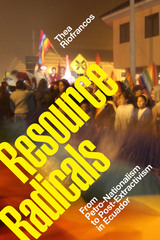 Resource Radicals: From Petro-Nationalism to Post-Extractivism in Ecuador
Thea Riofrancos
Duke University Press, 2020 In 2007, the left came to power in Ecuador. In the years that followed, the “twenty-first-century socialist” government and a coalition of grassroots activists came to blows over the extraction of natural resources. Each side declared the other a perversion of leftism and the principles of socioeconomic equality, popular empowerment, and anti-imperialism. In Resource Radicals, Thea Riofrancos unpacks the conflict between these two leftisms: on the one hand, the administration's resource nationalism and focus on economic development; and on the other, the anti-extractivism of grassroots activists who condemned the government's disregard for nature and indigenous communities. In this archival and ethnographic study, Riofrancos expands the study of resource politics by decentering state resource policy and locating it in a field of political struggle populated by actors with conflicting visions of resource extraction. She demonstrates how Ecuador's commodity-dependent economy and history of indigenous uprisings offer a unique opportunity to understand development, democracy, and the ecological foundations of global capitalism.
Resources for our Future: Key Issues and Best Practices in Resource Efficiency
Edited by Rob Weterings et al.
Amsterdam University Press, 2013 Compiling years of research into the geopolitical, economic, and ecological dimensions of material scarcity and resource efficiency, Resources for our Future provides a concise analysis of international resource efficiency. Offering an inspiring account of industrial best practices, the editors have put together a broad range of case studies, which focus on the chemical, textile, and food industries.
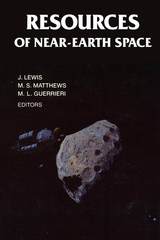 Resources of Near-Earth Space
John S. Lewis
University of Arizona Press, 1993 Originally published in 1993 From the original publication: A base on the Moon, an expedition to Mars. . . . Some time in the near future, for scientific or cultural reasons, humanity will likely decide to pursue one of these fantastic ventures in space. How can we increase the scope and reduce the cost of these ambitious activities?
The parts of the solar system that are most accessible from Earth—the Moon, the near-Earth asteroids, Mars and its moons—are rich in materials of great potential value to humanity. Resources of Near-Earth Space explores the possibilities both of utilizing these materials to produce propellants, structural metals, refractories, life-support fluids, and other materials on site to reduce the costs of space exploration, and of providing a source of materials and energy for our own planet that would not be environmentally destructive to Earth.This volume summarizes the present state of the art in attempts to realize these possibilities: identifying the resources, mining and processing, transportation, and economics. As a broad survey of a rapidly evolving field, it is intended as a technical introduction to the use of nonterrestrial materials for scientists, engineers, and industrial and governmental project managers who seek to make space more accessible.
 Resources under Regimes: Technology, Environment, and the State
Paul R. Josephson
Harvard University Press, 2005 Democratic or authoritarian, every society needs clean air and water; every state must manage its wildlife and natural resources. In this provocative, comparative study, Paul R. Josephson asks to what extent the form of a government and its economy--centrally planned or market, colonial or post-colonial--determines how politicians, bureaucrats, scientists, engineers, and industrialists address environmental and social problems presented by the transformation of nature into a humanized landscape.
Looking at the experiences of the industrialized and industrializing world, Resources under Regimes explores the relationship between science, technology, and the environment. Josephson considers global responses to deforestation, water pollution, and global warming, showing how different societies bring different values and assumptions to bear on the same problem, and arrive at different conclusions about the ideal outcome and the best way of achieving it. He reveals the important ways in which modern governments facilitate power generation, transportation, water production, and other technologies that improve the quality of life; and the equally critical ways in which they respond to the resulting depredations--the pollution, waste, and depletion that constitute the global environmental crisis at the beginning of the twenty-first century.
Resources, Values, and Development: Expanded Edition
Amartya Sen
Harvard University Press, 1997 Resources, Values and Development contains many of Amartya Sen's path-breaking contributions to development economics, including papers on resource allocation in nonwage systems, investment planning, shadow pricing, employment policy, and welfare economics.
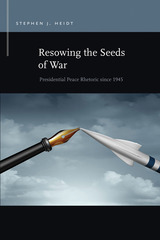 Resowing the Seeds of War: Presidential Peace Rhetoric since 1945
Stephen J. Heidt
Michigan State University Press, 2021 Ending a war, as Fred Charles Iklé wrote, poses a much greater challenge than beginning one. In addition to issues related to battle tactics, prisoners of war, diplomatic relations, and cease-fire negotiations, ending war involves domestic political calculations. Balancing the tides of public opinion versus policy needs poses a deep and enduring problem for presidents. In a first-of-its-kind study, Resowing the Seeds of War explains how Presidents Truman, Eisenhower, Nixon, and Obama managed the political, policy, and bureaucratic challenges that arise at the end of war via a series of rhetorical choices that reframe, modify, or unravel depictions of national enemies, the cause of the conflict, and the stakes for the nation and world. This end-of-war rhetoric justifies ending hostilities, rationalizes postwar national policy, argues for the construction of postwar security arrangements, and often sustains public support for massive financial investment in reconstruction. By tracking presidential manipulations of savage imagery from World War II to the War on Terror, this book concludes that even as metaphoric reframing facilitates exit from conflict, it incurs unexpected consequences that make national involvement in the next conflict more likely.
Respawn: Gamers, Hackers, and Technogenic Life
Colin Milburn
Duke University Press, 2018 In Respawn Colin Milburn examines the connections between video games, hacking, and science fiction that galvanize technological activism and technological communities. Discussing a wide range of games, from Portal and Final Fantasy VII to Super Mario Sunshine and Shadow of the Colossus, Milburn illustrates how they impact the lives of gamers and non-gamers alike. They also serve as resources for critique, resistance, and insurgency, offering a space for players and hacktivist groups such as Anonymous to challenge obstinate systems and experiment with alternative futures. Providing an essential walkthrough guide to our digital culture and its high-tech controversies, Milburn shows how games and playable media spawn new modes of engagement in a computerized world.
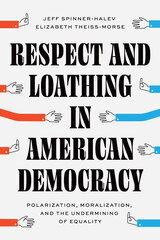 Respect and Loathing in American Democracy: Polarization, Moralization, and the Undermining of Equality
Jeff Spinner-Halev and Elizabeth Theiss-Morse
University of Chicago Press, 2024 A deep examination of why respect is in short supply in politics today and why it matters. Respect is in trouble in the United States. Many Americans believe respecting others is a necessary virtue, yet many struggle to respect opposing partisans. Surprisingly, it is liberal citizens, who hold respect as central to their view of democratic equality, who often have difficulty granting respect to others. Drawing on evidence from national surveys, focus groups, survey experiments, and the views of political theorists, Jeff Spinner-Halev and Elizabeth Theiss-Morse explain why this is and why respect is vital to—and yet so lacking in—contemporary US politics. Respect and Loathing in American Democracy argues that liberals and conservatives are less divided than many believe, but alienate one another because they moralize different issues. Liberals moralize social justice, conservatives champion national solidarity, and this worldview divide keeps them at odds. Respect is both far-reaching and vital, yet it is much harder to grant than many recognize, partly because of the unseen tension between respect, social justice, and national solidarity. Respect and Loathing in American Democracy proposes a path forward that, while challenging, is far from impossible for citizens to traverse.
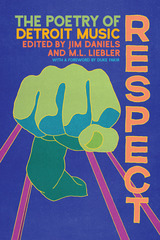 RESPECT: The Poetry of Detroit Music
Jim Daniels
Michigan State University Press, 2019 While there have been countless books written about Detroit, none have captured its incredible musical history like this one. This collection of poems and lyrics covers numerous genres including jazz, blues, doo-wop, Motown, classic rock, punk, hip-hop, and techno. Detroit artists have forged the paths in many of these genres, producing waves of creative energy that continue to reverberate across the country and around the world. While documenting and celebrating this part of Detroit’s history, this book captures the emotions that the music inspired in its creators and in its listeners. The range of contributors speaks to the global impact of Detroit’s music scene—Grammy winners, Pulitzer Prize winners, Rock and Roll Hall of Fame inductees, and poet laureates all come together in this rich and varied anthology, including such icons as Eminem, June Jordan, Fred “Sonic” Smith, Rita Dove, Jack White, Robbie Robertson, Paul Simon, Nikki Giovanni, Philip Levine, Sasha Frere-Jones, Patricia Smith, Billy Bragg, Andrei Codrescu, Toi Derricotte, and Cornelius Eady.
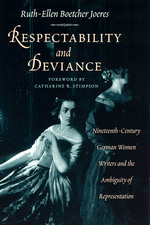 Respectability and Deviance: Nineteenth-Century German Women Writers and the Ambiguity of Representation
Ruth-Ellen Boetcher Joeres
University of Chicago Press, 1998 The first major study in English of nineteenth-century German women writers, this book examines their social and cultural milieu along with the layers of interpretation and representation that inform their writing.
Studying a period of German literary history that has been largely ignored by modern readers, Ruth-Ellen Boetcher Joeres demonstrates that these writings offer intriguing opportunities to examine such critical topics as canon formation; the relationship between gender, class, and popular culture; and women, professionalism, and technology. The writers she explores range from Annette von Droste-Hülshoff, who managed to work her way into the German canon, to the popular serial novelist E. Marlitt, from liberal writers such as Louise Otto and Fanny Lewald, to the virtually unknown novelist and journalist Claire von Glümer. Through this investigation, Boetcher Joeres finds ambiguities, compromises, and subversions in these texts that offer an extensive and informative look at the exciting and transformative epoch that so much shaped our own.
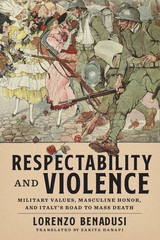 Respectability and Violence: Military Values, Masculine Honor, and Italy’s Road to Mass Death
Lorenzo Benadusi
University of Wisconsin Press, 2021 In the aftermath of national unification in the 1860s, the Italian army was tasked with molding generations of men from warring regions and different social strata into obedient citizens of a centralized state. Integrating large numbers of the educated middle classes into the young kingdom’s armed forces proved decisive in establishing the army as the “main school” and backbone for mass nationalization. Lorenzo Benadusi examines the intersection of Italian military and civil society over the last century as they coalesced in the figure of the gentleman-officer—an idealized image of an altruistic, charming, and competent ruling class that could influence the choices, values, and behavior of the “new Italians.” Respectability and Violence traces the relationship between civic virtues and military values from the post-Risorgimento period through the end of World War I, when the trauma of trench warfare made it necessary to again redefine ideas of chivalry and manliness and to accept violence as a necessary tool in defense of society and state. The language of conflict and attitudes about war forged in these decades—characterized by patriotism, heroism, and sacrifice—shaped the cultured bourgeoise into loyalists who ushered in Italy’s transition to a powerful Fascist political system. This unique study of the officer is crucial for understanding the military, social, and political history of Italy.
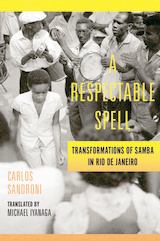 A Respectable Spell: Transformations of Samba in Rio de Janeiro
Carlos Sandroni
University of Illinois Press, 2021 A landmark in Brazilian music scholarship, A Respectable Spell introduces English-speaking readers to the rich history of samba from its nineteenth century origins to its emergence as a distinctive genre in the 1930s. Merging storytelling with theory, Carlos Sandroni profiles performers, composers, and others while analyzing the complex ideologies their music can communicate in their lyrics and rhythms, and how the meaning of songs and musical genres can vary depending on social and historical context. He also delves into lundu, modinha, maxixe, and many other genres of Brazilian music; presents the little-heard voices and perspectives of marginalized Brazilians like the African-descended sambistas; and presents a study in step with the types of decolonial approaches to ethnomusicology that have since emerged, treating the people being studied not only as makers of music but also of knowledge. Incisive and comprehensive, A Respectable Spell tells the compelling story of an iconic Brazilian musical genre.
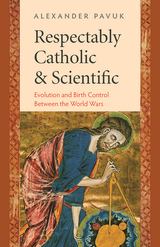 Respectably Catholic and Scientific: Evolution and Birth Control Between the World Wars
Alexander Pavuk
Catholic University of America Press, 2021 Respectfully Catholic and Scientific traces the unexpected manner in which several influential liberal-progressive Catholics tried to shape how evolution and birth control were framed and debated in the public square in the era between the World Wars-- and the unintended consequences of their efforts.
A small but influential cadre of Catholic priests professionally trained in social sciences, Frs. John Montgomery Cooper, John A. Ryan, and John A. O’Brien, gained a hearing from mainline public intellectuals largely by engaging in dialogue on these topics using the lingua franca of the age, science, to the near exclusion of religious argumentation.
The Catholics’ approach was more than just tactical. It also derived from the subtle influence of Catholic theological Modernism, with its strong enthusiasm for science, and from an inclination toward scientism inherited from the Progressive Era’s social science milieu.
All three shared a fervent desire to translate the Catholic ethos, as they understood it, into the vocabulary of the modern age while circumventing anti-Catholic attitudes in the process. However, their method resulted in a series of unintended consequences whereby their arguments were not infrequently co-opted and used against both them and the institutional church they served.
Alexander Pavuk considers the complex role of both liberal religious figures and scientific elites in evolution and birth control discourse, and how each contributed in unexpected ways to the reconstruction of those topics in public culture. The reconstruction saw the topics themselves shift from matters considered largely within moral frameworks into bodies of kno
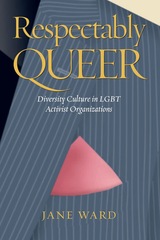 Respectably Queer: Diversity Culture in LGBT Activist Organizations
Jane Ward
Vanderbilt University Press, 2008 For three years the author did participant-observation at three nationally prominent queer organizations in Los Angeles-Christopher Street West, which produces L.A.'s queer pride festival; the Los Angeles Gay and Lesbian Center, a 37-year-old multi-site organization; and Bienestar, an HIV services organization for gay Latinos. Ward documents the evolution of these organizations, including class and race conflicts within them, but she especially focuses on the misuses of diversity culture. Respectably Queer reveals how neoliberal ideas about difference are becoming embedded in the daily life of a progressive movement and producing frequent conflicts over the meaning of "diversity." The author shows how queer activists are learning from the corporate model to leverage their differences to compete with other non-profit groups, enhance their public reputation or moral standing, and establish their diversity-related expertise. Ward argues that this instrumentalization of diversity has increased the demand for predictable and easily measurable forms of difference, a trend at odds with queer resistance. Ward traces the standoff between the respectable world of "diversity awareness" and the often vulgar, sexualized, and historically unprofessional world of queer pride festivals. She spotlights dissenting voices in a queer organization where diversity has become synonymous with tedious and superficial workplace training. And she shows how activists fight back when prevailing diversity discourses-the ones that "diverse" people are compelled to use in order to receive funding-simply don't fit.
Respecting Patient Autonomy
Benjamin H. Levi
University of Illinois Press, 1999 Against a backdrop of real clinical situations, Benjamin H. Levi examines the dynamics that shape relations between patient and health care provider, addressing fundamental questions about how medical decisions should be reached and compelling the reader to think about health care issues and decisions in terms of the values and goals they promote.
Presenting bioethics as a practical, educational activity rather than an abstract intellectual exercise, this important volume shows how dialogue between patients and health care providers can clarify both medical and ethical issues, promoting patient autonomy and advancing health care.
 Respecting the Wicked Child: A Philosophy of Secular Jewish Identity and Education
Mitchell Silver
University of Massachusetts Press, 1998 This book provides a philosophical rationale for maintaining a Jewish identity and explains how this can be done without compromising one's liberal or secular values. Mitchell Silver believes that many third- and fourth-generation American Jews have retained only a hazy knowledge of their ethnic traditions and rich history. But as they watch their own children grow up in a materialist, multicultural, Christian-dominated American society, many contemporary Jewish parents are loathe to abandon their distinctive heritage and wish to pass it on to their offspring. Silver begins by situating the possible emergence of a secular American Judaism within the context of attempts to reconcile the imperatives of tradition and modernity. He then proposes specific spiritual, moral, and institutional pathways that could lead to this reconceived form of Judaism. While the book's emphasis is on the possibilities and values of a secular American Jewish identity, Silver also proposes a supplemental school curriculum for children that would lay the groundwork for a viable contemporary Judaism.
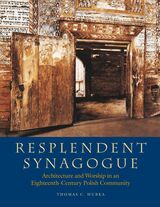 Resplendent Synagogue: Architecture and Worship in an Eighteenth-Century Polish Community
Thomas C. Hubka
Brandeis University Press, 2022 This unique exploration of a lost religious and cultural artifact breathes new life into a forgotten but fascinating aspect of eighteenth-century Polish Jewry.
Thomas C. Hubka, an architectural historian, immersed himself in medieval and early modern Jewish history, religion, and culture to prepare for this remarkable study of the eighteenth-century Polish synagogue in the town of Gwozdziec, now in present-day Ukraine. Because the Gwozdziec Synagogue, like so many others, was destroyed by the Nazis, this book revives a spiritual community lost to history. Hubka selected the Gwozdziec Synagogue because of the completeness of its photographic and historical records. Graced with nearly two hundred historical photographs, architectural drawings, maps, diagrams, and color illustrations, Resplendent Synagogue vividly recreates the spiritual heart of a once-vibrant Jewish population. Hubka demonstrates that while the architectural exterior of the synagogue was largely the product of non-Jewish, regional influences, the interior design and elaborate wall-paintings signified a distinctly Jewish art form. The collaboration of Jewish and Gentile builders, craftsmen, and artists in the creation of this magnificent wooden structure attests to an eighteenth-century period of relative prosperity and communal well-being for the Jews of Gwozdziec. Part of a tradition that was later abandoned by Eastern European Jewish communities in the nineteenth and twentieth centuries, this truly resplendent synagogue exemplified a high point in Jewish architectural art and religious painting.
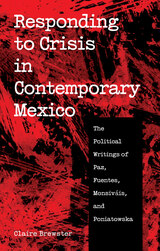 Responding to Crisis in Contemporary Mexico: The Political Writings of Paz, Fuentes, Monsiváis, and Poniatowska
Claire Brewster
University of Arizona Press, 2005 Regarded as among modern Mexico’s foremost creative writers, Octavio Paz, Carlos Fuentes, Carlos Monsiváis, and Elena Poniatowska are also esteemed as analyzers of society, critics of public officials, and both molders and mirrors of public opinion. This book offers a reading of Mexican current affairs from 1968 to 1995 through a comparative study of these four writers’ political work. In hundreds of articles, essays, and comments published in the Mexican press—Excélsior, La Cultura en México, La Jornada, Proceso, and many other publications—these writers tackled current affairs as events unfolded. Yet the lack of detailed examination of their contributions in the press has left a gap in our understanding of their vital role in raising awareness of national concerns as they were happening.
Claire Brewster has mined direct quotations from a host of publications to illustrate the techniques that they used in combating government and editorial restraints. Brewster first addresses the Student Movement of 1968—the violent suppression of which was a watershed in the relationship between the Mexican government and people—and illustrates the ways in which the student crisis affected the writers’ relationships with presidents Luis Echeverría Alvarez and José López Portillo. She next considers the profound social and political repercussions of the 1985 earthquake as described by Poniatowska and Monsiváis and the consequent emergence of Mexican civil society. She then outlines Paz’s and Monsiváis’s vociferous responses to the 1988 presidential election campaigns and their highly contentious result, and lastly she examines the Chiapas rebellion from January to July 1994.
The eloquent Zapatista spokesman, Subcomandante Marcos, challenged Mexican writers to a duel of words, and Brewster analyzes the ways in which the four writers took up the gauntlet—and in so doing reveals the development of their political thoughts and their relationships with the Mexican people and the federal government. The work of these four authors charts an important historical era, and a close examination of their essays reveals their maturation as writers and provides an understanding of the development of Mexican society. By bringing their opinions and attitudes to light, Brewster unearths a rich lode of insight into the inner workings of Mexican intellectuals and invites observers of contemporary Mexico to reconsider their role in reflecting social change.
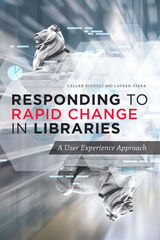 Responding to Rapid Change in Libraries: A User Experience Approach
Lauren Stara and Callan Bignoli
American Library Association, 2020 In the face of rapid change and an ever-widening constellation of challenges, it’s crucial for library leaders to pull back to the question of “why?” Plotting a sustainable way forward depends upon recommitting ourselves to our underlying values, such as customer service and community-building, while fostering the improvements that change makes possible. With passion, patience, and fortitude, libraries can stride confidently into the future. In this book, noted speakers and consultants Bignoli and Stara speak directly to library directors, managers, administrators, and technology staff, offering concrete guidance on setting or resetting strategic priorities. Taking an interconnected and specific approach to planning for and strengthening the library environment as a whole, their book - discusses why libraries should embrace change as a fundamental part of library life;
- explores how to harness rapid change to provide more responsive, user-centered library service;
- addresses the ways in which libraries straddle the physical and the digital, in areas such as service provision and collections, illuminating how they overlap and can be improved using similar philosophies;
- presents both a comprehensive overview of library technologies as well as related team and change management advice, all grounded in user experience principles;
- shows how the concepts of sustainability and flexibility apply to physical space planning and design, from furniture selection and arrangement to infrastructure; and
- provides sound guidance on project management, problem solving, preparing for future challenges, personal reflection and self-care, and other leadership topics.
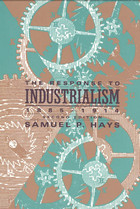 The Response to Industrialism, 1885-1914
Samuel P. Hays
University of Chicago Press, 1995 In this new edition, Samuel P. Hays expands the scope of his pioneering account of the ways in which Americans reacted to industrialism during its early years from 1885 to 1914. Hays now deepens his coverage of cultural transformations in a study well known for its concise treatment of political and economic movements.
Hays draws on the vast knowledge of America's urban and social history that has been developed over the last thirty-eight years to make the second edition an unusually well-rounded study. He enhances the original coverage of politics, labor, and business with new accounts of the growth of cities, the rise of modern values, cultural conflicts with Native Americans and foreign nations, and changing roles for women, African-Americans, education, religion, medicine, law, and leisure. The result is a tightly woven portrait of America in transition that underscores the effects of impersonal market forces and greater personal freedom on individuals and chronicles such changes as the rise of social inequality, shifting power, in the legal system, the expansion of the federal government, and the formation of the Populist, Progressive, and Socialist parties.
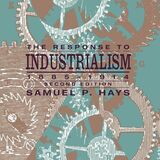 The Response to Industrialism, 1885-1914
Samuel P. Hays
University of Chicago Press, 1995 This is an auto-narrated audiobook version of this book.
In this new edition, Samuel P. Hays expands the scope of his pioneering account of the ways in which Americans reacted to industrialism during its early years from 1885 to 1914. Hays now deepens his coverage of cultural transformations in a study well known for its concise treatment of political and economic movements.
Hays draws on the vast knowledge of America's urban and social history that has been developed over the last thirty-eight years to make the second edition an unusually well-rounded study. He enhances the original coverage of politics, labor, and business with new accounts of the growth of cities, the rise of modern values, cultural conflicts with Native Americans and foreign nations, and changing roles for women, African-Americans, education, religion, medicine, law, and leisure. The result is a tightly woven portrait of America in transition that underscores the effects of impersonal market forces and greater personal freedom on individuals and chronicles such changes as the rise of social inequality, shifting power, in the legal system, the expansion of the federal government, and the formation of the Populist, Progressive, and Socialist parties.
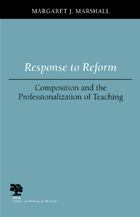 Response to Reform: Composition and the Professionalization of Teaching
Margaret J. Marshall
Southern Illinois University Press, 2003 Response to Reform: Composition and the Professionalization of Teaching critiques the politics of labor and gender biases inherent in the composition workplace that prevent literacy teachers from attaining professional status and respect. Scrutinizing the relationship between scholarship and teaching, Margaret J. Marshall calls for a reconceptualization of what it means to prepare for and enter the field of composition instruction. Interrogating the approach the education system takes to certify teachers without actually “professionalizing” their careers, Marshall contends that these programs rely on outdated rhetorics of labor that only widen the gap between teaching and other professional jobs. Such attempts to re-educate literacy teachers exploit and marginalize their work, and thus prevent them from claiming the status of academic professionals. In providing an overview of the history of and language used to literacy instruction, she also points out that while women are overrepresented in composition instruction, they are underrepresented in tenure track and administrative positions. To correct and combat these inequities, Marshall advocates an alternate alignment of power structures and rhetorical choices. In a wide-ranging survey that sheds new light on the composition workplace as well as higher education at large, Response to Reform: Composition and the Professionalization of Teaching boldly asks us to do away with the reductive language we inherit from the past that characterize teaching and professionalization, as well as our customary responses to public criticism of education. The result is a new articulation of composition as a meritorious profession.
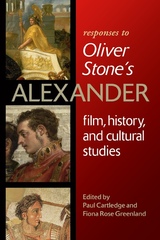 Responses to Oliver Stone’s Alexander: Film, History, and Cultural Studies
Edited by Paul Cartledge and Fiona Rose Greenland; Afterword by Oliver Stone
University of Wisconsin Press, 2009 The charismatic Alexander the Great of Macedon (356–323 B.C.E.) was one of the most successful military commanders in history, conquering Asia Minor, Egypt, Persia, central Asia, and the lands beyond as far as Pakistan and India. Alexander has been, over the course of two millennia since his death at the age of thirty-two, the central figure in histories, legends, songs, novels, biographies, and, most recently, films. In 2004 director Oliver Stone’s epic film Alexander generated a renewed interest in Alexander the Great and his companions, surroundings, and accomplishments, but the critical response to the film offers a fascinating lesson in the contentious dialogue between historiography and modern entertainment.
This volume brings together an intriguing mix of leading scholars in Macedonian and Greek history, Persian culture, film studies, classical literature, and archaeology—including some who were advisors for the film—and includes an afterword by Oliver Stone discussing the challenges he faced in putting Alexander’s life on the big screen. The contributors scrutinize Stone’s project from its inception and design to its production and reception, considering such questions as: Can a film about Alexander (and similar figures from history) be both entertaining and historically sound? How do the goals of screenwriters and directors differ from those of historians? How do Alexander’s personal relationships—with his mother Olympias, his wife Roxane, his lover Hephaistion, and others—affect modern perceptions of Alexander? Several of the contributors also explore reasons behind the film’s tepid response at the box office and subsequent controversies.
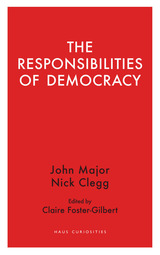 The Responsibilities of Democracy
John Major and Nick Clegg
Haus Publishing, 2019 Democracy operates on consent. That means politicians have an obligation to present and argue their causes in order to ultimately win consensus. Above all, democracy requires honesty—in facing up to challenges, acknowledging fears and dangers, and admitting the limitations of government. But democracy has its flaws, not least in the lack of efficiency in the decision-making process.
Amid pressing questions about the nature and limits of democracy, both in Britain and beyond, The Responsibilities of Democracy provides a clear-eyed perspective shared by two former politicians. Two central figures of the British political establishment, John Major and Nick Clegg, share their thoughts on where democracy is heading and how it can survive in the twenty-first century. Offering his perspective as a former prime minister, Major writes of the qualities on which a healthy democracy depends and expresses his deep concerns about the declining decorum of political exchange. Clegg brings a counter-perspective in discussing the ways in which political language has always involved trading insults and argues that echo chambers, although now more sophisticated, are nothing new. Compromise, Clegg insists, is not betrayal, but is instead the very substance of our politics and our democracy. The Responsibilities of Democracy explores the overall health of UK democracy, giving a balanced analysis of its values and flaws. It is also a clarion call to the electorate and politicians to nurture and protect the precious values on which democracy depends.
Responsibility and the Moral Sentiments
R. Jay Wallace
Harvard University Press, 1998 R. Jay Wallace advances a powerful and sustained argument against the common view that accountability requires freedom of will. Instead, he maintains, the fairness of holding people responsible depends on their rational competence: the power to grasp moral reasons and to control their behavior accordingly. He shows how these forms of rational competence are compatible with determinism. At the same time, giving serious consideration to incompatibilist concerns, Wallace develops a compelling diagnosis of the common assumption that freedom is necessary for responsibility.
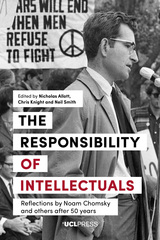 Responsibility of Intellectuals: Reflections by Noam Chomsky and Others after 50 years
Edited by Nicholas Allott, Chris Knight, and Neil Smith
University College London, 2019 With the publication of “The Responsibility of Intellectuals,” Noam Chomsky burst onto the US political scene as a leading critic of the war in Vietnam. Privilege, he argues, brings with it the responsibility to tell the truth and expose lies, but our intellectual culture only pays lip service to this ideal. The essay has been described as the “single most influential piece of anti-war literature” of the Vietnam war period. Since then, Chomsky has continued to equip a growing international audience with the facts and arguments needed to understand—and change—our world. According to the New York Times, Chomsky “may be the most widely read American voice on foreign policy on the planet today.”
This book revisits “The Responsibility of Intellectuals” half a century later. It includes six new essays written to celebrate Chomsky’s famous intervention and explore its relevance in today’s world. Nicholas Allott, Chris Knight, Milan Rai, and Neil Smith have studied and written about Chomsky’s thought for many years, while Craig Murray and Jackie Walker describe the personal price they have paid for speaking out. The book concludes with Chomsky’s recollections of the background to the original publication of his essay, followed by extensive commentary from him on its fiftieth anniversary.
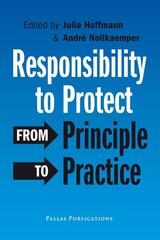 Responsibility to Protect: From Principle to Practice
Edited by Julia Hoffmann and André Nollkaemper
Amsterdam University Press, 2012 The tragic events in the 1990s in Rwanda, Srebrenica and Kosovo, and the crisis in Libya in 2011 have triggered a fundamental rethinking of the role and responsibility of the international community. It is now accepted that while individual states continue to bear the primary responsibility to protect their populations against genocide, ethnic cleansing, crimes against humanity and war crimes within their boundaries, the international community should step in when the state is unable or unwilling to provide such protection. The principle of the Responsibility to Protect, or RtoP, reflects this recognition, and provides the normative basis for involvement of the international community in cases of mass atrocities.
This thoughtful work is a major contribution towards clarifying what RtoP can offer, moving from principle to practice. It spans the disciplines of international law, international relations, and moral philosophy.
Responsible Bureaucracy: A Study of the Swiss Civil Service
Carl J. Friedrich and Taylor Cole
Harvard University Press In presenting a systematic concept of bureaucracy, the authors have made an analysis which involves, among other matters, the question of the supposed antithesis between bureaucracy and responsible government. The particular bureaucracy analyzed is that of Switzerland, consideration being given to matters of internal organization, personnel, and the explanation and extent of the syndicalist movement in the Swiss public service. The volume presents a real basis upon which comparative analysis must rest. It will be found unusually valuable by teachers of political science and students of European political institutions.
 The Responsible Contract Manager: Protecting the Public Interest in an Outsourced World
Steven Cohen and William Eimicke
Georgetown University Press, 2008 Contract management is a critical skill for all contemporary public managers. As more government duties are contracted out, managers must learn to coordinate and measure the performance of private contractors, and to write contract requirements and elicit bids that obtain important services and products at the best possible price and quality. They must also learn to work in teams that include both public and private sector partners. The Responsible Contract Manager delves into the issues of how to ensure that the work done by private sector contractors serves the public interest and argues for the necessity of making these organizations act as extensions of the public sector while maintaining their private character. Government contract managers have a unique burden because they must develop practices that ensure the production advantages of networked organizations and the transparency and accountability required of the public sector. The Responsible Contract Manager fills a major gap in public management literature by providing a clear and practical introduction to the best practices of contract management and also includes a discussion of public ethics, governance and representation theory. It is an essential guide for all public management scholars and is especially useful for students in MPA graduate programs and related fields.
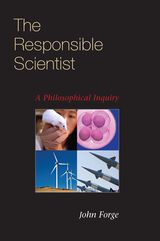 The Responsible Scientist: A Philosophical Inquiry
John Forge
University of Pittsburgh Press, 2008 When Fat Boy, the first atomic bomb was detonated at Los Alamos, New Mexico in 1945, moral responsibility in science was forever thrust into the forefront of philosophical debate. The culmination of the famed Manhattan Project, which employed many of the world's best scientific minds, was a singular event that signaled a new age of science for power and profit and the monumental responsibility that these actions entailed.
Today, the drive for technological advances in areas such as pharmaceuticals, biosciences, communications, and the defense industry channels the vast majority of scientific endeavor into applied research. In The Responsible Scientist, John Forge examines the challenges of social, moral, and legal responsibility faced by today's scientists. Focusing on moral responsibility, Forge argues that scientists have a responsibility not to do work that has harmful outcomes and that they are encouraged to do work that prevents harm. Scientists also have a backward-looking responsibility, whereby they must prevent wrongful outcomes and omissions that they are in a position to foresee.
Forge presents a broad overview of many areas of scientific endeavor, citing the responsibility of corporations, employees, and groups of scientists as judged by the values of science and society's appraisals of actions and outcomes. He maintains that ultimate responsibility lies in the hands of the individual-the responsible scientist-who must exhibit the diligence and foresight to anticipate the use and abuse of his or her work.
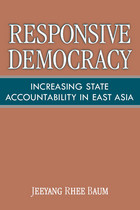 Responsive Democracy: Increasing State Accountability in East Asia
Jeeyang Rhee Baum
University of Michigan Press, 2011 "Responsive Democracy is a pioneering contribution to the political analysis of administrative law in East Asia. Both political scientists and legal academics will greatly benefit from the author's in-depth analysis of the intersection between presidential power and administrative law in the contrasting cases of South Korea, Taiwan, and the Philippines."
---Susan Rose-Ackerman, Yale University Law School "Baum's book is a very significant contribution because it focuses on a part of the world that has often been neglected in studies of democratization. It focuses attention on the nuts and bolts of what we mean by democratic consolidation and responsiveness. Indeed, if more political science were written with this clarity, we would all enjoy reading the literature much more!"
---Joseph Fewsmith, Boston University Under what conditions is a newly democratic government likely to increase transparency, accountability, and responsiveness to its citizens? What incentives might there be for bureaucrats, including those appointed by a previously authoritarian government, to carry out the wishes of an emerging democratic regime? Responsive Democracy addresses an important problem in democratic transition and consolidation: the ability of the chief executive to control the state bureaucracy. Using three well-chosen case studies---the Philippines, South Korea, and Taiwan---Jeeyang Rhee Baum explores the causes and consequences of codifying rules and procedures in a newly democratic government. In the Philippines, a president facing opposition has the option of appointing and dismissing officials at will and, therefore, has no need for administrative procedure acts. However, in South Korea and Taiwan, presidents employ such legislation to rein in recalcitrant government agencies, and, as a consequence, increase transparency, accountability, and responsiveness. Moreover, as Baum demonstrates by drawing upon surveys conducted both before and after implementation, administrative procedural reforms in South Korea and Taiwan improved public confidence in and attitudes toward democratic institutions. Jeeyang Rhee Baum is a Research Fellow at the Ash Center for Democratic Governance and Innovation, John F. Kennedy School of Government, Harvard University.
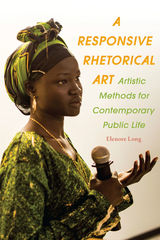 A Responsive Rhetorical Art: Artistic Methods for Contemporary Public Life
Elenore Long
University of Pittsburgh Press, 2018 A Responsive Rhetorical Art explores the risk-ridden realm of wise if always also fallible rhetorical action—the productive knowledge building required to compose and to leverage texts, broadly construed, for the purposes of public life marked by shrinking public resources, cultural conflict, and deferred hope. Here, composition and literacy learning hold an important and distinctive cultural promise: the capacity to invent with other people new ways forward in light of their own interests and values and in the face of obstacles that could not have otherwise been predicted. Distributed across publicly situated strangers, including citizen-educators, this work engages a persistent challenge of early rhetorical uptake in public life: that what might become public and shared is often tacit and contested. The book’s approach combines attention to local cases (with a transnational student organization, the Nipmuck Chaubunagungamaug, and the South Sudanese diaspora in Phoenix) with a revisable guide for taking up wise action and methods for uncovering elusive institutional logics.
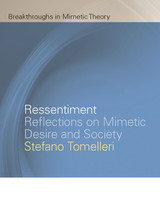 Ressentiment: Reflections on Mimetic Desire and Society
Stefano Tomelleri
Michigan State University Press, 2015 This book is a response to Friedrich Nietzsche’s provocative question: How much and how does ressentiment condition our daily life? During the twentieth century we witnessed veritable eruptions of this insidious emotion, and we are still witnesses of its proliferation at various levels of society. This book aims to explore, according to René Girard’s mimetic theory, the anthropological and social assumptions that make up ressentiment and to investigate its genesis. The analysis of ressentiment shows that this emotion evolves from mimetic desire: it is an affective experience that people have when a rival denies them opportunities or valuable resources (including status) that they consider to be socially accessible. It is a specific figure of mimetic desire that is typical of contemporary society, where the equality that is proclaimed at the level of values contrasts with striking inequalities of power and access to material resources. This dichotomy generates increasing tension between highly competitive and egalitarian mimetic desires and growing social inequalities. The ressentiment is ambiguous, and its ambiguity is that of mimetic desire itself, which we cannot dismiss from our lives. In that it provides occasions of conflict and baseness, ressentiment can fuel violence, discord, and injustice, but it also can open opportunities for growth and justice, and for inventing institutions that are better adapted to the transformations of our contemporary society.
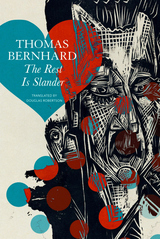 The Rest Is Slander: Five Stories
Thomas Bernhard
Seagull Books, 2022 A collection of previously untranslated stories from a master of twentieth-century Austrian literature, Thomas Bernhard.
“The cold increases with the clarity,” said Thomas Bernhard while accepting a major literary prize in 1965. That clarity was the postwar realization that the West’s last remaining cultural reference points were being swept away by the ever-greater commodification of humankind. Collecting five stylistically transitional tales by Bernhard, all of which take place in sites of extreme cold, this volume extends that bleak vision of the master Austrian storyteller.
In “Ungenach,” the reluctant heir of an enormous estate chooses to give away his legacy to an assortment of oddballs as he discovers the past of his older brother, who was murdered during a career in futile colonialist philanthropy. In “The Weatherproof Cape,” a lawyer tries to maintain a sense of familial solidarity with a now-dead client with the help of an unremarkable piece of clothing. “Midland in Stilfs” casts a jaundiced eye on the laughable efforts of a cosmopolitan foreigner to attain local authenticity on a moribund Alpine farmstead. In “At the Ortler,” two middle-aged brothers—one a scientist, the other an acrobat—meditate on their unusual career paths while they climb a mountain to reclaim a long-abandoned family property. And in “At the Timberline,” the unexpected arrival of a young couple in a mountain village leads to the discovery of a scandalous crime that casts a shadow on the personal life of the policeman investigating it.
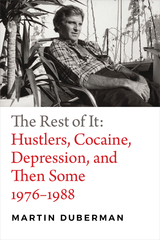 The Rest of It: Hustlers, Cocaine, Depression, and Then Some, 1976–1988
Martin Duberman
Duke University Press, 2018 For many, the death of a parent marks a low point in their personal lives. For Martin Duberman—a major historian and a founding figure in the history of gay and lesbian studies—the death of his mother was just the beginning of what became a twelve-year period filled with despair, drug addiction, and debauchery. From his cocaine use, massive heart attack, and immersion into New York's gay hustler scene to experiencing near-suicidal depression and attending rehab, The Rest of It is the previously untold and revealing story of how Duberman managed to survive his turbulent personal life while still playing leading roles in the gay community and the academy.
Despite the hardships, Duberman managed to be incredibly productive: he wrote his biography of Paul Robeson, rededicated himself to teaching, wrote plays, and coedited the prize-winning Hidden from History. His exploration of new paths of scholarship culminated in his founding of the Center for Lesbian and Gay Studies, thereby inaugurating a new academic discipline. At the outset of the HIV/AIDS epidemic Duberman increased his political activism, and in these pages he also describes the tensions between the New Left and gay organizers, as well as the profound homophobia that created the conditions for queer radical activism. Filled with gossip, featuring cameo appearances by luminaries such as Gore Vidal, Norman Mailer, Vivian Gornick, Susan Brownmiller, Kate Millett, and Néstor Almendros, among many others, and most importantly, written with an unflinching and fearless honesty, The Rest of It provides scathing insights into a troubling decade of both personal and political history. It is a stimulating look into a key period of Duberman's life, which until now had been too painful to share.
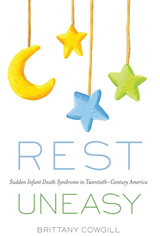 Rest Uneasy: Sudden Infant Death Syndrome in Twentieth-Century America
Cowgill, Brittany
Rutgers University Press, 2018 Tracing the Sudden Infant Death Syndrome (SIDS) diagnosis from its mid-century origins through the late 1900s, Rest Uneasy investigates the processes by which SIDS became both a discrete medical enigma and a source of social anxiety construed differently over time and according to varying perspectives. American medicine reinterpreted and reconceived of the problem of sudden infant death multiple times over the course of the twentieth century. Its various approaches linked sudden infant deaths to all kinds of different causes—biological, anatomical, environmental, and social. In the context of a nation increasingly skeptical, yet increasingly expectant, of medicine, Americans struggled to cope with the paradoxes of sudden infant death; they worked to admit their powerlessness to prevent SIDS even while they tried to overcome it. Brittany Cowgill chronicles and assesses Americans’ fraught but consequential efforts to explain and conquer SIDS, illuminating how and why SIDS has continued to cast a shadow over doctors and parents.
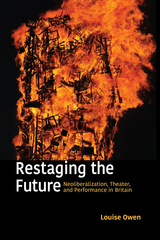 Restaging the Future: Neoliberalization, Theater, and Performance in Britain
Louise Owen
Northwestern University Press, 2023 An examination of neoliberal ideology’s ascendance in 1990s and 2000s British politics and society through its effect on state-supported performance practices
Post-Thatcher, British cultural politics were shaped by the government’s use of the arts in service of its own social and economic agenda. Restaging the Future: Neoliberalization, Theater, and Performance in Britain interrogates how arts practices and cultural institutions were enmeshed with the particular processes of neoliberalization mobilized at the end of the twentieth century and into the twenty-first.
Louise Owen traces the uneasy entanglement of performance with neoliberalism's marketization of social life. Focusing on this political moment, Owen guides readers through a wide range of performance works crossing multiple forms, genres, and spaces—from European dance tours, to Brazilian favelas, to the streets of Liverpool—attending to their distinct implications for the reenvisioned future in whose wake we now live.
Analyzing this array of participatory dance, film, music, public art, and theater projects, Owen uncovers unexpected affinities between community-based, experimental, and avant-garde movements. Restaging the Future provides key historical context for these performances, their negotiations of their political moment, and their themes of insecurity, identity, and inequality, created in a period of profound ideological and socioeconomic change.
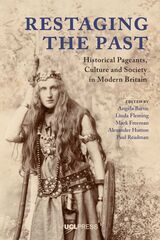 Restaging the Past: Historical Pageants, Culture and Society in Modern Britain
Edited by Angela Bartie, Linda Fleming, Mark Freeman, and Alexander Hutton
University College London, 2020 Restaging the Past is the first collection devoted to the study of pageants in Britain, ranging from their Edwardian origins to the present day. In the twentieth century, people all across Britain succumbed to “pageant fever.” Thousands of people dressed up in historical costumes and performed scenes from local history, and hundreds of thousands more watched them. These pageants were one of the most significant aspects of popular engagement with the past between 1900 and the 1970s: they took place in large cities, small towns, and tiny villages, and engaged a wide range of organizations and social groups, from Women’s Institutes to political parties, schools to churches, and even youth organizations.
Pageants were community events, bringing people together in a shared celebration and performance of the past; they also involved many prominent novelists, professional historians, and other writers, and as a result were featured repeatedly in popular and highbrow literature. Although the pageant tradition has largely died out, the contributors argue that it deserves to be acknowledged as a key aspect of community history during a period of great social and political change—and, they show, because of its former prominence, some lingering signs of “pageant fever” can still be seen in Britain today.
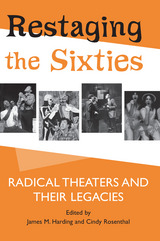 Restaging the Sixties: Radical Theaters and Their Legacies
Edited by James M. Harding and Cindy Rosenthal
University of Michigan Press, 2006 In the volatile period of the late sixties and early seventies, several theater groups came to prominence in the United States, informing and shaping activist theater as we know it today. Restaging the Sixties examines the artistry, politics, and legacies of eight radical collectives: the Living Theatre, the Open Theatre, the Performance Group, the San Francisco Mime Troupe, El Teatro Campesino, At the Foot of the Mountain, the Free Southern Theater, and Bread and Puppet Theater. Each of the specially commissioned essays is from a leading theater artist, critic, or scholar. The essays follow a three-part structure that first provides a historical overview of each group’s work, then an exploration of the group’s significant contributions to political theater, and finally, the legacy of those contributions.
The volume explores how creations such as the Living Theatre's Paradise Now and the Performance Group’s Dionysus in 69 overlapped with political interests that, in the late 1960s, highlighted the notion of social collectives as a radical alternative to mainstream society. Situating theatrical practice within this socio-political context, the book considers how radical theaters sought to redefine the relationship between theater and political activism, and how, as a result, they challenged the foundations of theater itself.
James M. Harding is Associate Professor of English at Mary Washington University. His other books include Not the Other Avant-Garde: The Transnational Foundations of Avant-Garde Performance.
Cindy Rosenthal is Associate Professor of Theatre Studies, Hofstra University.
“A useful introduction to an eclectic period of experimental theater, providing portraits of the major political theaters and engaging with new vigor many of the era’s familiar aesthetic and ideological concerns. The writers offer a provocative history of theater’s attraction to (and occasional anxiety over) activism.”
--Marc Robinson, Yale University
|
|
